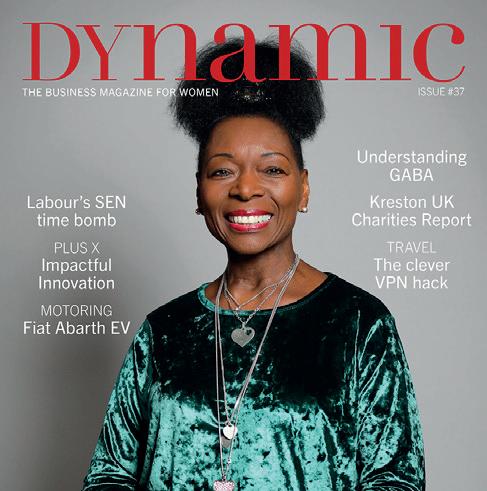




























We help turn your spark into reality.




Expert financial advice to ensure your future shines bright
Whether you’re looking for ideas on growing your money, planning for retirement or leaving a financial legacy for your loved ones, we’ll guide you with personalised financial planning and investment management, so you can look to the future with confidence.
Speak to us to find out how our ideas can help make your ideas a reality.





Contact our Royal Tunbridge Wells office to arrange an introductory meeting with Paul Cannons

Call 01892 739580 or email
paul.cannons@brewin.co.uk

brewin.co.uk/royal-tunbridge-wells


The value of investments can fall and you may get back less than you invested.

BIG STORY
28 Motor Neurone Disease
With former England rugby international Lewis Moody recently announcing his diagnosis of MND, Platinum seeks correlation between impact sports and neural health issues
NEWS
6 National news
A round up of important business stories from around the world
8 Local news
A look at the business news stories across the South East
EVENTS
20 Surrey Business Awards
This prestigious event, coming soon, is sold out. But do get in touch to join the waiting list!
38 Sussex Business Awards
All the finalists have now been revealed, and tickets are on sale –and selling fast!
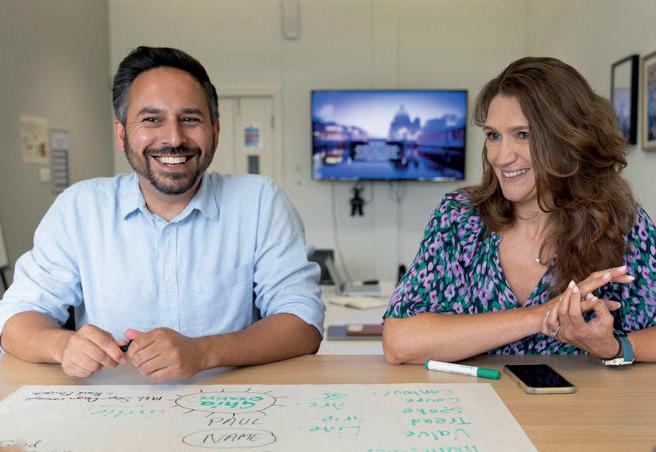
BUSINESS AWARDS 2026

44 Central South Business Awards 2026
Announcing next year’s premium event, with entries now open
BUSINESS
16 Jensten Insurance
How cyber insurance and trade credit can protect your business
22 Growth Animals Marketing
How your boring brand might be holding you back
34 MDHUB
Creating a hubbub at the awards
50 Base Insurance
Modernising business insurance
54 Cleankill
Trust your staff and never stop learning
LEGAL
18 Monan Gozzett
The dispute resolution experts
24 DMH Stallard
When to call a lawyer: early signs of a legal dispute
26 DMH Stallard Commentary
Can a growth plan deliver the right exit value?
42 Mayo Wynne Baxter
The hidden value in leasehold reform: why businesses should care
FINANCE
14 Kreston Reeves
How UK sustainability reporting standards will reshape SME success
46 Southover Wealth
Redefining financial guidance for a new generation
TRAVEL
56 Matera, Italy
Tess de Klerk discovers this amazing, cave-strewn, cliff-top town just above the heel of Italy, which was closed off for decades
60 ‘The Great Chinese Takeaway’ Maarten Hoffmann scours the Chinese EV industry, currently poised to flood European markets

“They


Banking
Corporate
Defamation
Information
Intellectual
Partnership,
Professional



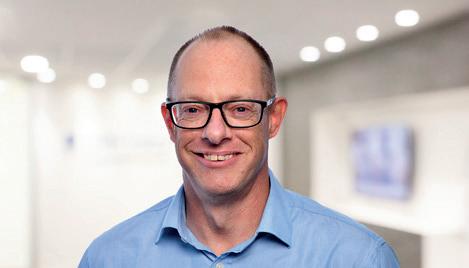
We are not quite sure where 2025 has gone as we seem to be on the inevitable countdown to Christmas! With only this November issue to go before we present you with the December issue, the year seems to have passed in a flash.
As usual, we present a wide range of stories, columns and news from across the South East, such as the Hubbub Awards that have recently taken place, why and when to look at cyber and trade insurance, when to call in a lawyer over a business dispute, and we look at the leasehold reforms.
The US and UK governments warn of spying issues with Chinese EVs and we present the top ten Chinese EVs available in the UK in Motoring, and Travel features the ancient beauty of Matera in Italy.
The Big Story features the England International Lewis Moody and his recent diagnosis following so much bad news from rugby and football players with head issues - will the rules have to change or do they just have to accept the risks?
Awards season is in full flow with the sold-out Surrey Business Awards taking place on November 12th at the G Live Theatre in Guildford, and the soon-to-be sold-out Sussex Business Awards that take place – for the 37th year – on December 4th at The Grand Brighton.
We are also hoping against hope for the Autumn Statement from the Chancellor on November 26th in the forlorn hope of some relief on business.
info@platinummediagroup.co.uk
PUBLISHER/EDITOR: Maarten Hoffmann maarten@platinummediagroup.co.uk
COMMERCIAL DIRECTOR: Lesley Alcock lesley@platinummediagroup.co.uk
EVENTS DIRECTOR: Fiona Graves fiona@platinummediagroup.co.uk
TRAVEL EDITOR: Tess de Klerk tess@platinummediagroup.co.uk
PLATINUM MOTORING EDITOR: Maarten Hoffmann maarten@platinummediagroup.co.uk
DYNAMIC MOTORING EDITOR: Fiona Shafer fionas@platinummediagroup.co.uk
HEAD OF DESIGN / SUB EDITOR: Alan Wares alan@platinummediagroup.co.uk
1.5M
Housebuilders have warned the government’s budget watchdog that ministers’ target of building 1.5 million homes in England by the end of the decade is too optimistic.
The Home Builders Federation (HBF) has written to the Office for Budget Responsibility (OBR) to say that unless the government does something to boost affordability for firsttime buyers and cut taxes, the target will be missed.
The government says it will “leave no stone unturned” to meet the 1.5 million new homes target for England. The chancellor has promised to “defy” gloomy forecasts for the UK economy after it emerged the government is facing a bigger-than-expected hole in the public finances.
The government has launched a scheme to compensate former sub-postmasters and their families who were made to repay shortfalls caused by the Capture branch IT system.
That system was in place from 1992 to 2000, and was the predecessor of the Horizon IT system, which was also beset by scandal. Horizon is still in place today.
Sub-postmasters were blamed and, in many cases, convicted of theft and false accounting after Horizon accounting errors made it seem that money had disappeared from their branches. By the end of September, Horizon redress schemes had paid out over £1.2bn to more than 9,000 victims.
Gambling advertisements featuring Formula 1 racing driver Lewis Hamilton and the Chelsea football club logo have been banned in the UK over concerns that they would influence children.
The adverts published by two gambling firms, Kwiff and Betway, were banned after investigations into the complaints, the UK’s Advertising Standards Authority (ASA) said.
Betway’s YouTube advert, seen in May, featured football fans wearing Chelsea-branded clothing, while Kwiff’s post on X in July promoted the British Grand Prix with a picture of Hamilton.
Both betting companies were warned not to include any character who had a strong appeal to viewers under the age of 18.
Fashion brand Next has continued to see sales overperform, following a boost in the aftermath of a cyberattack at rival M&S.
The British retailer reported a strongerthan-expected 10.5% increase in fullprice sales for its third quarter at the end of October, and raised its full-year profi t guidance for the fourth time in eight months.
Next is now expected to report a pretax profi t of just over £1.1bn at the end of January 2026.
“As a reminder, our UK sales performance in the first half benefi tted from favourable weather conditions and competitor disruption” the retailer noted in its results. Nonetheless, UK growth of +5.4% was stronger than we had expected.”
❛❛Our world is not divided by race, colour, gender or religion. Our world is divided into wise people and fools. Fools divide themselves by race, colour, gender or religion. ❜❜
‘UK THE TOP PLACE TO LIST SHARES’
The UK is ahead of rival financial centres as a place to list shares, according to the founder and CEO of global energy and metals company Metlen. Evangelos Mytilineos told the BBC that “the tide was turning” after a rocky period following Brexit, when the London Stock Exchange looked unattractive.
His comments contrast with recent widespread concern about the steady exodus of big-name companies from UK markets, particularly to the US. However, Mr Mytilineos said high energy costs were an obstacle to European and UK customers, and he believed politicians had failed to be honest about the costs of the energy transition.
A decision on which developer will build Heathrow’s third runway is due by the end of November, the transport secretary has confirmed. Heidi Alexander confirmed the timeline in Parliament. She also revealed she is launching a review of the government’s
Eurostar has revealed plans to run double-decker trains through the Channel Tunnel for the first time. The cross-channel rail operator has confirmed it will order up to 50 trains from manufacturer Alstom, increasing its fleet by nearly a third. The expansion plans would include investing heavily in a crucial London depot, it said. But questions remain over whether the facility has enough space for both Eurostar and potential rival operators.
In the €2bn deal, confirmed in October, Eurostar has ordered 30 “Celestia” trains, with the option for 20 more, and expects to start using them in 2031. Each train would be 200m long. If two were run together, as they currently are, the resulting 400m service would have about 1,080 seats.
McVitie’s Penguin and Club bars are no longer classed as chocolate after rising cocoa prices led the makers to switch to using other ingredients.
But both treats are now described as “chocolate flavour” because the amount of cocoa they contain has been reduced after owner Pladis had to find cheaper alternatives to the main ingredient in chocolate.
The UK sources cocoa beans from West Africa where climate change has led to severe droughts and poor harvests in cocoa-producing countries, such as Ivory Coast and Ghana, resulting in restricted supplies and higher prices.
blueprint for airport expansion, the Airports National Policy Statement (ANPS). In the summer, Heathrow Airport revealed its £49bn plans to build a third runway and accompanying infrastructure, including a new road tunnel under the airport, and widening
the M25 motorway between junctions 14 and 15. In contrast, rival bidder Arora Group’s bid includes proposals for a shorter runway and no alteration to the M25, at a lower price tag of £25bn. But additional infrastructure would be needed.
The collapse of two US companies could be a sign of wider problems in the financial system, and “alarm bells” were ringing, the governor of the Bank of England has said.
Andrew Bailey told a House of Lords committee that it was important to take the failure of car parts supplier First Brands and subprime
car lender Tricolor “very seriously” - and drew parallels with the 2008 financial crisis.
He said it was unclear whether these were one-off issues, or a case of “the canary in the coal mine”. Mr Bailey also said the Bank of England was planning to run a “stress test” of private equity and credit firms.
❛❛It is amazing what you can accomplish if you do not care who gets the credit. ❜❜
Harry S Truman
COSTA COSTS NOT A LOT
Britain’s communications watchdog has proposed new rules that would make phone networks block scam texts from reaching potential victims.
Ofcom said these would “address current gaps in protection for consumers and businesses,” and would see scammers locked out by mobile networks. Amy Jordan, Ofcom’s strategy delivery director, said: “Our plans will ensure that mobile firms consistently apply proven measures to thwart these crimes.”
Ofcom is accepting feedback on its proposals until January 28th and expects to publish a final decision on the rules in the summer of 2026. In the year to April 2025, Ofcom said 100 million messages were reported to network operators.
Supply chain firms for Jaguar Land Rover (JLR) say they face up to six months of credit difficulties following the cyberattack on the car company. The hack has been described as the most economically damaging cyber event in UK history, costing an estimated £1.9bn.
Jonathan Dudley, head of manufacturing and accountant at Crowe, said small, owner-managed firms that supply JLR have been hit hardest.
“The vast majority of them are calling for more help,” he said. “Businesses say they can’t see cash flow coming right for at least six months - that’s serious. That money will take time to trickle down, and those businesses aren’t big international businesses.”
Responding to a recent announcement by the Department for Work and Pensions (DWP) that West Sussex County Council, in partnership with Brighton & Hove City Council, has been awarded a grant of £15.6 million to deliver Connect to Work.
Councillor Garry Wall, West Sussex County Council’s Cabinet Member for Economy and Skills said: “We’re proud to be one of the local authorities to have been awarded government funding to deliver Connect to Work. Being part of the national programme we will have the resources to help residents overcome obstacles to finding paid work, or to staying in work, with coaching and support that’s tailored to them.
Halo Corporate Finance is celebrating a double milestone this year, marking 20 years in business and securing its second consecutive NACFB Cashflow Finance Broker of the Year (4+ brokers) title at the 2025 Commercial Broker Awards.
Sponsored by Funding Circle, the award recognises larger brokerage firms that specialise in cashflow solutions, demonstrating high-quality support, strong lender
❛❛ The pessimist complains about the wind. The optimist expects it to change. The leader adjusts the sails. ❜❜
John C Maxwell, US pastor and author
Businesses across East Sussex can access tailored support to help them grow and develop. The Ambition to Action programme is available to SMEs across the county, and will run until the end of March 2026. Cllr Penny di Cara, the county council’s lead member for economy, said: “Through the Ambition to Action programme, SMEs can
access one-to-one expert advice and tailored action plans to remove barriers to their growth, improve productivity and help them thrive.” The programme provides support across a range of areas, including leadership and strategy, digital adoption and AI, access to finance, export readiness, and low-carbon transition.
relationships, and a proven track record of helping SMEs overcome challenges and achieve growth.
The event took place on September 19th at Lancashire Cricket Club, Emirates Old Trafford in Manchester, bringing together leading firms and professionals from across the commercial finance sector.
Established in 2005, Halo Corporate Finance operates from offices in Horsham with a team of over 70 professionals.
A Hove interior designer who has worked in the industry for almost three decades is inviting the finest architects, designers, craftspeople, and artisans to join an exclusive creative collective at a special event taking place in December at Brighton Pier. House of Cybele is a unique group that celebrates and fosters the specialist talents and skills used to construct and enhance residential and commercial properties. It was established following personal experience that founder Jennifer Anderson Haysom regularly saw while running her two design businesses – Anderson Haysom Design and Bluebird Interiors. Tickets cost £65. Use the contact form on houseofcybele.co.uk or email enquiries@houseofcybele.co.uk
A project by University of Sussex researchers has won a national award for advancing the UK’s net zero efforts. The Industrial Decarbonisation Research and Innovation Centre (IDRIC) was named Research Centre of the Year at the edie Net Zero awards in London on October 17th. The award recognises IDRIC’s pioneering work as the UK’s first major research centre dedicated to tackling the problem of decarbonising heavy industry. The initiative, led by the University of Sussex Business School, focuses on reducing emissions from the country’s industrial clusters and heartlands. The scheme blends engineering, chemistry and energy research with social sciences to address technical challenges in reducing the environmental impact of industry.
A new report highlights Sussex as a region of dynamic growth and diversity, with its leading privately owned businesses continuing to outperform expectations.
Sussex LTD, an annual report from Grant Thornton UK, reveals that the county’s top 100 privately-owned companies achieved a combined turnover of £6.2 billion, marking a striking 14.5% increase compared to last year.
Total EBITDA rose to £498 million, and employment increased by 10.2%, to nearly 23,000. At the heart of Sussex’s economy are two powerhouse sectors: manufacturing, which accounts for 37% of total turnover (£2.3 billion), and the consumer sector, contributing 29% (£1.8 billion).
Together, these sectors have driven significant growth and created a combined total of 13,400 jobs.
A Sussex bookkeeping firm that specialises in supporting neurodivergent business owners has been awarded a prestigious national Xero Community Impact Award, recognising its work in making financial management accessible for founders with ADHD, dyslexia, and other neurodiverse conditions.
Hassocks-based Double Digit Ltd has been recognised nationally for
creating inclusive financial support that transforms how neurodiverse founders manage their businesses. Sophie Baldwin, founder of Double Digit Ltd in Hassocks, established the business with a clear mission: to create a bookkeeping service that goes beyond numbers to provide genuine understanding and support for clients who find traditional financial management overwhelming.
Worthing-based company Brace For Impact has been awarded funding from Innovate UK, the UK’s national innovation agency, to solve the problem of how small businesses can talk about their sustainability activities in a way that wins business.
The funding will be used to develop ImpactIO: an AI-powered tool that simplifies sustainability reporting for SMEs. ImpactIO uses artificial intelligence to streamline and automate the time-consuming process of gathering sustainability
data, significantly cutting the cost of creating professional reports.
The six-month development project, part of the DCMS Create Growth Programme, will see Brace For Impact collaborate with Brighton software developers DabApps, who will build the platform locally, bringing together two Sussex companies to drive sustainable innovation.’
DabApps is known for the work they do with business enterprises who need to design and build quality web and mobile apps.
Carpenter Box is inviting anyone from Portsmouth considering a career in accountancy or tax to its Trainee Scheme Open Evening on November 11th at the firm’s head office in Worthing.
The organisers say the event offers valuable insights for those aiming to start in 2026.
Carpenter Box has offices in Worthing, Brighton, Crawley, Lewes, Chichester and Portsmouth, and attracts trainees from across the South East, making this event ideal for anyone based in or near these areas.
❛❛ It is never too late to be what you might have been. ❜❜ George Eliot
Chris Ward, the MP for Brighton Kemptown and Peacehaven, is calling on residents, landlords, and community groups to join the Government’s new “Cheers to Change” consultation.
This review, launched in October by the Department for Business and Trade, aims to cut red tape to help pubs host more food, live music and community events. The consultation is part of a four-week initiative seeking public views on how to make it easier for pubs, bars and social venues to adapt and thrive.
Mr Ward has expressed his support for any move that will help local hospitality, but has highlighted the need for more action to address the real pressures facing pubs, such as rising energy bills and unfair business rates.
The Rampion wind farm off the Sussex coast has become the first in the world to install eco-engineered reef cubes as part of a pilot project aimed at protecting turbine foundations while enhancing underwater habitats.
Developed by UK-based ARC marine, the cubes are designed to provide both scour protection and a habitat for marine life. Approximately 75,000 reef cubes, measuring between 15cm and 35cm, were installed at the base of one of Rampion’s turbines by contractor Rohde Nielsen. The installation is part of the Reef Enhancement for Scour Protection (RESP) pilot, following the announcement of the RWE and ARC marine partnership in July.
Cabinet Members at West Sussex County Council have given the green light to move forward with the creation of a mayoral Combined County Authority for Sussex. The decision was made at a meeting at County Hall, Chichester.
East Sussex County Council and Brighton & Hove City Council have already agreed to move forward. The next steps in the devolution process will see detailed preparation work to establish the new authority ramp up. It’s expected that a mayor will then be elected in May 2026.
Also discussed at the Cabinet meeting were the budget pressures faced by West Sussex County Council and the work needed to make best use of resources. Cabinet Members heard that significant work had taken place to reduce an estimated budget gap of £27m for 2026-2027 which was reported in February.
Assuming a decision is made to increase council tax by 5%, the meeting heard the current budget gap for 20262027 would have been £6.3m. However, as a result of the Government’s funding review of local government finance, we are facing an estimated £30m overall loss of funding. We believe this will be introduced over three years, so for 2026/27 we have had to allow for a reduction of government funding of £10m. As a result of this, our budget gap therefore stands at £6.3m, plus the additional £10m loss of funding, meaning that the gap now stands at £16.3m.
Leader of West Sussex County Council, Cllr Paul Marshall, said: “Setting a balanced budget is extremely challenging as we continue to face severe financial pressures, caused by funding challenges, inflation and a continuing rise in complexity and demand for services. We are particularly seeing this with adults’ social care and children’s special educational needs and disabilities.
“We are frustrated that there remains significant uncertainty around the impact of the government’s funding reforms with a potential loss of around £30m across the next three years. Our final allocations will not be known until December, but we are preparing as best we can with the information we currently have and working to ensure every service provides good value for money, is cost effective, and contributes to Our Council Plan priorities.”
To continue to provide vital services for the most vulnerable, the county council is proposing an additional £33.6m is built into next year’s budget. This is alongside budget reductions of £26.6m through savings and opportunities to reduce demand.
Cllr Jeremy Hunt, West Sussex County Council Cabinet Member for Finance and Property, said: “We have several new initiatives focused on complex service areas which are designed to continue to make the council more efficient and enable better joined-up ways of working.
“Our goal is to avoid temporary and unsustainable quick fixes and short-term cuts. Instead, we are committed to designing and delivering services that focus on prevention, are future-proofed, and respond to the needs of the people of West Sussex.
“We will also continue to lobby government, along with our local government partners across the country, for fair and sustainable funding that supports the increasing pressures we face on service provision.”
The final financial details and allocations will be decided by all members of the county council on February 20th 2026 when they meet to approve the Council Plan and budget for 2026/27.
Due to the planned establishment of new unitary councils throughout Sus-
sex in 2028 through Local Government Reorganisation, it is proposed that the current Council Plan be extended until the abolition of the County Council.
The priorities set out in the plan are:
• keeping people safe from vulnerable situations
• a sustainable and prosperous economy
• helping people and communities fulfil their potential
• making the best use of resources
These priorities are all underpinned with a cross-cutting theme of protecting the environment. It is also proposed that a new priority be added to the Council Plan to maximise the benefi ts of devolution and local government reorganisation for our residents and communities.
Cllr Paul Marshall added: “We’re confident that these priorities continue to represent what we know is important for our residents and businesses in West Sussex.
“We recognise the importance of the potential changes facing us through the government’s local government reorganisation programme, and our priorities need to reflect, and prepare us, for these changes.
“We are doing and will continue to do all we can to ensure our 900,900 residents and more than 42,500 businesses are in the best possible financial position as we prepare for this important future transition.”

For further information please contact the news desk on 0330 222 8090 or email pressoffi ce@westsussex.gov.uk.

Crawley College recently unveiled its new state-of-the-art Sussex & Surrey Institute of Technology (SSIoT) building.
The £15 million facility will help employers develop the skilled workforce needed to thrive in engineering, construction, and digital technologies – providing people across Sussex and Surrey with access to world-class training.
The college was honoured to welcome so many wonderful guests, including MP for Crawley, Peter Lamb, who officially opened the new building by cutting the ribbon.
During the event, representatives from partner universities, colleges, and employers showcased their strengths in technology, engineering and digital skills, and highlighted the new courses and opportunities available through the SSIoT.
Tours were conducted to ensure that guests could view the new exciting facilities, which include brand new construction, engineering and digital ‘Learning Factories’, designed to be inclusive for all students.
Among those who attended the opening was Julius Kenyi, Project Manager at Amiri Construction for the SSIOT build. He said, “We started this project back in May last year, so this building has been my home since then. Where I am standing is the finished product, and we are happy with the opportunity that Crawley College has given us.
“I have had groups of students coming over, during the building, to watch what activities are being done on site – I had students who are future electricians, future brick layers and future carpenters, which has allowed students to learn from us on site.”
The SSIoT is a unique partnership between Chichester College Group, the
University of Brighton, the University of Sussex, the University of Chichester, and Nescot.

Peter Lamb MP with SSIoT Director, Paul Rolphe
Paul Rolfe, Director of SSIoT, said: “The SSIoT is here for our community, and we believe passionately in the future of our region. We understand that the best way to prepare students for the real world is to learn by doing.
“Our mission is to work alongside local
businesses to grow the skills pipeline. Whether through apprenticeships, Skills Bootcamps, T Level placements, co-designing programmes, or skills advisory panels, there are many ways to get involved.”
The SSIoT will play an ongoing role in delivering the Government’s Technology Strategy, supporting regional projects such as Gatwick’s expansion, net-zero construction, and the growth of digital industries.
Councillor Michael Jones, Leader of Crawley Borough Council, was excited to attend the official opening. He added: “It was a pleasure to attend the opening of the Sussex and Surrey Institute of Technology. This investment will provide local people with access to worldclass cutting-edge skills and training and is exactly the kind of forward-thinking initiative that will help Crawley thrive for years to come.”

To learn more about the Sussex & Surrey Institute of Technology, go to www.sussexsurreyiot.ac.uk






12pm Friday 10 October 2025

Thursday 20 th November 2025
Join us at the DoubleTree by Hilton Brighton Metropole in conversation with two very Special Guests, 80s icons:










After-dinner entertainment from one of the UK’s top 80s party bands













































6pm Drinks Reception 4-Course Gala Dinner









The UK Sustainability Reporting Standards (UK SRS) are set to reshape how companies disclose climate and sustainability-related information.
By Dan Firmager, ESG Advisor, Kreston Reeves
While the initial focus will be on large, ‘economically significant’ entities, small and medium-sized enterprises (SMEs) should not assume they’re out of scope. In fact, the ripple effects of UK SRS will be felt across the supply chain. SMEs that prepare early will be better positioned to reduce risk, attract investment, secure finance and win new work.
WHY UK SRS MATTERS TO SME s
These standards are designed to provide investors and lenders with consistent, decision-useful information. For SMEs, this means that larger customers, banks, and insurers will increasingly expect sustainability data from their suppliers and partners.
‘Economically significant’ organisations will be expected to make several disclosures in their financial statements, including their Scope 3 emissions, which include the emissions generated by their suppliers (purchased goods and services), and disclosures on climate risks associated with their supply chain.
ble, consistent data will be seen as lower-risk partners, which is increasingly unlocking preferential terms, longer contracts, and even reduced insurance premiums.
To meet their own reporting obligations, larger companies will request specific climate-related information from SMEs in their supply chain. This may include:
• Carbon emissions data
• Climate-related risks and opportunities relevant to the SME’s operations
• Evidence of governance and strategy around sustainability
• Activity data, such as energy use, transport distances, and waste volumes, in relation to a specific product you are supplying a customer
• Progress against any climate-related targets or initiatives
Over a relatively short period of time, the hope is that SMEs will begin receiving more structured and consistent requests for sustainability information. This would replace the current haphazard approach, where requests vary from business to business, creating an administrative nightmare.
SMEs that act early stand to gain more than just compliance. By aligning with UK SRS, they can position themselves as preferred suppliers to larger organisations, especially those under pressure to report Scope 3 emissions. This opens the door to winning new contracts and securing longer-term relationships.
This is supported by the Willow Review, an independent government-backed review that reviewed case studies of SMEs already embedding sustainability in their strategies. It revealed that 52% of SMEs said they had attracted new customers due to their sustainability commitments.
❛❛ These standards are designed to provide investors and lenders with consistent, decision-useful information. ❜❜
SMEs are often embedded in the supply chains of larger companies. As those companies begin reporting under UK SRS, they’ll need data from their suppliers to meet Scope 3 emissions requirements and demonstrate climate resilience. SMEs that can provide credi -
These requests will become more frequent and more detailed over time, especially as larger organisations reassess their supply chain disclosures in response to regulatory changes or climate events.
Sustainability credentials also make SMEs more attractive to banks, investors, and insurers, potentially unlocking better financing terms and lower premiums. Internally, companies that show leadership on climate and ESG issues are more likely to attract and

❛❛ Sustainability readiness is becoming a strategic advantage across finance, growth, recruitment, and resilience. ❜❜
retain skilled talent, particularly among younger professionals who value purpose-driven employers.
Operational improvements such as energy efficiency, waste reduction, and better resource management can lead to real cost savings. In fact, 67% of the SMEs in the Willow Review reported reduced operational costs. As competitors hesitate or fall behind, proactive SMEs may find themselves picking up work and market share.
In short, sustainability readiness is becoming a strategic advantage across finance, growth, recruitment, and resilience.
1. Assess climate risks
Understand how climate-related events such as extreme weather, regulation, or market shifts could impact your operations, supply chain, or costs.
2. Calculate carbon emissions
Start measuring your carbon emissions
and prepare to engage with Scope 3 data requests from customers and funders.
3. Build basic governance and strategy
Assign responsibility to a senior leader and own it from the top. Make sure it is discussed in leadership meetings, set measurable goals, and document how sustainability factors into decisions.
4. Engage with customers and funders
Ask what data they need and more importantly what they are going to need in the near future. Then you can align your goals.
5. Keep it proportionate
You don’t need to match the depth of listed and large companies, but you do need to contribute meaningfully. SMEs benefi t from not having to comply with this legislation imminently, albeit they will likely have to in several years. Make the most of this time and create a staged approach over several years to proportionately grow your climate strategy.
UK SRS is not just a compliance exercise. It’s a signal that sustainability is becoming central to business strategy, risk management, and financial performance. SMEs that embrace this shift early will be better placed to grow, compete, and thrive in a low-carbon economy.

Our ESG advisory and reporting services help SMEs measure, manage, and report climate and sustainability data effi ciently, turning compliance into a strategic advantage.
Contact Dan Firmager, ESG Advisor today to fi nd out how we can support your ESG strategy and reporting needs:
Call: +44 (0)33 0124 1399
Email: enquiries@krestonreeves.com Visit: www.krestonreeves.com

By Des Henderson, Account Director, Jensten Insurance Brokers

The recent cyberattack on Jaguar Land Rover (JLR), which began on August 31st, demonstrates the vulnerabilities of modern manufacturing and its supply chains to cyber threats. Production was halted for nearly a month, costing an estimated £50 million per week and affecting approximately 33,000 staff.
The attack, claimed by “Scattered Lapsus$ Hunters,” also disrupted the IT infrastructure which connects JLR to its suppliers, demonstrating the broader risk to the supply chain. JLR had been negotiating a cyber insurance policy through broker Lockton but had not finalised it, leaving the company without direct protection when the attack struck
Whilst this is an example from the manufacturing sector, the scenario of a cyber attack on a business which then has consequences for businesses in the supply chain is not uncommon.
Cyber insurance helps businesses recover from cyber incidents by covering costs linked to data breaches, ransomware, and business interruption. A comprehensive cyber insurance policy could have provided:
• Business interruption cover to offset weekly losses
• Extra expense cover for incident response, forensic investigation, and system restoration
• Crisis management support, including
PR and communications expertise
• Cyber extortion cover if ransomware demands were involved
• Third-party liability cover against potential supplier and customer claims
Beyond direct costs, the knockon impact across the supply chain is substantial. JLR’s production supports around 104,000 jobs in suppliers, and up to 250,000 people may be affected across the wider network. Some suppliers paused production or laid off staff due to halted orders, creating a cashflow crisis, particularly for smaller businesses.
These incidents highlight that cyber and supply chain risks aren’t confined to one industry. Every business that depends on digital systems or third-party suppliers faces similar exposure. Suppliers with trade credit cover may use claims to maintain operations, safeguard cash flow, and protect jobs during a prolonged shutdown.
The risks extend beyond automotive manufacturing:
• Healthcare: Pharmaceutical distributors’ cyberattacks could halt medication deliveries.
• Retail: Marks & Spencer faced losses of around £300 million and months of disruption, affecting suppliers and logistics
combining cyber insurance with trade credit insurance provides a more robust protection strategy:
• Cyber insurance covers direct attack costs and business interruption
• Trade credit insurance protects against the secondary effects when customers or suppliers are impacted
• Together, they maintain cash flow, preserve supplier relationships, and support continuity across the supply chain
The cost of going without cover, as JLR discovered, can be exponentially higher than the insurance premium. The JLR and M&S incidents highlight how deeply a cyber event can affect supply chains. Reviewing your insurance programme now ensures your business is protected from both direct cyber risks and the financial impact of customer or supplier disruption.
❛❛ Production was halted for nearly a month, costing an estimated £50 million per week and affecting approximately 33,000 staff. ❜❜
• Food and agriculture: Cyberattacks on processors could disrupt farmers, packagers, and logistics companies.
• Technology: Cloud or software provider attacks may lead clients to face unpaid invoices.
Thanks to Computing Magazine, Insurance Business UK, Acronis Blog, The Insurer, Insurance Journal, Autoblog, ITV News, Bloomberg and Begbies Traynor for additional info.
Trade Credit Insurance becomes crucial in these scenarios. This insurance protects businesses against customers failing to pay due to insolvency or prolonged operational disruption. Key features include:
• Inadequate debt protection – for unpaid invoices
• Works in progress cover – protecting partially completed orders
• Advanced payment cover – recovering deposits made to suppliers
• Pre-delivery cover – for goods manufactured but not yet delivered
• Credit management services – ongoing monitoring of customer financial health
• Collection services – professional debt recovery support
• Construction: Major firm shutdowns could halt projects, putting subcontractors and suppliers at financial risk.
The interconnectedness of modern business and its supply chain means cyber events create systemic risks that traditional risk management cannot fully address. With over 700,000 UK businesses in significant or critical financial distress, the potential impact of cyber disruptions is high.
The FCA encourages firms to understand their operational resilience obligations, as insurance is part of a wider risk management strategy. In summary,
Des Henderson specialises in helping businesses identify and protect against operational and financial risks, with particular expertise in supporting financial professionals.
To discuss how cyber and trade credit covers can work together to protect your business, speak to your usual Jensten contact or visit www.Jensteninsurance.co.uk
“Registered Address: Beaufort House, 15 St. Botolph Street, London, EC3A 7BB. Registered in England No: 08284692
Jensten Insurance Brokers Limited is authorised and regulated by the Financial Conduct Authority, FRN. 766281. This can be checked by visiting www.fca.org.uk/ register.”


By Rachel Innes, Associate Solicitor,
Monan Gozzett LLP
At Monan Gozzett LLP, we specialise in internal investigations, false allegations, safeguarding and reputational management, alongside our family and wealth estate management practices. With the world of business under more scrutiny than ever before, the likelihood of an individual, company or organisation being subject to allegations is increasing.
Without professional guidance, internal issues potentially lead to civil, criminal, or regulatory proceedings and cause serious harm to reputation and commercial standing. Whatever triggers an internal investigation, legal assistance must be tailored to the scope of the problem. Monan Gozzett provides a comprehensive service designed to robustly respond to your individual needs and requirements.
Our teams of lawyers and in-house experts have extensive experience assisting companies, schools, care homes, and a variety of organisations with in-
ternal investigations and reputational matters.
You may require this service if you have an internal issue that requires external,
❛❛ The likelihood of an individual, company or organisation being subject to allegations is increasing. ❜❜
independent legal guidance, written advice, and an action plan to safeguard your company or institution.
We can also commission an independent report on our findings to assist you in anticipation of any forthcoming regulatory or police investigation, or if you wish to implement your own framework to prevent future issues arising.
Where a report has been made to statutory agencies, we act quickly, offering
solutions and pragmatic guidance to protect your legal and reputational interests.
Our resolute team comprises dedicated lawyers and internal and external experts who are on hand to provide comprehensive legal protection for your company or organisation.
When needed, we work closely with leading King’s Counsel barristers to offer a bespoke, high-level expert personal service for each investigation.
If you feel you could benefi t from a confi dential discussion, contact our Arundel Offi ce on: 01903 927055 email info@monangozzett.com or visit our website: www.monangozzett.com


















Honouring excellence, uniting professionals and celebrating success



NOVEMBER 12TH 2025















































CONTACT THE ORGANISERS TO GO ONTO THE WAITING LIST SURREY@PLATINUMMEDIAGROUP.CO.UK
CONNECT WITH INDUSTRY PEERS, GAIN INSIGHTS INTO THE LOCAL BUSINESS LANDSCAPE AND MEET KEY PLAYERS IN THE COMMUNITY
£125 EACH | £1,350 TABLE OF 12
TICKETS INCLUDE DRINKS RECEPTION, DINNER, CHARITY RAFFLE, UNRIVALLED NETWORKING AND ENTERTAINMENT
VENUE: G LIVE, GUILDFORD GU1 2AA





< VIEW THE 2025 FINALISTS HERE





















































By Chris Thornhill and Jen Bayford, Brand Consultants & Co-Founders, Growth Animals Marketing
In service-led sectors like yours, it’s all too easy to underestimate how much you and your competitors look and sound alike in the eyes of prospective clients. A distinct and compelling brand (one with bite!) can be transformative. It makes it easier for clients to choose you as their next partner, helping you grow faster and charge what you’re truly worth.
Research backs this up. A study by Millward Brown found that organisations that invest in their brand see three times the sales growth as those that don’t. Kantar’s research went even further, revealing that these same organisations are able to charge a 38% price premium.
So, how do you evolve your brand from boresome to roarsome?
❛❛ A study by Millward Brown found that organisations that invest in their brand see three times the sales growth as those that don’t. ❜❜
Step 1: Get crystal clear on your positioning—what is your service, and who is it for? Be clear about your niche and who your Ideal Customer Persona are. The tighter your focus, the easier it will be to create clear, compelling messaging and highly targeted marketing and business development activities.
Step 2: Unearth your customers’ core tension or aspiration - Start by hypothesising the tension that keeps your customer awake at night or the aspiration that lights them up. Tapping into a strong emotion, whether negative or positive, is a powerful mechanic and is known to trump logical messaging.
Step 3: Define your organisation’s superpowers - Look within to uncover your true superpowers, those distinctive qualities that go beyond the clichés of “trustworthy,” “quality service,” or “passionate.” Your superpowers should directly address your customers’ core tension, emotionally resonate and energise and motivate your own team.
Step 4: Develop a brand (and assets) that brings this to life—crisp messaging, a succinct, punchy strapline, a bold, distinctive visual identity, and brand assets that enable you to build top-ofmind resonance with your potential customers. Don’t be afraid to be bold. A study by IPSOS showed how sounds and characters have six times the recall of logos.
Step 5: Build trust through brand campaigns - The 95:5 rule of marketing suggests that 95% of potential buyers are not “in-market” at any given time, while only 5% are actively looking to buy. Therefore, effective strategies should focus on building awareness and trust with the 95% of out-of-market prospects, rather than solely chasing shortterm sales from the 5%.

❛❛ A distinct and compelling brand (one with bite!) can be transformative. It makes it easier for clients to choose you as their next partner ❜❜
accounting firm, had identified that it was becoming increasingly difficult to stand out and charge what it was worth in an increasingly competitive market that, like many service-based businesses, was facing a race to the bottom due to the proliferation of digital-only alternatives.
Step 1: Through our Unearth workshop (often described as “like therapy for my brand”), we helped the company regain clarity around their positioning, giving it the confidence to primarily target limited companies rather than sole traders and to focus on a niche that it had built over time, of customers within the music and entertainment industry.
Step 2: We collectively hypothesised that the core tension facing the majority of its customers was one of frustration. A need for someone to hold their hand through the complexity of tax and accounting, so they can spend more time concentrating on what they do best (eg, creating music!) and validated this through one-to-one interviews with their customers.
Step 3: Through a series of brainstorming exercises, including asking the team to discover their own animal personalities through our Animal Instincts brand quiz (growthanimals.com/brand-quiz), we discovered themes of care, compas -
sion and empathy that ran throughout the team and were perfectly modelled by their founder, Teresa.
Step 4: Teresa’s animal personality —a panda —has superpowers of kindness, honesty, and citizenship, which are wholly in line with the company’s superpowers. We therefore leaned into this and evolved their brand, retaining their colours and name (literally Indigo) while adding a distinctive visual brand metaphor and a new brand character, “Indi” the panda.
Step 5: The Indigo team ran wholeheartedly with the new positioning and assets, putting Indi front and centre of its events, social media and marketing activities. The result? Indi has made a stir in the market, with current clients complimenting the fit with the brand and new customers highlighting how much it’s made them stand out.
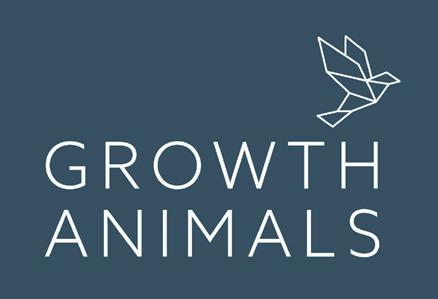
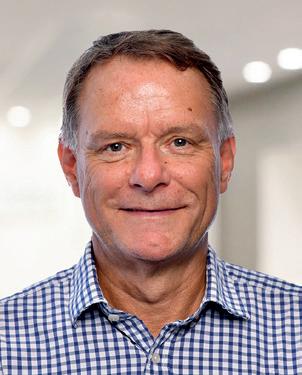
Simon Elcock, Partner & Head, Dispute Resolution and Commercial Litigation, DMH Stallard
A business dispute arises when parties in a commercial relationship disagree about their legal rights or obligations. Typical contexts include breaches of contract, director or shareholder disputes, disputes with suppliers and customers, intellectual property infringements and employment issues.
If they are not dealt with properly and quickly, disputes can consume management time, disrupt cash flow, damage relationships and reputations and may escalate to formal proceedings being issued in court.
Legal proceedings, while sometimes necessary, are invariably time-consuming and expensive processes, with uncertain outcomes.
Breach of contractual provisions
A customer or supplier may start to repeatedly breach their contractual obligations. This could include missing delivery dates, late or missed payments, or completely disregarding certain obligations. These kinds of breaches
may be more likely to occur when a contract is ‘informal’ or only partly documented, or where the arrangement is heavily weighted in favour of one party. A contract which has a ‘light touch’ on non-performance or breaching behaviours can also lend itself to its terms not being respected.
An issue around the payment of invoices may signal cashflow difficulties. Issues may present as a customer or supplier having persistent invoice queries, disputing or deducting sums or taking longer than usual to pay an invoice. A supplier may make unexpected changes to contractual terms, such as shortening the period to pay an invoice or suddenly requiring an upfront payment.
Within a business, there can be disputes between the directors and/or shareholders. Indicators of disputes of this kind may include:


❛❛ If they are not dealt with properly and quickly, disputes can consume management time, disrupt cash flow and damage relationships.❜❜









• Calling meetings to suit a party’s own availability;
• Making decisions on behalf of other members of the board;
• Voting deadlock in board or shareholder/member meetings;
• Directors not disclosing conflicts of interest or failing to perform in line with their duties, including under the Companies Act 2006;
• Parties alleging that other directors or shareholders are not performing as they should; and
• Multiple director resignations.

❛❛ It is important to remember that each business dispute has its own characteristics –there is no ‘playbook’ that can be deployed ❜❜
An uptick in queries and complaints, particularly where levels of service are concerned, may indicate and lead to a claim over performance standards and/or warranties.
Intellectual property is one of the most valuable assets of any business. If a competitor or other party is infringing intellectual property rights by, for example, using your business data, trademarks, patents or designs without permission, your business, and even your personal reputation and income, may be harmed. A common example of this kind of issue is where a former employee of a business uses similar branding or designs in a subsequent venture or uses your business’s client list.
A change in communication between parties may indicate that a relationship is deteriorating. Reduced responsiveness or the inability to reach a decision that would usually not be an issue are common examples, along with a party going completely silent.
The key for anyone facing a potential business dispute is to seek legal advice as early as possible. Seeking advice at an early stage will help you avoid taking action that could lead to adverse cost consequences or perhaps weaken your position, and will give you as much
time as possible to resolve the dispute without having to issue formal proceedings or face proceedings being issued against you.
If you anticipate a business dispute, you should start to collate as much evidence as possible, which may include:
• Written agreements (in the form of a contract or otherwise);
• Any correspondence between the parties relating to the dispute in whatever form, that has been made;
• Any other relevant documents such as invoices, purchase orders, staff policies and handbooks or intellectual property registrations.
It is important to remember that each business dispute has its own characteristics – there is no ‘playbook’ that can be deployed to resolve every commercial dispute. The Commercial Dispute Resolution team at DMH Stallard has the experience and expertise you will need to guide you through every step of resolving a dispute and will help you to achieve the best and most cost-effective outcome in the shortest possible time-frame.


If you have any questions about business disputes, please contact DMH Stallard on enquiries@dmhstallard.com
Mergers & Acquisitions can be transformative, creating new opportunities, expanding market share and driving strategic growth. Yet not every potential deal reaches the finish line.
This monthly series dives into the most common dealbreakers and dealmakers in the M&A Market. This month, we focus on achieving the best outcome on exiting your business

Jonathan Grant Partner and Head of Corporate DMH Stallard
Many business owners have in mind a preferred sale price without working out how to get there. You need to appeal to the right buyers willing to pay a premium, which is easier said than done!
Price is typically calculated by applying a multiple to the core profi tability of the business. Buyers will pay a multiple based on how reliably the business can deliver that profi tability.
Sectors vary, but size and geographic spread will also impact. Larger businesses are generally more sustainable, have resilient and established management teams and clients, and will attract more sophisticated, better-resourced buyers/investors.
International buyers could extend the businesses across their wider footprint, creating additional synergies.
PLAN TO SUCCEED
You need a plan which works for your business, but some strategies deliver time and again.
GET MANAGEMENT RIGHT
It is key to develop a credible management team behind the founders. A Sussex engineering consultancy recruited two key individuals from large international companies, attracting them with growth shares/share options, a local base, and greater autonomy.
When allied to a focused international growth plan, it led to an international buyer approaching the business. The target business fixed a key strategic gap for the buyer, who found them through an international trading connection.
Setting up overseas subsidiaries can be expensive, but it can also be done creatively and economically. A client who sold to an international group established an international footprint from a Brighton base. They rolled out a series of overseas franchises, protecting themselves by contract.
Sales leads were identifi ed in different countries, each licensed to use the business brand and operational model, social media, and know-how material, with the support of someone “in country”, building an international client base. The eventual buyer had an international business and a global business model.
Security of clients and revenue is important, guaranteed with long-term contracts where possible. If this is not possible, you need to demonstrate consistent trade over a sustained period with quality customers. This can be supplemented by introducing the buyer to key customers. Avoiding an over-reli-
ance on one or a few clients is critical to reduce risk.
BEING PAID FOR YOUR “SECRET SAUCE”
Many businesses have a unique business model, but for some, this is not capable of registration as intellectual property. This know-how can still be leveraged if you are smart.
An airline food business was successfully sold to an international airline because the buyer wanted the business and a strong team, but was prepared to pay a premium for the operational methodology.
The business owner demonstrated a process for designing and testing creative meal options which worked at altitude. Describing a repeatable process was key and led the CEO to create a business process for the buyer in Singapore.
I am a lawyer, not a corporate fi nance advisor, but like many experienced advisors, I can share techniques we have seen produce results.
For any queries or an early discussion, please contact Jonathan Grant on jonathan.grant@dmhstallard.com

















Former England rugby player Lewis Moody has announced he has Motor Neurone Disease (MND). High-profile players like Moody, Doddie Weir, and Rob Burrow have been diagnosed - the latter two having since passed away – leading to research into contact sports, head impacts, and exercise as risk factors.
So what are the sports’ governing bodies, especially those of the two national sports of rugby and football, doing about protecting their former and future players against the various forms of dementia? By
Alan Wares











While a number of studies have suggested that professional rugby players are more likely to develop MND, at present, there is no causal link. Rugby – and in particular Kevin Sinfield, the friend and former Leeds Rhinos teammate of Burrow – has been instrumental in fundraising to support research into finding a cure.
The one thing everyone involved wants is clear answers, and unfortunately, they are very hard to come by. The current science can only tell you so much. The Motor Neurone Disease Association’s



position is that the latest research suggests a correlation between traumatic brain injuries and MND, but that the same research has not proven that traumatic brain injuries are a cause of MND. Such injuries are just one of many genetic and environmental factors.
A 2022 study of more than 400 former international rugby players found that their risk of MND was 15 times greater than that of members of the general public who also participated. However, to muddy the waters, similar
studies have also shown that the risks are just as high, or higher again, among cohorts of farmers and armed forces veterans.
The difference is that the latter’s stories aren’t considered particularly newsworthy. If there’s a public perception that rugby players are especially prone to the disease, it is partly because the players who have been diagnosed have done so much to raise awareness about it.
The science is not straightforward. As the MND Association has stated, the evidence “has often been conflicting and clear conclusions cannot be given”. It also points out that the numbers involved in some of the studies
Motor neurone disease (MND) affects nerves found in the brain and spinal cord, which tell your muscles what to do. This leads them to weaken and stiffen over time and usually affects how you walk, talk, eat and breathe.
It is a relatively rare condition that is most common in people over 50, but adults of any age can be affected. A person’s lifetime risk of developing MND is one in 300.
About 5,000 adults in the UK will have the disease at any one time. Scientists are not sure what causes MND, but it is likely to be a combination of the genes - or biological traits - you get from your parents when you are born, and other lifestyle factors.
For up to one in 10 people with MND, specific genes play a much larger role. There is usually a family history of the disease in these cases.
themselves are so small that it is impossible to rule out random chance as a factor in the findings. No one wants to scaremonger people out of playing.
On the subject of traumatic brain injuries in sport, including football, boxing,
rugby and other contact sports, the only thing that any two scientists in the field are likely to agree on is that we need to do more research; much more research, and they ask for longer, better-funded studies, and with more participants.


In the meantime, it’s up to the governing bodies to educate participants about the potential risks and provide the best guidance they can to mitigate them. In this regard, football and rugby union have acted pretty sluggishly.
Similarly, the diagnosis attributed to Lewis Moody, now 47, can’t necessarily be attributed to the brain trauma he suffered during his playing career. And, while he’s said he would go about things differently if he were playing today, he has never joined the group of players taking legal action against the game’s governing bodies for failing to better protect them from the long-term consequences of playing.
In his autobiography, Mad Dog, he describes the culture in professional rugby union during his playing time. He writes about being knocked unconscious for five minutes in an international match in 2007. “The team doc suggested I should come off. I told him where to go,” he wrote. “I’d waited this long to get my chance in the World Cup, and there was no way I was walking off after five minutes. A lineout followed and I had no idea what was going off.”
He was hit in the head again later in the same game. Moody didn’t just play on each of the following weekends, he even went out on a team jolly the next day, riding rollercoasters. “Every loop the loop was torture, every jerk of my car was like having a needle shoved through my head.”

Scottish First Minister John Swinney is taking part in Doddie Aid in January 2025 to help find meaningful treatments for motor neuron disease (MND). He met representatives from the My Name’s Doddie foundation at the Scottish Parliament
is brutal and padding is minimal, and while that might draw admiration from NFL followers who watch their heroes padded to the hilt, it doesn’t help the rugby players at all.
In July this year, Alzheimer’s Society UK reported, “Two studies found that retired professional rugby players had changes in their brains and raised levels of proteins in their blood that could increase the risk of developing dementia in later life.
were asked about their career length, position and the number of concussions they recall experiencing. Information on the players was compared with 33 people with no experience of rugby or history of head injuries.
All the participants underwent brain scans and blood tests for a protein called p-tau217, which indicates the presence of dementia-related changes in the brain. They also had tests of their memory and thinking abilities to check for any signs of dementia.
❛❛ The attitude of bravado, almost to the point of abandoning self-preservation, still pervades across all levels of the game. ❜❜
He has said that he thinks the idea that anyone else was to blame for any damage he may have suffered from playing makes him uncomfortable. Although there are plenty who would disagree with that perspective, the attitude of bravado, almost to the point of abandoning self-preservation, still pervades across all levels of the game.
Cauliflower ears, received on-field, are seen as war trophies. Most forwards, especially the front of the scrum, don’t wear protective ‘scrum caps’. Impact
“Although it’s too early to say whether these players will go on to develop dementia, and the study continues for a few more years. Hopefully, this will provide further insight into whether these markers continue to change, and how this could impact the rugby players’ memory and thinking abilities.”
Scientists at Imperial College London studied 200 retired rugby players aged 30 to 61 years old. To estimate their history of traumatic brain injuries, players
Although none of the former rugby players developed early-onset dementia during the study, they did show changes known to be linked to dementia.
Many of the former players had less brain tissue in areas that play important roles in thinking and memory. They also had higher levels p-tau217 in their blood, indicating a higher future risk of Alzheimer’s disease – the most common cause of dementia.
Despite these biological changes, the retired players showed no difference in memory or thinking abilities compared with people with no rugby or head injury experience.
CHRONIC TRAUMATIC ENCEPHALOPATHY (CTE)
CAUSES
• Repetitive head trauma: The primary cause is repeated concussions and sub-concussive blows to the head, which are common in boxing.
• Cumulative damage: The condition is believed to result from the cumulative effect of head trauma over a prolonged period.
SYMPTOMS
• Cognitive: Short-term memory loss, confusion, difficulty with thinking and judgment.
• Emotional/Behavioral: Anxiety, mood swings, depression, aggression, paranoia, and impulsiveness.
• Physical: Tremors, lack of coordination, speech problems (dysarthria), and an unsteady gait.
• Progressive: Symptoms typically develop gradually and worsen over time, eventually leading to dementia and other neurological issues.
DIAGNOSIS AND TREATMENT
• Diagnosis: Currently, a definitive diagnosis can only be confirmed after death through brain autopsy.
• Treatment: There is no cure for CTE. Treatment focuses on supportive care for the symptoms and managing the progressive nature of the disease.
• Research: Ongoing research aims to find ways to diagnose the condition while living and develop effective treatments.
RISK FACTORS
• Career length: Longer careers may increase the risk of developing CTE.
The most high-profile case, and one where a coroner first blamed the act of heading footballs, was one where he reached a verdict of ‘death by industrial disease’ in the case of Jeff Astle. Astle died in 2002, at the age of 59, after suffering for several years with dementia. He was a former West Bromwich Albion and England striker who played during the 1960s and 1970s.
By the time of his death, there was already three decades’ worth of anecdotal evidence that heading the ball caused brain trauma. The Astle verdict meant there was now an official recognition of a link.
When you head the ball, the nerves are stretched, causing ongoing structural damage to the brain. The brain is attached to the spinal cord at the brainstem and sits inside a bag, which is then protected by a hard skull. Heading the ball can lead to a concussion at the time, or later headaches and a subsequent delayed concussion. Colloquially referred to as ‘seeing stars’.
Even though Astle had died in 2002, and the FA and PFA promised support and research, this didn’t happen until 2018 when they finally commissioned researchers at the University of Nottingham to conduct tests on former footballers. In its report in 2023, it stated that 2.8% of retired footballers may be at a higher risk of medically diagnosed dementia and other neurodegenerative diseases, compared to 0.9% of the general population
❛❛ When you head the ball, the nerves are stretched, causing ongoing structural damage to the brain. ❜❜
In 2017, former England striker Alan Shearer made a documentary for the BBC about dementia, specifically Chronic Traumatic Encephalopathy (CTE) in retired footballers. He spoke to the family of Jeff Astle, who were still campaigning for answers at that time.
However, in talking to Shearer’s former manager, Chris Nicholl, the latter acknowledged that his brain was getting worse, telling Shearer, “I am brain-damaged from heading footballs. My memory is in trouble. Everyone forgets regular things, like where their keys are. But when you forget where you live, that’s
Each heading of the ball, and football is the only sport where the head is used as an active implement, causes a tiny amount of damage, usually undetectable. The brain will recover from an occasional heading of the ball. However, constant, repeated heading doesn’t allow for that recovery, and, as such, any injuries that aren’t allowed to heal only exacerbate the problem.
As Dr Magdalena Ietswaart, Associate Professor in Cognitive Neuroscientist at the University of Stirling, said, “Heading the ball once doesn’t give you brain damage. We are talking about brain changes. Short-lived brain changes which are repeated over and over again.”


Scrum caps can go a long way to mitigating brain issues later in life – and ‘cauliflower ears’ while playing. Unfortunately, using a certain amount of bravado, not all affected players choose to wear them
different. I’ve had that for the last four or five years, and it is definitely getting worse. It bothers me.”
He went on to say that he hadn’t seen a doctor, feeling that they wouldn’t be able to do anything for him. It’s an attitude Shearer himself found typical that former sports players formed and lived by. Nicholl died in 2024, aged 77.
Football’s reluctance to acknowledge this issue changed when brain damage was diagnosed elsewhere, in American Football. Once the link between brain changes and CTE was made, the NFL moved quickly to set up a $750m compensation fund for players.
In 2017, US Soccer banned all children under the age of ten from heading the ball in practice or matches. The fear among neuroscientists was less about heading than about the act of challenging for a ball, which led to head clashes, which is far worse.
While research has not definitively concluded that under-10s heading the ball will lead to neurodegenerative issues in later life, one concern is that, compared
with the rest of their bodies, children have larger heads and smaller necks than adults, which can lead to greater ‘brain-wobble’ and, hence, more problems later.
Research also found that girls are more likely to suffer a concussion than boys. Neuroscientists are, it must be said, baffled at the present time as to why this should be.
❛❛ Research also found that girls are more likely to suffer a concussion than boys. ❜❜
Fast forward seven years from Shearer’s documentary, and a study led by Glasgow University’s Professor Willie Stewart, the man who first found CTE in Jeff Astle’s brain 12 years after his death, found no evidence that the high dementia risk among footballers is linked to health and lifestyle factors.
It increases the likelihood that heading footballs has caused brain injuries. Professor Stewart discovered footballers were three-and-a-half times more likely
to die from a neurodegenerative disease than the general population.
“Our data suggests this relationship between higher rates of neurodegenerative disease among former professional footballers is not driven by those wider general health and lifestyle factors, widely recognised as dementia risk factors,” said Professor Stewart.
“In the past, we would say that we felt the strongest risk was probably to do with head injuries and head impacts in sport, but we couldn’t be certain what their relationship was to alcohol, smoking, diabetes or blood pressure – these other risk factors might be involved. Now, we actually know, having looked at the data, that these other risk factors don’t appear to be contributing to the dementia risk.”
Rugby does at least acknowledge that brain trauma can occur during the game. As such, there is now a ‘concussion’ rule, allowing a player to go offand be replaced – for immediate treatment and diagnosis. This was prevalent during the recent Women’s World Cup in England.
Football also recognises this issue, but for reasons best known to itself, FIFA, the world governing body, refuses to introduce a ‘concussion’ rule.
While research continues – research that was started by anecdotal evidence, and then brought to greater prominence by the high-profile deaths of Jeff Astle, Doddie Weir, Rob Burrow and possibly countless others – scientists are still looking for the direct causal link between high-impact sports and early-onset dementia.
The evidence points towards it, and while the figures betray any lingering notion of coincidence, the smoking gun has still proven elusive.

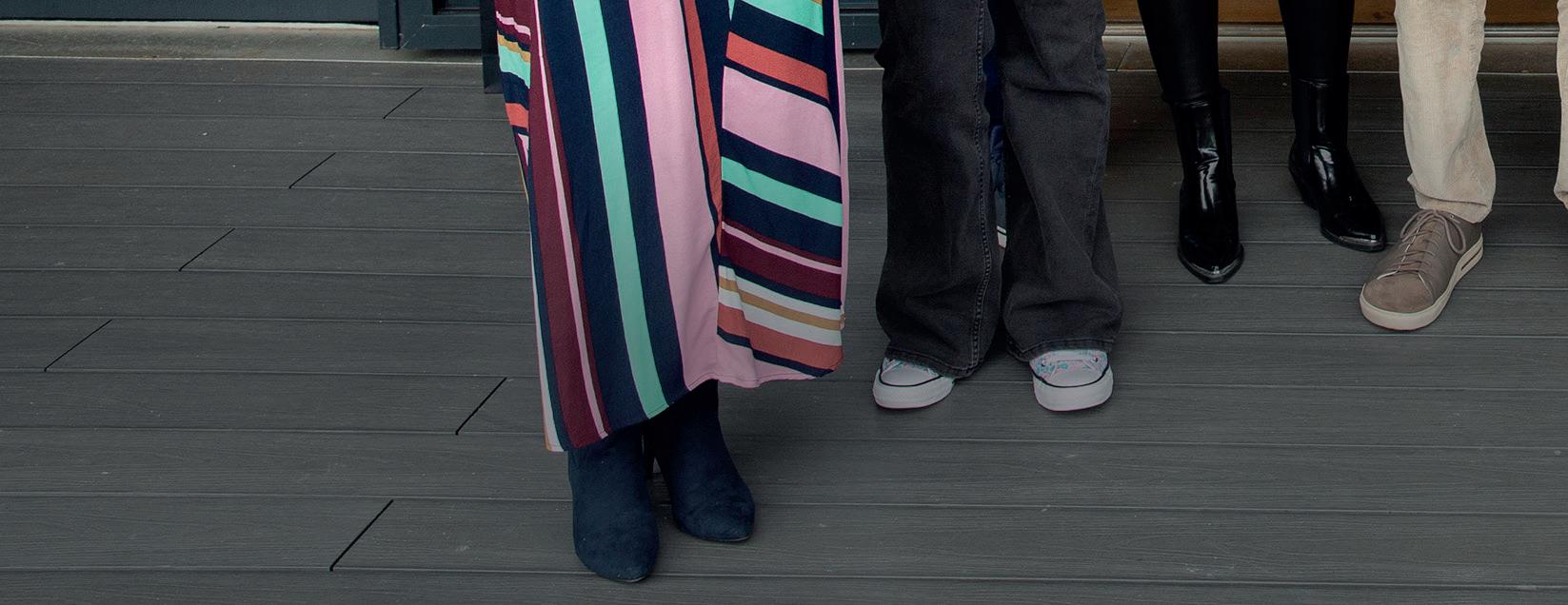

MDHUB recently hosted its annual ‘Hubbub’ awards. Richard Green describes the celebratory day
“So,” asks Fiona Shafer, “how are you finding Hubbub?” Fi is the Managing Director of MDHUB - the collective of CEOs and directors’ own leader. At the start of the 2025 Hubbub awards ceremony, MDHUB’s annual gathering to celebrate leaders’ achievements, Fi notes this is my first event - an interesting one to observe with fresh eyes.
As the attendees gather, MDHUB members recognise familiar faces from
their regular peer-to-peer workgroups, or from their splinter groups themed around topics as diverse as tech, succession planning and the four-day working week. This is a rare chance to get over 60 leaders in a room together, with as many taking the chance to make new connections to catch up with old friends.
I’m sitting next to Josh O’Riordan, a previous Hubbub winner. He picked up ‘Best
Supporting Act’ in 2023, and has since stepped up to Managing Director of app developer Brightec. He remarks that while he’s tried plenty of senior leadership groups, MDHUB is the only one that has stuck. When I ask him why, he pauses. “It’s the longevity… my group… Rob [Day, MDHUB Facilitator]... they know my business inside out.” Both this comfortable camaraderie and the diversity of leadership experience are in evidence as the awards are announced.
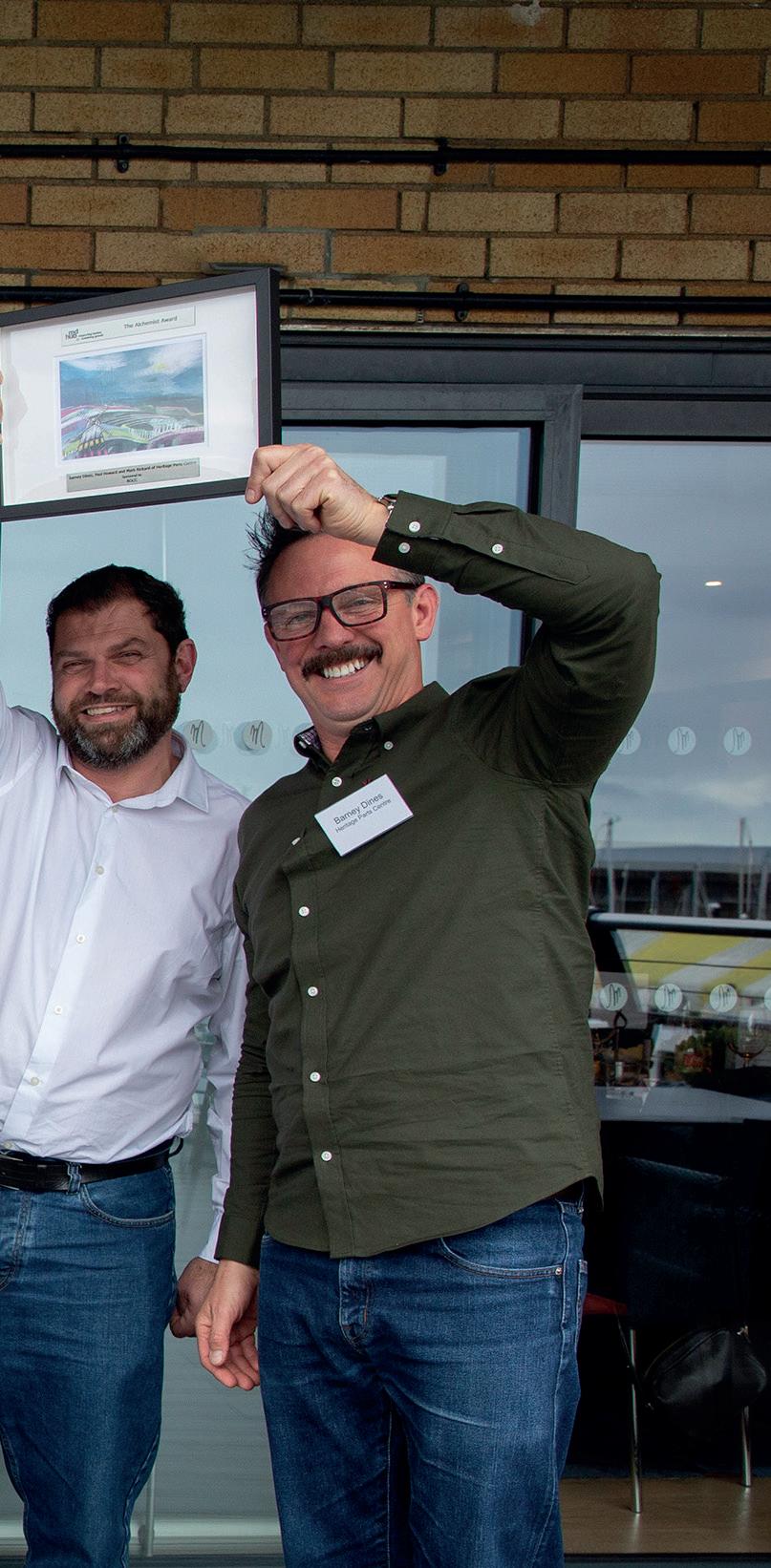


The first award is handed to Andy Ferret of secure messaging app Joyned, who is recognised with The Disruptor Award. Andy was Brightec’s previous MD before taking on Joyned, going up against some industry heavy hitters in the process. He’s the kind of leader we all want to work with - bringing out the best in people, not by demanding it but by inspiring it,” remarks Emma Hall of Nordell, who is sponsoring the award “Through Joyned, he is redefining what it means to lead with purpose, disrupting not for attention but for connection, collaboration, and community.”

In her opening remarks, Fi acknowledges that for many businesses, the past year has presented many challenges, so it seems fi tting that the next award is The Braveheart Award, sponsored by Wave Active, for a leader who has shown courage and resilience. It is awarded to Joanne Lucas of Alistair Fleming Design, who is recognised for taking on the Lewes-based Kitchen & Interiors company from its founder-namesake.
❛❛ As the attendees gather, MDHUB members recognise familiar faces from their regular peer-to-peer workgroups, ❜❜
by the trio of Barney Dines, Paul Howard and Mark Rickard of Heritage Parts Centre who have seen their hard work over the past few challenging years flourish in 2025, setting them well on the way to their ambitious growth targets.
Sometimes, a little bit of magic is needed to transform a business. The Alchemy Award, sponsored by ROCC, is won
It’s clear from the energy in the room that strong personal
The event and winners were beautifully captured by photographer Poppy Berry, and this year's awards were designed by artist Lisa Woolridge.
relationships are key to the MDHUB’s ethos. The Lioness Award, sponsored by Brightec – for the leader who has created an exceptional, happy and high-performing teamwas awarded to Robert Desbruslais of Desbruslais Chartered Surveyors, and it was perhaps fitting that the award was collected by his colleague Amanda Fearon, who paid tribute to the warm atmosphere created by her MD.
Many of the awards recognised not only overcoming challenges but also
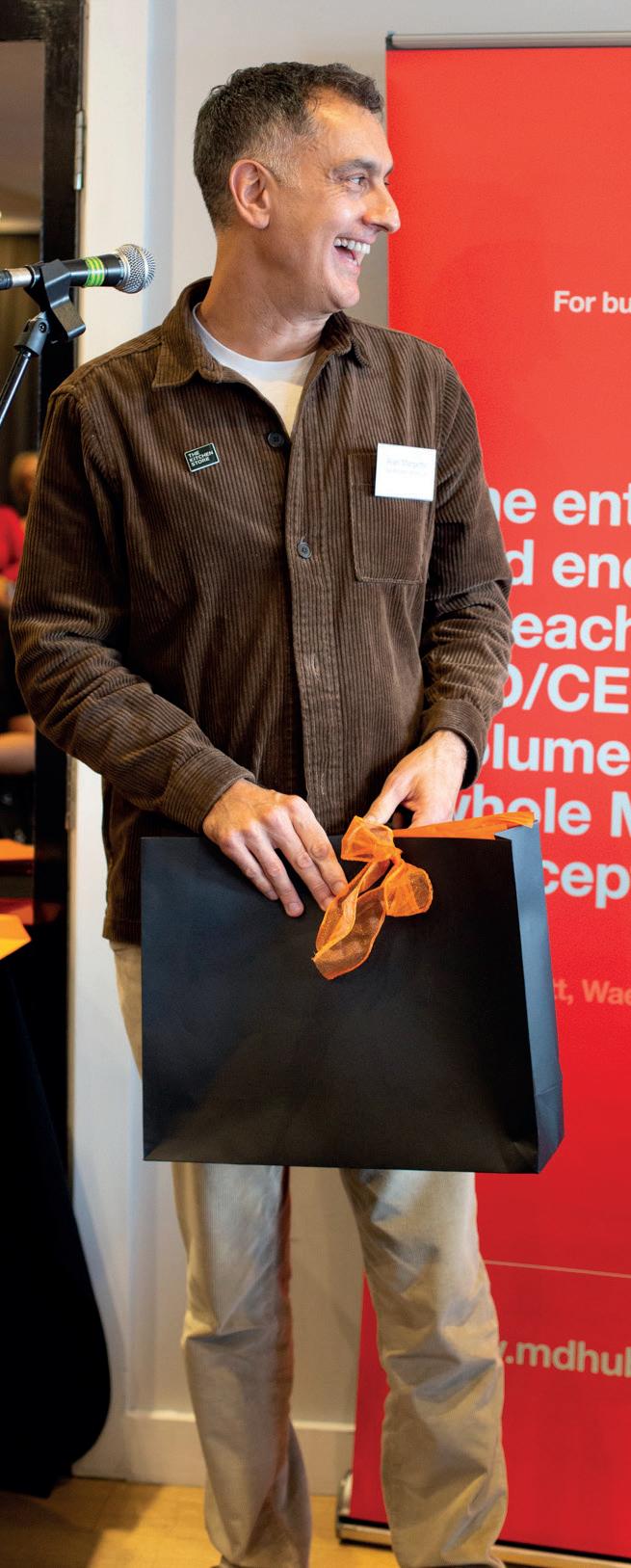

great success and momentum. So, when Camille Pierson of the Float Spa picked up the ‘Don’t Stop Me Now’ Award, it brought a wry smile when she subtly corrected the assertion that she had “almost 30,000 clients”. “Over 30,000”, said Camille, with a big smile, “Almost 31,000,” to a big round of applause.
❛❛ Many of the awards recognised not only overcoming challenges but also great success and momentum. ❜❜
The camaraderie was also evident with The Best Supporting Act, sponsored by nTrust. This unique award allows the leaders present to nominate a key member of their team who has demonstrated leadership in their own right.

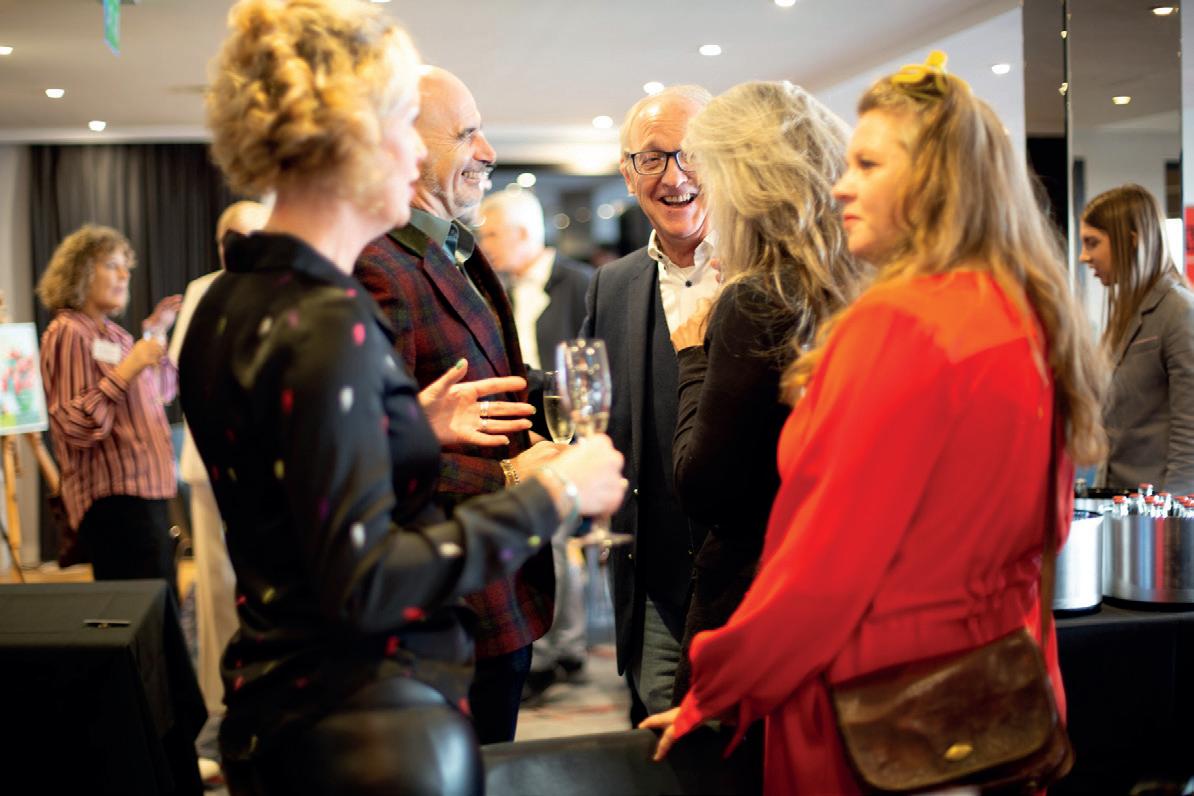
In a fiercely competitive category, Tash Wilson of ROCC was crowned the winner, with tributes paid to her strength in adversity, her compassion and generosity, and her stellar performance.
MDHUB’s commitment to nurturing the next generation of leaders is evident through The Kindness Award, presented in memory of Joe Mattelaer. Last year’s winner - Dylan Jones of DJ Engineering- told the assembled leaders how valuable his mentorship had been before announcing that Zoë Thompson of Quirky Gerties, a gifted illustrator and British Sign Language advocate, would receive expert guidance in the coming 12 months.
The final award of the night is saved for an outstanding achievement - The MDHUB Leader of the year, which saw Alan Margetts of TKS Group take home the prize. “Alan is one of those rare leaders who combines strength with deep humanity,” noted DMH Stallard’s Jonathan Grant, presenting the award. “He leads not from the front or the top, but from alongside, guiding,

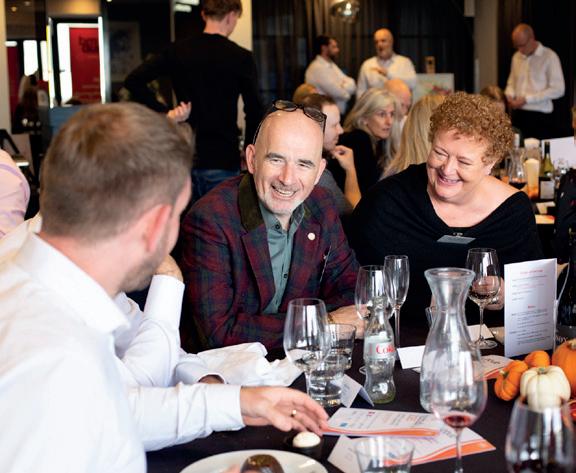
supporting, and inspiring those around him to do their best work.”
The winners from all eight categories gathered for a group photo, exchanging hugs and handshakes. The lasting impression Hubbub leaves is that, when taking a moment to step away from the dayto-day of running complex businesses, it’s nice to celebrate our individual successes, but it’s even better to experience the genuine delight at seeing friends - some whom you’ve known, worked with and respected for years - recognised for all their hard work and dedication.

MDHUB would also like to thank all its sponsors, including Espresso Solutions, Adventure Connections, Andy Sturgeon Garden Design who each sponsored food & drink at the event.
The Disruptor Award
Andy Ferrett, Joyned
For the leader who is using technology to disrupt for the greater good. Sponsored by ROCC.
The Braveheart Award
Joanne Lucas, Alistair Fleming Design
For the leader who has shown great courage, resilience and determination by overcoming many barriers as they led their team and business in the past 12 months. Sponsored by Wave Active
The Alchemist Award
Barney Dines, Paul Howard & Mark Rickard of Heritage Parts Centre
For the leaders who have transformed their business for the better in 2025. Sponsored by Nordell (UK) Ltd
The Lioness Award
Rob Desbruslais, Desbruslais Chartered Surveyors
For the leader who has created an exceptional, happy and high performing team. Sponsored by Brightec.
The Don’t Stop Me Now Award
Camille Pierson The Float Spa
For the leader who has known no boundary in the exciting, fast and sustainable growth of their business. Sponsored by Liqui Group.
The Best Supporting Act
Tash Wilson, ROCC
For the exceptional colleague behind the scenes who helps keep it all together to help the business owner lead effectively and thrive. Sponsored by nTrust Systems.
The Kindness Award
In memory of our colleague Joe Mattelaer Zoë Thompson, Quirky Gerties
This will be an annual award nominated by our members for a young entrepreneur who is embarking on their business career. They will receive an annual MDHUB membership and coaching support for those crucial early stages of growth and development. Sponsored by MDHUB.
The MDHUB Leader of the Year
Alan Margetts of TKS Group
For the MDHUB member who has demonstrated outstanding leadership in the past 12 months. Sponsored by DMH Stallard.
The wait is over - the finalists for the highly anticipated 2025 Sussex Business Awards have officially been revealed.
This year’s entries set an extraordinary benchmark, with businesses across the region demonstrating remarkable innovation, ambition and impact. Every submission underwent a rigorous and in-depth judging process, involving detailed scoring, interviews and a marathon final judges’ meeting that sparked lively debate, passionate discussions and some very tough decisions.
The judging panel - made up of representatives from this year’s prestigious sponsors, including EMC Corporate Finance, DMH Stallard, FRP Advisory, Jensten Insurance Brokers, KPMG, Kreston Reeves, MHA, Monan Gozzett, The English Soap Company, MDHUB,
True Potential, Chichester College Group, Growth Animals Marketing, Benchmark Financial Planning and Innovation Capital - carefully deliberated over every entry to determine the most outstanding finalists.
Maarten Hoffmann, Managing Director of Platinum Media Group and organiser of the event, commented: “The standard of entries this year has been exceptional. The judges were deeply engaged in robust discussions throughout the process - a true testament to the strength and diversity of the region’s businesses.
“We continue to be inspired by the innovation, resilience and ambition that define Sussex’s business community. Being shortlisted is a major achievement in itself, so congratulations to everyone who’s been named a finalist”.
The 2025 event features 16 categories, celebrating excellence across fields such as Customer Service, Growth, Export, Startups and Professional Services. The evening’s highest honour, Company of the Year, will recognise one truly exceptional business chosen from among the category finalists.
The winners will be revealed at a spectacular, sold-out black-tie ceremony on December 4th at The Grand Brighton. This unmissable event will bring together hundreds of the region’s leading professionals for a night of celebration, inspiration and world-class business achievement.
Book your tickets online today at: www.platinummediagroup.co.uk/ events/sussex-business-awards/ buy-tickets/
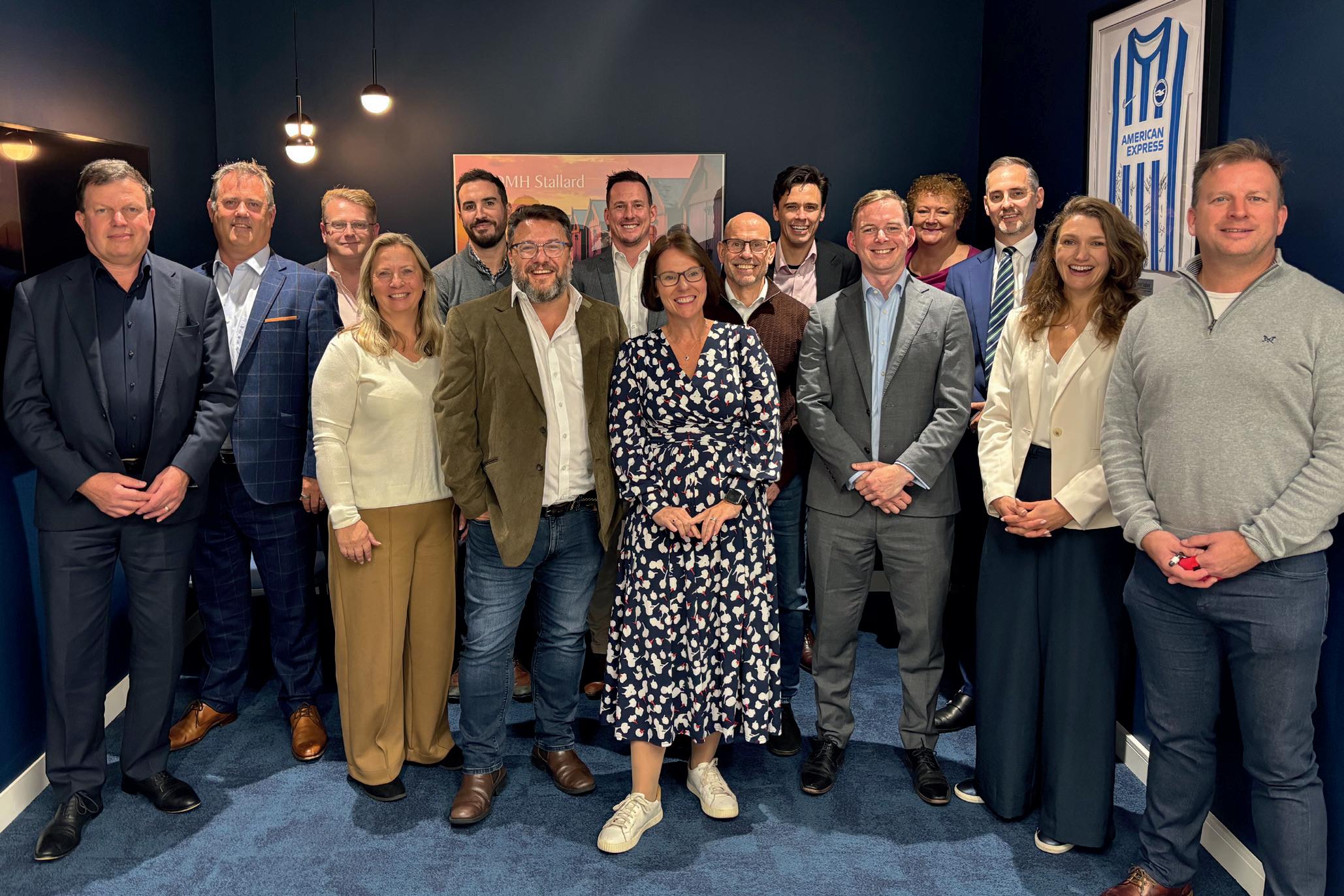





2025



Medium Business of the Year
Sponsored by Kreston Reeves
5 Squirrels
Bell Tent Sussex
Graphite Digital
Kingsway Care
Seed Publicity
Vehicle Smart
Small Business of the Year
Sponsored by MDHUB
Barnsgate Solutions
Feel Good Films
Growth Animals Marketing
Kemp Town Bookshop
Oakdene Mortgages
Shear Architectural Design
Professional Services Award
Sponsored by Jensten Insurance Brokers
Barwells Solicitors
JTP Accountancy & Tax Services
Magenta Associates
MCA Consulting Engineers
Vail Williams
Wave Community Bank
Business Growth Award
Sponsored by Benchmark Financial Planning
Bell Tent Sussex
Estatesearch
Halo Corporate Finance
Horsham Sports Injury Clinic
Merranti Accounting
Vehicle Smart
Gamechanger of the Year
Sponsored by Chichester College Group
Blaker Tech
Broadstone Risks
BubbleLife
Clarity Environmental
National Parking Platform
The Summer Berry Company

Best Customer Service Award
Sponsored by
The English Soap Company
Chichester Shutters
Consort Frozen Foods
Greenwood Plants
Lightening Fibre
Rainbow Restoration
Sussex Autos
Future Talent of the Year
Sponsored by Rockinghorse
Adam Francis | Whisky Solutions
Georgina Klovig-Skelton | Only 3 Elements
Kaia Allen-Bevan | Youth The Gap CIC
Kayleigh Dowty | Barwells Solicitors
Saskia Wickenden | Gatehouse Health
Will O’Halloran | Slinfold Golf & Country Club
International Business of the Year
Sponsored by KPMG
Dualit
EW Production Services
Paladone
Sussex Autos
The English Soap Company
The Summer Berry Company
Community Hero Award
Sponsored by True Potential
BSE|3D
Guardian Angel Carers
Inspire You Wellbeing
Search Seven
Sussex Cricket
Wave Community Bank
Best New Business Award
Sponsored by
Growth Animals Marketing
1066 Kitchens
Attercop
Barnsgate Solutions
Gatehouse Health
Maldron Hotels Brighton
Rhapsody Artist Development
Property Law Firm of the Year
Sponsored by Innovation Capital
Cripps
DMH Stallard
Goodlaw
Healy’s
Irwin Mitchell
Jonathan Lea Network
Businessperson of the Year
Sponsored by FRP Advisory
Brad Ainsworth |
Cathedral Wealth Management
David Cooper | LECS
James Parker | Parker & Son Construction
Kyriakos Baxevanis | Little Jasmine Therapies
Matt Turner | Creative Pod
Richard Pollins | DMH Stallard
Employer of the Year
Sponsored by DMH Stallard
Altnets Arke Agency
Clarity Environmental
Paladone
Search Seven
Sussex Innovation
Large Business of the Year
Sponsored by MHA
Chichester College Group
Drusillas Park
Education Cubed
Forza Doors
Meridian Medical
Spabreaks.com
CEO of the Year
Sponsored by Monan Gozzett
Kayleigh Graham | Lily England
Laura Coleby | 67 Degrees
Oliver Butts |
The English Soap Company
Peter Miles | Broadstone Risks
Rebecca Newman-Smith |
Ashton Care Group
Sarah Willingham | Brighton i360















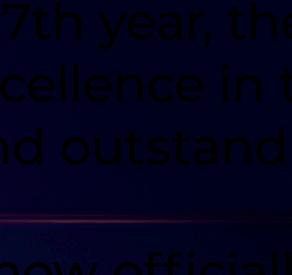



Now in its 37th year, the SBAs remain the benchmark for business excellence in the county, celebrating innovation, ambition and outstanding achievement across every sector.
Entries are now officially closed and the spotlight now shifts to the judges, a distinguished panel of business leaders and industry experts. They are carefully reviewing each submission to identify those who truly excel in impact, leadership, resilience and performance.





AWARD CEREMONY







DECEMBER 4TH 2025





























HOST HAL CRUTTENDEN

LAST TICKETS AVAILABLE















CONNECT WITH INDUSTRY PEERS, GAIN INSIGHTS INTO THE LOCAL BUSINESS LANDSCAPE AND MEET KEY PLAYERS IN THE COMMUNITY
£130 EACH | £1,250 TABLE OF 10
TICKETS INCLUDE DRINKS RECEPTION, THREE COURSE MEAL, CHARITY RAFFLE, UNRIVALLED NETWORKING AND ENTERTAINMENT
THE AWARDS ARE BROUGHT TO YOU BY






By Jo Ironside, Partner & Head of Leasehold Enfranchisement at Mayo Wynne Baxter
Leasehold reform isn’t usually a headline topic in the business community. It sounds technical, legalistic, and relevant only to homeowners in flats. Yet the Government’s Leasehold and Freehold Reform Act 2024 marks one of the most significant property law changes in decades — and its commercial impact extends far beyond the residential market.
tional cost where the lease has under 80 years remaining) will be abolished. These reforms will simplify the process
investors are already buying short leases, extending them, and unlocking the “trapped” value — turning reform into profit.
❛❛ A lease is a diminishing asset. As the years on the term reduce, the property’s market value falls. ❜❜
For investors, landlords, developers and managing agents, the reforms are reshaping how property value is created and controlled. Understanding them isn’t just a matter of compliance; it’s a business opportunity.
A lease is a diminishing asset. As the years on the term reduce, the property’s market value falls, financing becomes harder, and saleability suffers. This affects not only individual flat owners but also investors holding portfolios of leasehold properties or mixed-use developments.
Enfranchisement — the process of extending a lease or collectively buying the freehold — reverses that decline. It gives owners long-term control and increases market value.
Under the new legislation, leaseholders will be able to extend leases to 990 years, and marriage value (the addi -
and make it cheaper for leaseholders. For landlords and investors reliant on ground rent income, however, they signal an end to a once-lucrative revenue stream.
But change creates opportunity. Some
Sussex has a particularly high proportion of leasehold property — from Brighton’s seafront conversions and Hove mansion blocks to newer developments in Crawley, Worthing and Haywards Heath. Many local businesses own, manage or occupy leasehold premises without realising how enfranchisement could enhance their balance sheet.

❛❛ The 2024 reforms aim to modernise the system, giving property owners greater control and fairness. ❜❜
A few examples:
• A business occupying its office under a lease in a converted building could, through collective enfranchisement, acquire a share of the freehold and take control of maintenance standards and costs.
• A landlord with a number of short leases could extend them proactively, increasing both income and long-term capital value.
• Managing agents and surveyors can expand their service offering to meet growing demand for enfranchisement support.
Far from being niche, enfranchisement is becoming a mainstream commercial consideration across Sussex.
Some property owners are delaying action, assuming it’s best to wait until the new rules are fully in force. That could prove a mistake.
The details of the valuation methodology and secondary legislation are still being fi nalised. Meanwhile, premiums for lease extensions and collective enfranchisement remain based on current valuation rules — and the property market continues to move.
Acting now can bring advantages. Businesses can extend leases or buy freeholds under existing rules, avoiding potential bottlenecks and uncertainty
once reforms take effect. Moreover, these transactions take time: assembling participants, instructing valuers, and negotiating terms often takes six months or more.
In short, those who plan early retain the most control.
For professionals advising in this area — surveyors, accountants and solicitors alike — the valuation landscape is shifting. With marriage value removed and ground rents capped at a peppercorn, premiums will increasingly depend on reversionary value and capitalisation rates. The balance between investor return and leaseholder fairness will be recalibrated.
Landlords and developers with reversionary interests (who expect to regain possession in future) should review their portfolios now to understand how these changes affect projected income and asset value.
Businesses that view leasehold reform purely as a regulatory exercise risk missing the bigger picture. The reforms create opportunities for:
• Asset enhancement – Extending or enfranchising boosts value and improves marketability.
• Revenue diversifi cation – Managing agents, surveyors and conveyancers can expand into enfranchisement work.
• Portfolio stability – Landlords can negotiate enfranchisement settlements strategically to release or reinvest capital.
• Corporate governance – Where
companies own leasehold premises, acquiring the freehold gives autonomy over repairs, insurance and long-term maintenance.
Handled strategically, enfranchisement becomes a tool for building long-term, sustainable value rather than a legal chore.
For decades, leasehold ownership has been criticised as outdated and inequitable. The 2024 reforms aim to modernise that system, giving property owners greater control and fairness.
For Sussex businesses, this is more than a legal development — it’s an invitation to look again at how property assets are structured and valued. Reviewing lease terms, understanding potential enfranchisement rights, and taking early advice could unlock significant value hidden within existing portfolios.
As with any major reform, those who act early and think strategically will be best placed to benefi t.



Jo Ironside is a solicitor specialising in leasehold enfranchisement at Mayo Wynne Baxter, where she leads the enfranchisement team. She advises leaseholders, landlords, and managing agents across Sussex and beyond on the full range of leasehold reform issues.
Jo Ironside, Partner & Head of Leasehold Enfranchisement at Mayo Wynne Baxter jironside@mayowynnebaxter.co.uk

Best Customer Service Award
Best New Business Award
Business Growth Award
Businessperson of the Year
Community Hero Award
Company of the Year
Construction Project of the Year
Employer of the Year
Future Talent of the Year
Gamechanger of the Year
International Business of the Year
Large Business of the Year
Professional Services Award
SME Business of the Year



























At just 31, William Martin is already establishing a successful financial business, Southover Wealth, a Senior Partner Practice of St. James’s Place Wealth Management. William leads a growing team that advises professionals, families, and business owners on securing their financial futures.
The story of Southover Wealth began with a simple idea: that financial advice could be personal, proactive, and human.
“I wanted to create something that truly reflected my own values,” William explains. “When I launched Southover Wealth in 2021, it wasn’t just about setting up another financial advisory practice. I wanted to build a business where culture came first — where clients knew that their adviser genuinely cared about their long-term goals, not just their immediate needs.”
The practice, headquartered between Brighton and London, recently achieved Senior Partner Practice status within St. James’s Place. It is a significant milestone that recognises both growth and excellence in client service. It’s a notable accomplishment for a firm founded barely four years ago, particularly in a profession often dominated by advisers twice William’s age.
William’s journey into finance began earlier than most. He joined a mortgage brokerage as an administrator at first. “I was told I’d have to wait until my late
twenties before anyone would take me seriously as an adviser and start speaking to clients,” he recalls. “So, naturally, I left for a more client-facing role.”
He joined an insurance company in Brighton, which gave him an early taste of client interaction and the power of persistence. Eager to learn, William spent his lunch breaks calling unclaimed leads, revealing both his passion for finance and his ability to connect with people.
By 23, he had completed his Level 4 financial planning qualification and joined a St. James’s Place Partner Practice as a financial adviser. It was an unusually young age to step into a role where the average UK adviser is 57. “There were fewer than 200 advisers under 25 in the country,” he notes. “It was daunting at first, but it taught me to break down assumptions (both my own and other people’s). Age doesn’t determine competence; passion, curiosity and care do.”
For William, financial advice is about more than investments. It’s about helping clients understand how to make their money work for them.
“I’ve always been fascinated by the psychology of money. Most of us leave school without any real understanding of personal finance. No one teaches you what a credit score is, how to budget for a mortgage, or what you should be saving for retirement. That gap in financial education creates anxiety and bad decisions later on. Helping to close that gap is something I feel strongly about.”
❛❛ Eager to learn, William spent his lunch breaks calling unclaimed leads, revealing both his passion for finance and his ability to connect with people. ❜❜
That mindset still defines how Southover Wealth operates today. His team, made up of advisers in their late twenties and early thirties, reflects the same energy and adaptability that William credits with helping the business grow. “We’re dynamic,” he says. “We act quickly, keep our communication clear, and focus on practical, relationship-driven advice.”
That commitment extends into Southover Wealth’s approach to client education. Alongside traditional financial planning, the team regularly supports companies with workplace pension reviews and employee financial education workshops. These sessions aim to help employees make better choices about savings, tax allowances and protection.
“It’s about confidence,” William says. “Whether you’re earning £40,000 or £400,000, the principles are the same: if you understand where your money is going and what it can do for you,
you make better decisions. And that’s where real financial wellbeing begins.”
Southover Wealth’s client base today includes directors, partners and senior professionals in accountancy, law and private equity, as well as owners of small and medium-sized businesses across Sussex, Surrey and London.
“The clients we work with are typically high earners who value expertise and long-term thinking,” he explains. “Our role is to give them clarity, to map out what their financial future could look like, test different scenarios, and help them make confident choices along the way. It’s less about chasing returns and more about building a structure that supports the lifestyle they want, now and in the future.”
Southover Wealth benefi ts from the backing of St. James’s Place, a FTSE 100 company managing more than £194 billion in client funds, while maintaining the agility and personal service of an independent practice. It’s a com-
bination William believes gives clients the best of both worlds: reassurance and rigour, coupled with the approachability of a local, relationship-driven firm.
This month, William joins Platinum Business Magazine as a columnist, sharing his perspective on the financial issues that matter most to business owners and professionals in the region. Each column will tackle a different topic from extracting profi t from your business tax-efficiently to understanding how much you need to fund your ideal retirement, or how to protect your family through your company if the unexpected happens.
“My goal is to make financial planning feel relevant and accessible,” he says.




“If readers take away one idea that helps them make a smarter financial decision, whether it’s about investing, retirement, or simply understanding their cash flow, then I’ve done my job.”

William Martin DipFA CeMAP Managing Director, Southover Wealth Senior Partner Practice of St. James’s Place
Tel: 020 8058 8230
Mobile: 07487 727 498 www.southoverwealth.co.uk william.martin@sjpp.co.uk
Southover Wealth is an Appointed Representative of and represents only St. James’s Place Wealth Management plc (which is authorised and regulated by the Financial Conduct Authority) for the purpose of advising solely on the Group’s wealth management products and services, more details of which are set out on the Group’s website www.sjp.co.uk/products. The ‘St. James’s Place Partnership’ and the titles ‘Partner’ and ‘Partner Practice’ are marketing terms used to describe St. James’s Place representatives.

You can see your company’s name in lights this Christmas by supporting your local children’s hospital charity, Rockinghorse.


Every December thousands of children make a trip to the Royal Alexandra Children’s Hospital in Brighton and to the other children’s wards around Sussex.
Whether it’s a quick visit to the Emergency Department after a bump or break, or the start of a longer stay for ongoing treatment, being in hospital during the Christmas period isn’t fun for anyone.
But just like every year, Rockinghorse Children’s Charity want to make sure none of these children miss out on the festive fun.
Rockinghorse want to take Christmas to these children by delivering advent calendars and gifts to hospitals, putting on Christmas parties and festive activities, bringing Santa to hospital, and delivering Christmas meals and hampers to families on Christmas day.
“At Rockinghorse, we want to do anything we can to help children feel more at home in hospital this Christmas.”
Donna Holland CEO of Rockinghorse Children’s Charity

Whatever you can do will help so many children and families.
The best way to support Rockinghorse is to sponsor a star in the charity’s festive light display at The Royal Alexandra Children's Hospital.
This annual Christmas tradition sees the side of the children’s hospital lit up in a magical display, which could include a star with your business’ logo, showing your support for local children.


You could also
• Arrange a present collection with your colleagues at work.
• Sign up to take part in the Santa Dash.
• Organise a Christmas Jumper day or festive fundraising event.
• Volunteer your time to help families stuck in hospital at Christmas.
• Make a donation on the charity’s website at www.rockinghorse.org.uk
Whatever you can do will help so many children and families.
Find out more about how you can help by scanning the QR code or visiting the Rockinghorse website at: www.rockinghorse.org.uk

Introducing our new columnist, base Insurance’s Daniel Stoner, who will be answering your queries on insurance
Insurance may not strike most people as the most exciting profession, but then again, most people haven’t met Dan Stoner. As founder and managing director of base Insurance Brokers, Dan represents a new breed of entrepreneur shaking up one of the UK’s oldest industries.
Still in his 30s, he’s built a fast-growing brokerage from scratch, won national awards for client care, and carved out a reputation as the go-to broker for social-media influencers and next-generation businesses.
“I’d spent over fifteen years in the city looking after global brands like Dyson,” Dan recalls. “I learnt a lot about how complex risks are managed and how impersonal it could all feel. I saw a real gap for a broker who could offer that same level of expertise but with genuine personality and accessibility.”
That gap became the spark behind base, founded in 2021 from Dan’s home office. From day one, he set out to build what he calls a next-generation brokerage: one that would speak the language of modern business owners and emerging industries as confidently as it does traditional sectors. Within four years, base has expanded into new premises, grown its team, and been recognised nationally for outstanding client care.
BUILT ON THREE
base Insurance operates across three divisions: Business & Commercial,
Private Client, and Influencer Insurance – the last of which has turned heads across the market. The team now handles policies for some of the biggest influencers in Britain, including the Sidemen, managing everything from content-production cover to the insurance for their sell-out Wembley charity football match, which raised more than £4.7 million.
“It’s an area the industry had barely touched,” Dan explains. “But influencers are businesses in their own right with studios, merchandise, staff and brand collaborations. They deserve the same tailored protection as any SME. We just approach it in a way that feels fresh, fast and relatable.”
it taught me the value of perseverance and staying authentic. Clients buy people, not policies.”
It’s that human-centred approach that earned base the Outstanding Client Care Award at its 2025 industry awards, a milestone Dan cites as his proudest to date. “It proved we were right to focus on relationships first. Insurance can be complex, but trust is simple.”
❛❛ Breaking into the market wasn’t easy. Starting with no clients, no insurer relationships and a pandemic-era economy required resilience and relentless graft. ❜❜
That ethos runs through the company’s slogan: “Inspired by the need to be different.” Whether arranging cyber cover for a tech start-up, property insurance for a developer, or professional indemnity for a creative agency, the focus is always on clarity, trust, and personal service rather than jargon and box-ticking.
Breaking into the market wasn’t easy. Starting with no clients, no insurer relationships and a pandemic-era economy required resilience and relentless graft. “Those first two years were 6 a.m. to midnight most days,” he admits. “But
He’s equally proud of the culture he’s built internally. While many brokerages rely on long-serving account executives, Dan’s team skews young, diverse and entrepreneurial. “The industry has a legacy problem. Too few young people are joining. I wanted to change that. We hire smart, ambitious colleagues and give them space to grow. They’re the ones who’ll serve the next generation of insurance buyers.”
Headquartered in Sussex, base’s footprint now extends nationally, with clients spanning tech, media, property, hospitality and private wealth. Yet Dan remains a firm believer in local roots and reputation. “Being approachable matters,” he says. “People want a

broker they can call, rather than be stuck using a faceless portal.”
That philosophy has helped base become known as a “fixer” - a firm that unpicks tricky cover problems, negotiates fair renewals, and steps in fast when disaster strikes. It’s also fuelled wordof-mouth growth through genuine advocacy rather than glossy advertising.
Outside the office, Dan describes success as something more personal. “It’s about buying back time,” he says. “The freedom to be present for my wife and three kids. Building a company that allows me to do that is the real win.”

Daniel Stoner Founder / Managing Director of base Insurance Brokers.
Find out more at www.baseinsurance.co.uk
01273 101380
daniel@baseinsurance.co.uk
Starting next month, Dan will be sharing regular insights with Platinum Business Magazine readers, opening the lid on a sector that affects every entrepreneur yet is rarely explained in plain English.
“People often think a broker takes money once a year and then forgets about you until renewal,” he says. “In reality, there’s a huge amount of analysis behind the scenes: understanding a client’s business granularly, thinking holistically about their risks, then designing a programme that truly protects them. I’d like to demystify that process and show where the real value lies.”
Among the topics Dan plans to explore are:
• Cyber Risk — how rising digital threats are changing insurance from boardrooms to home offices, and what practical steps businesses can take before an attack hits the headlines.
• Insurance 101 for Entrepreneurs — a mini-series on what you must have when you start a business versus the covers that become
essential as you grow.
• Must-haves vs Nice-to-haves — why policies like Directors & Officers liability or Legal Expenses protection often prove the smartest investments you can make.
• Behind the Broker — an insider look at how policies are negotiated and why “cheap online quotes” can cost more in the long run.
• The Future of Insurance — exploring where the sector is heading, from AI-driven underwriting to how influencers and digital creators are reshaping what needs protecting.
He also hopes to highlight positive stories from within the profession, celebrating innovation, young talent and community-minded brokers working to make insurance feel relevant again.
“I want readers to see that insurance isn’t just paperwork; it’s the safety net that lets entrepreneurs take bold decisions,” he says. “If my column helps even a few business owners feel more confident and informed, that’s a result.”
Help to Grow | Management Course

250 local businesses completed Help to Grow’s Management Course
Help to Grow is a 12-week course from the University of Brighton helping local business leaders to review their business, find new opportunities and produce a growth plan.
The Platinum Media Group has been a supporter of the Help to Grow course ever since it first started. We are very proud of the longer term impact on local SMEs the programme, with Platinum’s support has offered.
Sam Knowles (read his story, opposite) is the Founder and Chief Data Storyteller of Insight Agents. In March 2025, he graduated from the Help to Grow Management Course delivered by the University of Brighton School of Business.
When Sam graduated he said “In addition to the great set of 12 core course sessions, some run online and some in person, there are two selling points of the programme that you don’t realise are there when you sign up. Firstly, the peer groups are really valuable, and it will surprise you how good they are. Secondly, the mentoring is very beneficial, I found a great mentor and have found it really useful.’
You can follow in his footsteps by joining Help to Grow from the University of Brighton when it returns to Brighton in January. We are pleased to offer the last few Platinum sponsored places on this course for our contacts, at no cost to you.
91% of people said the Help to Grow programme had improved their leadership and management of the business.
• 90% Government funded
• MBA style business training
• For businesses with more than five staff
• 12 weeks, online and face-to-face
• Taught by university experts
• Assistance with producing a growth plan
• Course starts in January 2026
There are still places left on the January Brighton cohort of Help to Grow and a limited number of Dynamic and Platinum sponsored places which means you can sign up at no cost to you, find out more at helptogrow@brighton.ac.uk


By Sam Knowles, Chief Data Storyteller at Insight Agents
In our era of Big Data and large language models, all organisations have too much data. Whether you work in a business, university, charity, or thirdsector body, it’s tricky to know how to use relevant data in the smartest possible way. It’s genuinely challenging to build an impactful, persuasive, datadriven narrative.
What many discover to their cost is that too much data gets in the way of effective comms. Whether you’re preparing proposals or presentations, crafting tenders or sales materials, an overreliance on data is counterproductive. It turns your audience off and drives them into the arms of your competitors. It’s tempting to layer on the data to showcase your expertise. For too many, narrative and numbers are like oil and water. They just don’t mix.
The best data storytellers know that the secret to combining stories and statistics is empathy – the ability to put yourself into the mind, mindset, and shoes of those you seek to influence: empathy, humanity, and a respect for the data tolerance of their audience. If you can hear how your story sounds before you tell it, you’re less likely to overload prospective customers with too much data. You’re more likely to follow the Goldilocks principle, using neither too little nor too much, but just the right amount.
to marketing. In training individuals, teams, and whole organisations in how to make smarter use of data, I’ve developed the Six Golden Rules of Data Storytelling.
1. Know your audience
2. Keep it simple – yet smart
3. Find and use relevant data
4. Beware the Curse of Knowledge
5. Avoid false positives and negatives
6. Talk ‘Human’
The two principles that need a bit of unpacking are four and fi ve.

4. The Curse of Knowledge is the difficulty in imagining what it’s like NOT to know something that you know – you’re the expert, in your organisation and the data that matters. Your prospective clients are not.
5. Avoid false positives and negatives –seeing something that isn’t there (or supported by data), that’s a false positive; a false negative is missing something that is there.
Summing up
Using these simple, straightforward rules, you’ll find your communication improves, your messages resonate better, and you turbocharge your sales impact.
For the past dozen years, I’ve worked with dataheavy businesses in many sectors – from finance to pharmaceuticals, transportation to tech, media
Effective communication is all about empathy. Turns out this is the key to impactful data storytelling, too.

By Paul Bates, Managing Director, Cleankill Pest Control
After 44 years in the pest control industry, I’ve seen enormous changes— not just in the technology and legislation that shape our work, but in how businesses are built and led.
One of the most valuable lessons I’ve learned over the decades is this: if you want your company to grow, you must learn to trust your people—especially
your sales team—and be open to learning from them, no matter how long you’ve been in the game.
The danger is that when you start a business yourself, you don’t trust that others can do the job as well as you.
I have learned so much from my young staff. When they suggest what they
think is a new way of doing things, there’s a temptation to say: “I did that 20 years ago and failed”. Now I allow them to try, and often they succeed where I failed. If they do fail, they learn—and I strongly believe that failing is learning. However, you shouldn’t be afraid to step in occasionally – sometimes it’s a small tweak that will get a staff member back on track.

It’s easy for experienced business leaders to fall into the trap of thinking they have all the answers. Experience is undoubtedly important, but it can also create blind spots. The danger lies in assuming that the way we did things ten or twenty years ago will still work today. In a competitive industry like pest control, where client expectations are constantly evolving, that mindset can stifle growth.

❛❛ It’s easy for experienced business leaders to fall into the trap of thinking they have all the answers. Experience is undoubtedly important, but it can also create blind spots. ❜❜
At Cleankill, we’ve always placed a strong emphasis on hiring good people and giving them the tools and freedom to succeed. Our sales staff, in particular, are not just order-takers—they are the face of our business, the main point of contact for new clients (after clients have dealt with an efficient administration team via phone and email!), and a key source of insight into what customers actually want. If you don’t trust them, you’ll never hear those insights—and you’ll miss opportunities to grow.
Trusting your salespeople doesn’t mean abandoning oversight or accountability. It means listening to their feedback, encouraging them to try new approaches, and supporting them when they take initiative. When a salesperson feels empowered, they’re far more likely to take ownership of their work and deliver real results. When they feel micromanaged or ignored, they’re just as likely to disengage—and you risk losing talent that could have taken your business to the next level.
Our Investors in People assessor highlighted the freedom we give to our staff. For instance, our technicians are responsible for their own patches. They love the freedom to plan their appointments and arrange their calls when it suits them. This is helpful for one of our team who has children and another who likes to start work as early as possible so she can fit in her training runs.
A successful business leader should be a lifelong learner. No matter how many years you’ve been in the industry, the world doesn’t stand still—and neither should you. At Cleankill, our success has come not just from doing things well, but from being open to doing things differently. That kind of adaptability starts with listening to your team and trusting them to do what they do best.
So, my message to fellow business leaders is simple: trust your salespeople. Encourage their input. Learn from them. You hired them for a reason—now let them show you what they can do. You might just be surprised by how much you grow as a result.

Award-winning Cleankill Pest Control specialises in providing commercial and residential pest control services across London, Surrey, Kent, Sussex, Hampshire, Bucks, Bristol and the rest of the country. For further information, go to www.cleankill. co.uk or call 0800 056 5477


By Tess de Klerk







❛❛ Recognised as a UNESCO World Heritage Site since 1993 and crowned a European Capital of Culture in 2019, Matera has gone from ‘Italy’s greatest shame’ to one of her most remarkable destinations. ❜❜


First things first – Matera is like no other city in Europe, not even close. It clings to a cliff, its pale stone houses spill down the hillside, blending into the rock as if they’ve grown from it.
Carved into the limestone are the Sassi districts, a maze of caves, stairways and terraces that tell the story of human life stretching back thousands of years. Recognised as a UNESCO World Heritage Site since 1993 and crowned a European Capital of Culture in 2019, Matera has gone from ‘Italy’s greatest shame’ to one of her most remarkable destinations.

This city’s story is a mix of hardship, resilience and rebirth. Walking its labyrinths and exploring its caves allows for immersion in that history. Archaeologists say it’s one of the oldest continuously inhabited cities on earth, settled since


the Palaeolithic era. For centuries, families lived in caves without running water or sanitation until the government stepped in during the 1950s and forcibly relocated residents. The old quarters sat abandoned for decades before locals and artists began to breathe new life into them in the 1980s.
Today, the Sassi (meaning stones in Italian) are alive again - filled with boutique hotels, galleries and candlelit restaurants. Walking through them feels like stepping through time: prehistoric caves beside Byzantine chapels, baroque palaces next to chic modern design. Matera manages to feel ancient and newly discovered all at once.



Plus, it is a fantastic destination that can be comfortably experienced in three days. I’ll jump right in…

Arrive and ease into Matera with a stroll through Sasso Barisano. If you’re fortunate enough to arrive in time for sunset, you’ll be treated to golden light on the stone façades that have proven quite unforgettable. Stop at Piazza Vittorio Veneto for sweeping views over the caves, then wander down to San Pietro Caveoso, dramatically perched above the gorge. Dinner in a tucked-away trattoria within the Sassi will start your stay off perfectly.
Start at Casa Grotta di Vico Solitario, a small cave museum that shows how families once lived, humans and animals sharing the same room. From there, climb to Santa Maria de Idris and San Giovanni in Monterrone - two extraordinary cave churches decorated with Byzantine frescoes.
Meander through Via Madonna delle Virtù and Via Bruno Buozzi, pausing at Belvedere di Piazza Giovanni Pascoli for a spectacular view across the ravine. Later, explore Palombaro Lungo beneath Piazza Vittorio Veneto, a vast underground cistern that once supplied the entire city with water. Round off the day with an aperitivo as the Sassi shimmer under soft evening light.
Don’t Miss: Find the rooftop of Chiesa di San Pietro Barisano for one of the best photo spots in town.

❛❛ Matera is made for wandering, but it’s steep and full of stairs, so comfortable shoes are a must. ❜❜
Start with a coffee near the Cathedral of Matera, the 13th-century Romanesque church that crowns the city. Inside, sunlight dances across frescoes and intricate stonework. Walk down to Santa Lucia alle Malve, another rock-hewn church filled with medieval paintings.

In the afternoon, cross the ravine into the Parco della Murgia Materana. The views looking back at Matera are breathtaking, especially near the chapel of Madonna delle Tre Porte. It’s an easy, scenic hike that puts the city’s ancient beauty into perspective. Head back for dinner overlooking the gorge, preferably somewhere with a terrace and a glass of Aglianico in hand.
If you have the energy and inclination, book a guided sunset walk through the Murgia National Park for dramatic views and the chance to see the Sassi light up from across the valley.
Spend your final day exploring Matera’s creative side. Start at the Museo Nazionale di Matera (Palazzo Lanfranchi), which features regional art and pieces

by Carlo Levi. Then wander through Civita, the upper quarter filled with elegant palaces and ornate churches.
Later, make sure to stop by MUSMA—the Museum of Contemporary Sculpture—set inside a network of caves where modern art meets ancient stone. Before you go, browse the craft shops for carved stone
Choose from regular direct flights to Bari from either Gatwick or Stansted. Matera is about 65 km from Bari Airport. Regular trains and buses connect the two, or you can rent a car for the scenic one-hour drive through the countryside.
Matera is made for wandering, but it’s steep and full of stairs, so comfortable shoes are a must. GPS can be patchy, but half the fun is getting a little lost. For anyone with mobility issues, local tuk-tuk tours are an easy way to get around.
souvenirs or the traditional wooden bread stamps used for Matera’s famous loaves.
Of course, no one travels to Italy without expecting fantastic food! Here are some highly recommended dishes not to miss while in Matera.
Pignata: Slow-cooked lamb or mutton stew baked in clay with potatoes, onions and herbs.
Cialledda: A rustic mix of bread (homemade, gluten-free bread widely available) and vegetables, served warm in winter or cold in summer.
Fave e cicorielle: Creamy broad beans with sautéed wild chicory.
Crapiata: A grain and legume stew, a Basilicata staple.
Peperoni cruschi: Crispy, sweet red peppers that locals eat like crisps. Pair your meal with a glass of deep, velvety Aglianico del Vulture wine.
I stayed in a B&B outside of town, booked by friends I was travelling with. We had a car, but it is definitely not needed for Matera. I suggest, for the full experience, stay right inside the Sassi.
These hotels came recommended. : Mid-range: Hotel Sassi and L’Hotel in Pietra both offer cosy rooms carved into the rock. They’re characterful, comfortable and right in the heart of the old town.
High-end: Sextantio Le Grotte della Civita is the city’s showstopper, with candlelit cave suites. For baroque elegance, Palazzo Gattini near the cathedral combines classic style, panoramic terraces and a spa.

❛❛ Three days is just enough to understand what makes Matera special: the layers of history, the resilience of its people. ❜❜
Book early if you’re visiting between April and October as cave hotels tend to fill fast.
Three days is just enough to understand what makes Matera special: the layers of history, the resilience of its people, and the way the city has reinvented itself without losing its soul. Ancient and modern, quiet yet full of life – it really is a unique destination.


By Maarten Hoffmann, Motoring Editor
The Chinese have invaded in terms of their automotive offerings as the UK is being flooded with cheap Chinese-made models - they seem to be everywhere these days, and this is just the start.
Unlike most manufacturers who rent space on ships to move their products, the Chinese have built an entire fleet of ships just for this purpose. Huge vessels, purpose-built with ramps and
internal storage, and when they dock, no staff are required as the cars drive themselves off the ship into their assigned parking spots. No one could say that the Chinese are not well organised and highly efficient, but what about these cars - are they any good?
Before we get into that, we should look at the bigger picture and why the US government, and more day by day, have banned their staff from driving Chi -
❛❛ Unlike most manufacturers who rent space on ships to move their products, the Chinese have built an entire fleet of ships just for this purpose ❜❜
nese-built cars. And if there is one in the family, those same staff are banned from plugging their phone into the car. Why is this?
A leaked story a few months back might indicate the reason. A group of automotive engineers took a new Chinese EV into a warehouse and, over three days, stripped it


down to every individual nut and bolt. What they found were eight parts that have no use in the car whatsoever and have never been found in cars before. They are all electrical parts, and despite weeks of research, they could not come to a conclusion about what the parts were, why they were there, nor what they did.

❛❛ The UK government has banned all Chinese EVs from all military sites and warned staff not to have official conversations in them ❜❜
Suggestions range from bombs to blow the car up on demand, parts to stop the car on demand, and parts that will automatically make the car crash - but that’s social media for you.
However, it is worrying and the US government is not telling us something!
Now the UK government has banned all Chinese EVs from all military sites and warned staff not to have official conversations in them as they are concerned that everything is being recorded - so much so, that even to park them, they must be at least two miles away from the military site!
Anyway, the point is, are they any good?
So let’s have a look at the What Car? survey of the best ones out there. I have driven many of them, but do not review EVs anymore as I find them dull, with little to say, as a golf cart is a golf cart, with little to separate them. As you might have read, l cannot deal with the range anxiety, the totally unreliable charging network and the costs that are rising to the heights of petrol, mile for mile.

1
STRENGTHS
• Cheap yet very well equipped
• Plush interior for the price
• PHEV has impressive electric range
WEAKNESSES
• MG’s poor reliability record
• Non-PHEV’s performance is disappointing
• Compromised visibility at junctions

4
STRENGTHS
• Keenly priced
• Bigger-battery versions have a respectable range
• Well equipped
WEAKNESSES
• Heavy predicted depreciation
• Feeble range of entry-level Active version
• No Euro NCAP safety rating at time of writing

2
SMART #3
STRENGTHS
• Good to drive
• Smart interior
• Great safety rating

5
MG IM6
STRENGTHS
• Long official range
• Spacious interior
• Very comfortable and quiet


WEAKNESSES
• Slightly choppy low-speed ride
• Small boot
• Rivals can travel further on a charge

WEAKNESSES
Distracting screen-based controls
Not as fun to drive as a Tesla Model Y Real-world efficiency isn’t great
STRENGTHS
• Great to drive
• Plush, high-quality interior
• Great safety rating
WEAKNESSES
• Small boot
• Slightly choppy low-speed ride
• Efficiency could be better

STRENGTHS
• Extremely fast charging
• Smart interior
• Official range of up to 441 miles
WEAKNESSES
• High floor limits rear seat comfort
• Smaller boot than Model 3
• Windscreen pillars hamper visibility


STRENGTHS
• Incredibly well priced
• Competitive range between charges
• Long warranty
WEAKNESSES
• Bad reliability record
• Slightly unsettled ride
STRENGTHS
• High-quality interior
WEAKNESSES
• Slower charging rate than rivals 7
• Infotainment system is fiddly

• Lots of standard equipment
• Mostly comfortable
• Road noise on coarse surfaces
• Rear seats could be more supportive

STRENGTHS
• Eager performance from the Long Range version
• Standard Range SE gets you lots of space for the money
• User-friendly controls
WEAKNESSES
• Choppy high-speed ride
• Range-topper’s price edges close to better rivals
• MG has a poor reliability record
This all sounds rather jolly and might tempt you, but remember, the very low prices don’t only come from the fact that they have ripped off everyone else’s technology, but the low price
STRENGTHS
• Quiet on the move
• Spacious in the back
• Very well equipped
WEAKNESSES
• Unsettled ride at times
• Rivals can go further on a charge
• Pricey PCP finance
has to indicate poor wear and tear. Therefore, if you really want a Chinese car, lease it and don’t buy it, or you might be in for a shackle when you come to sell it. Oh, and according to the US and UK governments, don’t have private conversations in it, knowing that all your data will, allegedly, be hoovered up and fasttracked to Beijing.





Honest Pricing
Managed Space
Super Fast Internet (1GB Dedicated Shared Line)
Printing
Utilities
Access to Members Directory


Open Plan Kitchen / Breakout Areas
Access to Barclays Eagle Labs Business Support
Unlimited Refreshments
FREE Beer Friday
Tailored Member Networking
Professional Enviroment


Now available to test drive at smart of Epsom.
Sometimes a trip is about the journey, sometimes the destination. Who you’re bringing, what you’re packing, where you’re headed: every day is different. So you need a car as flexible as you are.
With a maximum range of 273 miles for the #1 (WLTP)* and 283 miles for the #3 (WLTP)** and with a less-than-30-minute charging time^, you’ll always be quickly and confidently on your way back home, or off to your next adventure.








THE MEDICINE BLACK MARKET GREEN JOBS TRAVEL
London’s hidden gems SHOULD ACOBA CLOSING MATTER? FEMALE FUNDING IMPROVES







INHERITANCE TAX RULES ARE CHANGING
DYNAMIC COLUMNISTS
Alex Bailey
Relentless reinvention
Pippa Moyle
Belong where you are Natalie Montagnani
It’s not bragging, it’s branding!
Laura Hearn
The truth is in the texture






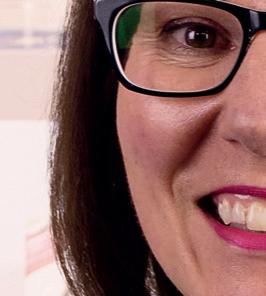

News






4 Upfront: The top international news stories involving women in business
10 In the Right Direction:
Good news stories from around the world
Finance
6 Kreston Reeves
Alison Jones recommends not leaving tax planning to chance
Regulars
8 The Alex Bailey Column
Relentless re-invention. You don’t have to remain as one character to be an achiever.
12 The City Girl Column
Writing to Pippa Moyle’s own mantra – belong where you are; and find the antidote to comparison culture
14 The Laura Hearn Column
If you ever want to find what makes a story good, look for the ‘texture’
16 The Natalie Montagnani Column
Self-promotion isn’t arrogant, it’s articulation – and certainly not bragging!
In a remarkably candid interview, the Managing Director of The English Soap Company chats with Maarten Hoff mann about the path – the highs and the lows – of her professional career, while offering tidbits of sage help to any woman just starting out in business
Events
27 Future Female Leaders
Three keynote speakers will be sharing the secrets of their business journeys. A Dynamic / Help to Grow event
28 Dynamic Awards 2026
Back for their fifth year, the premier awards for women in business is open for entries
Features
30 Female funding is improving...
... but not fast enough! The numbers are getting better, but there’s still a long way to go
32 Spotlight
Focusing on Stella Gurney and Susan Luxford– two women who deserve more recognition than they current receive
34 Standards in Westminster
Should ACOBA shutting down matter to you?
36 ‘Green jobs’
The government is investing in training people to work in the ‘green’ industry as investment grows
I raise up my voice – not so I can shout but so that those without a voice can be heard. We cannot succeed when half of us are held back”
– Malala Yousafzai
38 Poisoned slimming
Inside the illegal black market for weight loss jabs
40 Polyneucleotides
Would you consider injecting salmon DNA into your face?
Art
42 Art
‘Emotional Landscapes’ –Kellie Miller on the works of Lesley McInally
Further Reading
44 Decision-making
Avoiding the traps of decisionmaking bias
Travel
46 London’s hidden gems
Tess de Klerk discovers 15 not-sowell-known places to visit across the capital
Girl Torque
50 Cupra Tavascan V2
Fiona Shafer, MD at MDHUB, tests the Spanish manufacturer’s EV
What’s On
52 A brief snapshot of what’s on in Sussex and Surrey
Welcome to the November issue of Dynamic.
November always feels to me like a moment to take stock, to notice how far we’ve come before the rush of the festive season begins. This issue is a celebration of persistence, progress and the power of women leading on their own terms.
Our Big Story focuses on Susannah Atherton, whose varied path to Managing Director of The English Soap Company is as inspiring as it is relatable. It’s a reminder that leadership isn’t about titles but about authenticity, empathy and grit.
Our regular columnists bring their trademark wisdom too. From Alex Bailey’s thoughts on reinvention, to Pippa Moyle’s reminder to belong where you are, Laura Hearn’s beautiful piece on truth and texture and Natalie Montagnani’s call to own your story and speak it proudly. What a pleasure, reading about their lived experiences.
Additionally, Alison Jones reminds us of imminent tax changes that need to be considered –sticking heads in the sand will prove costly! We take a look at the encouraging shift in female funding and explore the growing opportunity in green jobs.
Finally, if you need a bit of escape, our Travel feature uncovers London’s hidden gems. Proof that discovery sometimes begins right on your doorstep.
Here’s to a November filled with reflection, courage and a little reminder of how far you’ve come.
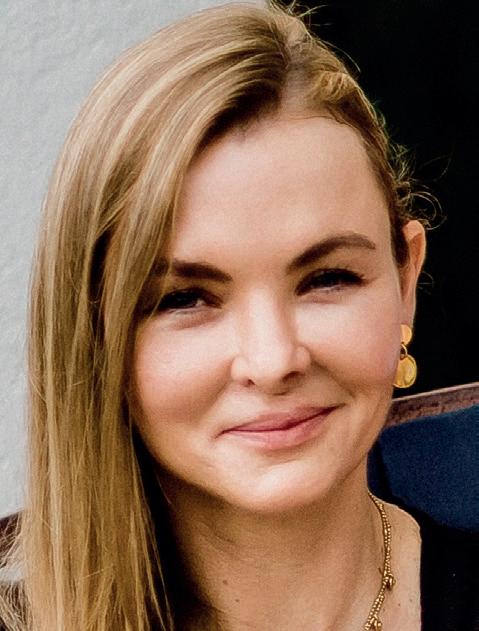
Editor, Dynamic Magazine tess@platinummediagroup.co.uk
PUBLISHER: Maarten Hoffmann maarten@platinummediagroup.co.uk
EDITOR: Tess de Klerk tess@platinummediagroup.co.uk
MOTORING EDITOR: Fiona Shafer fionaas@platinummediagroup.co.uk
COMMERCIAL DIRECTOR: Lesley Alcock lesley@platinummediagroup.co.uk
EVENTS DIRECTOR: Fiona Graves fiona@platinummediagroup.co.uk
HEAD OF DESIGN / SUB EDITOR: Alan Wares alan@platinummediagroup.co.uk
Brighton & Hove’s independent destination store, Velvet, celebrated a remarkable milestone last month — 25 years of stylish fashion, accessories, and homeware. To mark the occasion, the team hosted a party and discount shopping event, bringing together loyal customers and friends for a night to remember.
The Velvet story began in 2000 when Emma Draper opened the very first store in Brighton’s North Laine in partnership with her mother, Iris. The Velvet name moved around the city a few times before settling at its current Hove location in 2009. The 25th-anniversary celebration brought together the team, founder Emma, and many of their ever-loyal customers for a night of shopping, fizz, and entertainment from the fabulous local celebrity, Cherry Bomb.
A group of women entered the headquarters of four water companies to make citizen’s arrests and deliver evidence dossiers. They are accusing the CEOs of being personally liable for damaging the public’s right to clean water under the Public Nuisance Act. A spokesperson stated: “The government’s measures to tackle pollution have failed, so we are pursuing prosecution against the CEOs responsible.”
At Southern Water HQ in Worthing, one of the women attempting to deliver the evidence dossier was manhandled by security, before being locked out of the building. Police attended the scene and took away the evidence to review.
Afua Kyei, the Bank of England’s chief financial officer, has been named the UK’s most influential black person. The 43-year-old is one of the UK’s most senior finance leaders, responsible for the financial governance of the Bank’s £1 trillion
balance sheet and for funding reforms. The BoE executive director topped the 2026 Powerlist, which recognises the most powerful people of African, African-Caribbean, and AfricanAmerican heritage in the UK.
Kyei, who the Canadian Prime Minister
Mark Carney recruited in his former role as the governor of the Bank of England, said topping the list was “incredibly humbling”. She joined the Bank of England in 2019 and is at the core of the Bank’s leadership and decision-making.
DISCRETE ‘PACKAGE FOR MILLY’ LAUNCHED ACROSS ENGLAND
A new initiative to tackle period poverty is set to launch in Eastbourne. Named ‘Package for Milly’, the scheme will provide free menstrual products to anyone who needs them.
Starting on October 28th, visitors to the Beacon shopping centre can simply approach any centre employee and ask for ‘a package for Milly’, and they will receive an envelope containing essential menstrual products.
Hend Moussa, community manager at The Beacon, said: “We recognise that period poverty is a significant issue affecting many people in our local community. The scheme was first introduced in the Jackson Square Shopping Centre in Bishop’s Stortford, Hertfordshire, earlier this year.
‘BUILT BY HER, BACKED BY US’ INITIATIVE CAMPAIGN RAISES £100,000
A new wave of women-led ventures has been given a significant boost after the Built By Her, Backed By Us campaign raised £100,000 to support female founders across Britain. The joint initiative, which set out to champion women entrepreneurs with grassroots fundraising, mentoring, and promotional support, was judged by a panel including Muddy Stilettos founder Hero Brown, Crowdfunder Co-CEO Dawn Bebe and Flock Here founder Danielle Wallington. Alongside the communitydriven funding effort, the
campaign offered a £10,000 prize package for one standout business and cash awards for two runners-up. Three ventures took centre stage.
The winners
£10,000 prize
The Female Archetypes –Fashion design, London
£2,000 prize
Pary Moppins – Dating service, London
£1,000 prize
Her Land – Environmental social enterprise, Thame, Oxfordshire
Britain’s first female fast-jet pilot, Dr Jo Salter, has been named the UK’s most inspirational business speaker, according to the Motivational Speakers Agency.
The poll, compiled from data from more than 450 exclusive London events, reveals which keynote speakers have made the biggest impact on audiences in the past year. Dr Salter, who became Britain’s first
woman to fly a Tornado jet in the RAF, has built a reputation as a powerful advocate for leadership, risk-taking and inclusion. Her talks draw on experiences from the cockpit to the boardroom, where she now advises businesses on performance under pressure.
She leads a list with adventurer Bear Grylls in second place, and former Special Forces operative Jason Fox in third.
For the third year, Fortune Magazine has created a ranking of the Fortune 500 specifically for Europe. Between 2023 and 2024, women lost ground as CEOs of these companies, down from an initial 7% to 6.2%.
At first glance, this year, it looks as if female CEOs have made significant strides. Women run 38 of 500 companies; a share of 7.6%. But that surge is to be short-lived. Four of those female CEOs have announced their impending exits, and their successors are all men. They are: GSK chief Emma Walmsley; Sophie Bellon, the chief of food and beverage giant Sodexo; Belén Garijo of Merck KGaA; and Ilham Kadri of Syensqo SA/NV.
The Corporate Ladies Club, a members-only networking group for professional women, has announced a unique twist for its December event: it is opening its doors for anyone to attend. Traditionally, the Corporate Ladies Club operates as a female-only space that empowers, connects, and inspires women in business. The December gathering will celebrate the power of working side by side, showing that, “when we all empower and support each other, we can be an unstoppable force in business.”
As part of this event, guest Paul Barber OBE, CEO of Brighton & Hove Albion FC, and Rose Read, the club’s Chief of People and Culture Officer, will share their inspiring stories of working together for more than 13 years.
“I didn’t get there by wishing for it or hoping for it, but by working for it.”
- Estée Lauder
“If there is a book that you want to read, but it hasn’t been written yet, you must be the one to write it.”
– Toni Morrison, American novelist
The Women and Equalities Committee has published its report in response to the enquiry into female entrepreneurship in the UK. The report identifies access to finance for female founders as a critical issue, given the ‘tiny fraction’ of venture capital invested in supporting women-led businesses. The Committee calls for the Autumn Statement to unlock the economic potential of female entrepreneurs, along with an ambitious Female Entrepreneurship Strategy to sit alongside the Industrial Strategy and Small Business Plan.
Additionally, deep-seated problems in the venture capital ecosystem is one of the key root causes of this. Investment decisions are dominated by male-led firms, with women holding just 15% of positions on investment committees. The economic case for women entrepreneurs is made clear. The Rose Review identified that £250 billion in growth could be achieved if women entrepreneurs were funded to the same level as men. Adjusting for inflation, that figure is now at £320 billion.
The success of the England women’s football team is inspiring girls and women who want to secure leadership roles in a wide range of professional sectors, a business event was told.
The Lionesses’ achievement in retaining their title at the European Women’s Championships this year is acting as a rallying cry for women who want to break down barriers, according to the participants at a roundtable debate.
One of the participants, Rachel Lewis, CEO and cofounder of IQ Engineers, said “If you look at what’s happened in women’s football, it provides a really good example of how you can promote inclusivity.

“Changes to Inheritance Tax rules could have a significant impact on you and your family’s wealth, and understanding your exposure is important.”



UBy Alison Jones, Partner, Kreston Reeves
nderstandably, everyone is focusing on the Budget announcements due on November 26th. But there are some changes which have already been announced, which are coming into force from April 2026, which should be on your radar.
Changes to Inheritance Tax rules could have a significant impact on you and your family’s wealth, and understanding your exposure is important.
From April 6th 2026, the current reliefs available on shares in unquoted trading companies are being restricted. Th is means that, depending on who inherits your shares, Inheritance Tax could apply at an effective rate of 20% on any value above £1 million. For example, on a shareholding
worth £1.5 million, this could mean a tax bill of £100,000, whereas currently there would be nothing due.
Th is raises a few key considerations if shares are held on your death:
• Your family or other beneficiaries may need to fund the tax from other personal assets, or they may need to turn to the company for support, which could cause cashflow issues for remaining shareholders and directors.
• Holding too much cash in the business ahead of this could risk losing trading company status, meaning 40% tax might be due on the full value of the shares instead.
From April 6th 2027, additional changes will impact pension planning. At the moment, most individuals’ undrawn pension savings are not subject to Inheritance Tax on death. But from April 2027, if someone dies with unused pension funds, those remaining funds and any death benefits may be treated as part of their estate and could also become liable to Inheritance Tax.

A Family Investment Company (FIC) is a corporate structure that allows families to manage and grow their wealth collectively. Like any company, it has shareholders, and it can be used to involve younger generations in investment decisions before they assume full control.
There are several ways to fund an FIC. Individuals may contribute cash, transfer assets such as property, or introduce funds from sources like inheritance or pension lump sums. Typically, an FIC does not hold cash at inception, so contributions are often made in exchange for a loan (commonly referred to as an “I-O-U”), which the company owes to the contributor. These loans can be repaid tax-free in the future or gifted to other family members as part of estate planning.
Over time, as ownership is shared among family members, the growth in value of the company may fall outside the original shareholder’s estate, offering potential inheritance tax benefits. Additionally, gifting the loan to children or grandchildren can further reduce the taxable estate, provided the donor survives for seven years after the gift.
“There is still time to plan ahead before these changes take effect”
The tax position of establishing an FIC by subscribing for shares or lending funds will depend on the assets being transferred. Getting advice in advance of using this structure will be important to ensure it meets your objectives.
There is still time to plan ahead before these changes take effect. Specifically looking at the best way to protect the value you’ve built up and reduce any future tax exposure.
At Kreston Reeves we are advising clients on a number of possible actions, including:
• Review your estate and gifting options. A lifetime gift (and surviving 7 years) is still one of the most effective strategies.
• Review your Will. Th is can be structured to make the most of the available reliefs.
• Look at life insurance. It’s often used to cover IHT liabilities and can be tailored around your wider planning.
• Review your pension funds and consider if there are any changes to be made prior to April 6th 2027.
• Consider if a Family Investment Company (FIC) is an option for you.

If you would like to hear more about the options available to you, please do get in touch.
Call: +44 (0)33 0124 1399
Email: enquiries@krestonreeves.com
Visit: www.krestonreeves.com

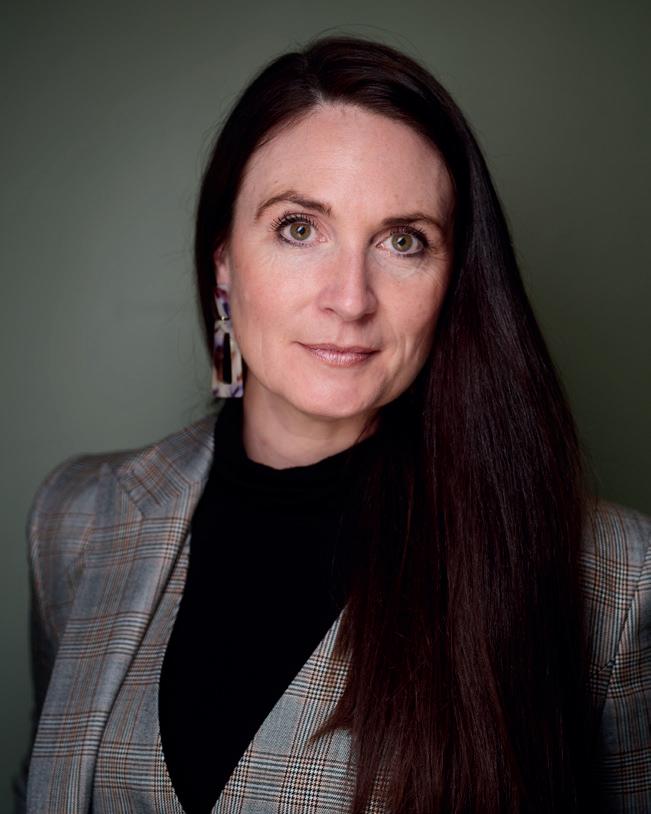

We are delighted to have Co-Founder, with 20+ years organisational change. delivering impactful programmes
By Alex Bailey
’m just a few years younger than Victoria Beckham and have followed her journey from pop star, footballer’s wife, mum and designer/business owner over the past 30 years with interest. So her latest Netflix docuseries caught my attention.
What really became quite obvious to me from her version of her story was her ability to reinvent herself against all the odds. It was great to finally hear her story, rather than through the eyes of the press, her admirers or her trolls.
What immense strength she has to pursue her career in design when being automatically underestimated from the outset of her performance era. She showed vulnerability in sharing how challenging it was for her identity.
“I had moments where I felt lost, and I questioned who I was beyond the public story I wanted people to see me for what I do, not who I was”
The part that stood out the most was that, despite saying she loved the pride she felt from her family, whom she clearly loves dearly, it was the recognition of Anna Wintour that really mattered to her. It was her stamp of finally being accepted, of achieving at the highest level of recognition in her industry by someone with such gravitas. After so many years of rejection and fighting for it, she had won her ultimate ambition.

How much do we relentlessly pursue our ambitions and take on the reinvention required to get there? For some, it may be the enormous task of completely beginning again, which Davina McCall supports in her podcast, but what I see here for Victoria is the continuous reinvention and evolution.
The endless disciplined process of evolving who you are, what you influence, and how you lead to stay relevant through changing contexts. Anticipating future opportunities, creating scenarios and predicting what will be most successful with the ability to flex and adapt as those change.
Our strengths are created throughout our childhood, and we usually have a top four or five that we use to navigate our world effectively as humans. Our strengths are the things we both do well and enjoy. I see that in business leaders, there are particular strengths that lend themselves well to relentless reinvention.
Yes, there’s discipline, loving to apply ourselves and focus on completing and moving forward. Yes, there’s also our future focus, loving learning and being curious. But there is one thing I notice in business leaders and owners above all else.
Being an achiever.
Achievers love to win, to succeed and will apply themselves to something in order to secure that achievement, even if


have Alex Bailey contributing to Dynamic. She is a Global CEO and years of expertise in HR leadership, psychology, coaching, and She specialises in cultural evolution, leadership,and performance, programmes globally while speaking at international events.
that involves incredibly hard work. Achievers don’t usually go for something that they might fail at, and often, as a result, if you ask them to describe a failure, they struggle to do so. Achievers can often feel like they are ‘Jill of all trades, Mistress of none’ as they are so good at turning their hand to anything to achieve the end goal, yet not experts in any particular niche.
I think I see this strength in Victoria, and I definitely see it in the leaders I work with.
The beauty of using our strengths effectively is that we don’t rely too heavily on one, but use our strengths in a complementary way, flexing to each new environment, situation, etc. But it can be so energising to continuously achieve and get the recognition for doing so that leaders lean on it too much.
Leaders should use their natural strengths when it matters, but sustaining a leadership career requires the self-awareness to switch to other strengths at critical moments, especially at senior levels with greater responsibility.
Relentless reinvention is not a heroic sprint but a disciplined practice: a cycle of curiosity, small experiments, candid feedback and deliberate recovery that turns ambition into sustainable craft.
“Achievers can often feel like they are “Jill of all trades, Mistress of none’ as they are so good at turning their hand to anything.”
The outcome of which is often a lack of really celebrating achievements, moving on to the next, the minute the achievement is on the horizon. An over-reliance can often lead to striving continuously and not taking time for recuperation and reenergising to remain healthy; an inability to switch off; sometimes not keeping pace with teams; constantly wanting to move up the traditional career ladder, etc.


If you recognise yourself as an achiever, how can you relentlessly reinvent yourself so you sustain energy, bring teams along and translate wins into lasting capability?
• Use your achiever drive to set bold, time-boxed goals, then deliberately rotate in complementary strengths — listening, patience, coaching and restoration.
• Time-box ambitions and schedule recovery as non-negotiable work.
• Pair achievement goals with a “people” goal each quarter (develop one direct report, widen stakeholder dialogue).
• Run micro-experiments, capture quick feedback and kill or scale based on evidence.
• Build a peer storytelling habit to normalise difficulty and share practical solutions.
• Track one metric that signals long-term health (team retention, wellbeing, learning hours) rather than only output.
If Victoria Beckham’s story teaches anything, it’s that recognition and reinvention arrive for those who iterate with rigour and humility, and who intentionally balance the drive to achieve with the skills that sustain people and purpose over a lifetime.
Alex Bailey styled by Gresham Blake Email: Alex@baileyandfrench.com www.baileyandfrench.com Insta @alexbaileybackstage Follow me on LinkedIn: www.linkedin.com/in/ alex-bailey-26562b2/
❛ ❛
“Understand that one day, you will have the power to make a difference. Use it well.”
- Mindy Kaling, American actor
A pioneering eye implant is allowing blind people to see again. In a global trial, 38 participants with advanced macular degeneration received a microchip beneath the retina. It restored some sight in 84% of them, including Sheila Irvine, who

described reading again as “life-changing.” Developed by US-based Science Corporation, the device connects to smart glasses that send visual data to the brain. Experts call it a major leap forward in artificial vision technology.
A new ultrasound therapy is being hailed as a major step forward in cancer care. The treatment, called histotripsy, destroys tumours using microscopic sound-induced bubbles, avoiding surgery or chemotherapy. Roger Jackson, 80, was Europe’s first patient to receive it for liver cancer at Addenbrooke’s Hospital in Cambridge. “It’s amazing that sound can treat cancer,” he said. The 30-minute procedure allows faster recovery, and studies are now exploring its potential against other cancer types.
Global investment in green technology has hit record levels, with more funding in the first nine months of 2025 than in all of 2024, Bloomberg reports. Over $56bn has flowed into climate tech, including renewable energy, battery storage, and electric vehicles. Despite political resistance in some countries, investor confidence is rebounding. Bloomberg’s Coco Liu said many now view clean technology as essential for both environmental protection and national energy independence.
Ireland will make its basic income scheme for artists permanent after a successful trial launched during the pandemic. The programme gave €325 weekly to more than 2,000 creatives, boosting both cultural and economic activity. A study found it generated €100m in wider benefits. Dr Andrew White of King’s College London said the initiative could guide other nations as they confront AI’s impact on jobs. The government hopes it will strengthen Ireland’s creative sector.
“Half the world are women. The other half are their children.”
- Efu Nyaki, Tanzanian healer
Spain has approved six new marine protected areas covering 17,000 square kilometres, roughly the size of Kuwait. The zones include the Mallorca Channel seamounts and Alboran Sea banks, home to rare species and sensitive ecosystems. Conservation group

Group singing may ease postnatal depression more effectively than standard treatments, according to research from King’s College London. Among 199 mothers studied, those who joined “Breathe Melodies for Mums” singing sessions had 15 more days of full health than
those who did not. One participant said, “Singing made me happier and more confident.” Yvonne Farquharson of Breathe Arts Health Research urged wider adoption of the low-cost therapy, calling it a proven way to support mothers’ wellbeing.
A powerful new statue in London celebrates the raw beauty of motherhood. Mother Vérité, by British artist Rayvenn Shaleigha D’Clark, depicts a mother holding her newborn with every postpartum detail shown honestly. “Motherhood is both ordinary and extraordinary,” said the artist. The sculpture highlights women’s underrepresentation in public art and honours their strength. First displayed at St Mary’s Hospital, it will move to its permanent home in Portman Square.
Oceana welcomed the move, which increases Spain’s protected waters to 22.45%. “It’s great to see these valuable habitats finally safeguarded,” said Oceana’s Michael Sealey. The plan awaits EU approval before long-term protection begins.
Feeding nearly ten billion people by 2050 without damaging the planet is achievable, says a major EAT-Lancet Commission report. It urges big shifts in diet, including less meat and dairy and more grains, fruit, and vegetables. Food systems cause 30% of
global emissions and drive biodiversity loss, but reform could reverse this. The commission’s “planetary health diet” could deliver $5tn in annual benefits through improved health and ecosystem restoration worldwide.


Oxford University has posthumously awarded a degree to Mākereti Papakura, thought to be the first Indigenous woman to study there. The Māori scholar died in 1930 before presenting her thesis, later published as The Old-Time Māori, a landmark ethnographic study. More than 100 of her descendants attended the award ceremony. “She’s been a legend in our family for generations,” said June Northcroft Grant. The honour recognises Papakura’s lasting cultural contribution.
Pippa Moyle is the CEO and founder of the City Girl Network, a mission-driven business dedicated to empowering and supporting women across the UK. Since launching in March 2016, the network has built a vibrant community of over 150,000 women, facilitating new friendships, business connections, job opportunities, housing solutions, and valuable life advice.

By Pippa Moyle
Belong where you are. That’s our City Girl Network slogan; sewn into the fabrics of everything we do. Our mission is to help women call their postcode ‘home’, achieved through events, online forums, and local, life, work and travel advice. We’re the big sister they always needed, meeting them where they are rather than who they were or who they think they should be.
It’s a simple slogan, ‘belong where you are’. Yet in the last few months, it’s been one that’s carried me through a wave of intense personal growth. An experience that I now realise is shared by many, but at the time felt isolatingly lonely.
There’s never been a better time to be a female business owner. There are more of us, for a start. An entire ‘female entrepreneurship’ industry has been created with books, talks, webinars, awards, magazines and merch. You’re currently reading my column for a Women in Business magazine.

“To be my authentic self, I will never be ‘Her’. And it’s made me feel rather inadequate.”


Then there are organisations like Small Business Britain, which are helping to close the knowledge gap with their ‘F:Entrepreneur’ campaign.
It’s not completely intersectional, but it is better. I wouldn’t change my position as a business owner. But for the last few months, I’ve had a visceral desire to change who I am as one. I should be louder, more outspoken, more viral, more vibrant, more ‘her’.
‘Her:’ Those intelligent, sassy, kickass women who don’t give a f*ck. They’re crowned with awards, members of numerous boards, talk about their messy past lives and the rebel they’ve just about tamed through retreats and idyllic nature walks. They’d make a bin bag look like a ball dress because they are just that epic.
“I belong here and so do you.” That’s my leadership style, not through a book, a course or a webinar. It’s just instinctively how I lead, who I am.
Comparison culture has swallowed the potential of numerous brilliant businesswomen (and men, for that matter). Women who leave their careers after the birth of their second child because she doesn’t feel they can juggle as well as others. Women who don’t go for a promotion because they know someone else will do better. Women who keep their ideas to themselves in meetings because if a colleague they admire doesn’t say it, it’s probably not an idea worth thinking about.
“The only reason I feel inadequate is that I’ve been comparing myself to the women who are elevated into my orbit.”
They are the Queens of LinkedIn and the “You Should Meets” on everyone’s lips. They’re busy hustlers who do it all; the epitome of a female entrepreneur. All the things I’ll never be.
OK, not all the things. I do wear yellow to all business functions, and I’m certainly not shy. But the fundamental truth is: I do give a f*ck. What people think of me, how people experience me, and how my actions can impact others. I give a thousand f*cks about it all.
To be my authentic self, I will never be ‘Her’. And it’s made me feel rather inadequate.
I didn’t face how I felt until a volunteer recently complimented my leadership skills, sharing them as my strongest quality. “Could you share how you developed your skills as a business leader? I’d really like to implement them to help me get a promotion at work,” she asked. Later, clarifying that I am “the best leader she’s worked with in [her] 12-year career”. A simple question for ‘Her’, a huge realisation for me: chronic comparison has distorted my mirror image.
The only reason I feel inadequate is that I’ve been comparing myself to the women who are elevated into my orbit. They’re women I deeply respect, but also the only women that I have to represent what an Ideal Business Woman looks like.
Yet we all know that nothing is ever certain until it happens, and we only ever see one another’s lives through a narrow periphery. No person is the same, no business is the same, no story is the same. Even when they feel so relatable that you could have written it yourself, you’ll realise a few sentences in that you’re either a ghost writer of their story or carving out a whole new book of your own.
The only useful way to utilise comparison is to understand why you are compelled to be like that other person. What qualities could you develop? What are they teaching you? Write down your answers, come up with actions, and move on.
For me and those I’ve opened up to about this, the only true antidote is to belong where you are. Ground yourself in that person you’ve worked so hard to be, and embrace your community. Not the elevated ‘Hers’ you’ve been using as a stick to beat yourself with; the real-life people who remind you that the unique you is the only one you ever need to be.





Pippa Moyle CEO + Founder citygirlnetwork.com
Our Communities: Brighton, London, Manchester, Bristol, Bath, Leeds, Edinburgh, Birmingham, Worthing, Liverpool, Newcastle, Chester, Milton Keynes, Oxford, York, Cardiff, Glasgow, Perth and Rural Sussex
Laura Hearn is a former BBC journalist, now storytelling consultant and founder of Flip It - a podcast and platform helping people and businesses use storytelling as a tool for clarity, connection and change. This month, for Dynamic, Laura points out that the basis of good storytelling is in the ‘texture’

“When a friend recently asked, “How do you know what makes a good story?” It took me by surprise, because it’s something that feels so instinctive.”
By Laura Hearn
It’s 5:47 p.m. on a rain-soaked Sunday, and I’m writing by the glow of my laptop. I’ve been here for hours and barely noticed I hadn’t put the lights on. My phone is silent, the world outside dissolving into puddles. Apart from a brief, drenching dog walk, I’ve spent the day at my desk, researching, shaping sentences, following threads of thought that have led me somewhere unexpected. It’s the same instinct I learned in the newsroom… follow curiosity, always.
So when a friend recently asked, “How do you know what makes a good story?” It took me by surprise, because it’s something that feels so instinctive. It might sound geeky, but words have always been my favourite thing. The way they move, connect, and create a kind of order from chaos. I’ve spent decades chasing and crafting stories, but the answer arrived later that day, standing on a windswept beach. As cliché as it sounds, the sea was a churn of light and shadow, dark clouds colliding with sunlit water. And as I stood and felt the fresh air hit my face, one word came to mind - texture.
We humans don’t do well with discomfort, especially when we don’t know how or when it will end. We crave resolution, neat endings, the tidy bow that tells us everything’s fine. But life isn’t tidy - and neither are stories. They’re messy, uncertain, full of detours and contradictions, and that’s exactly why we need them. They help us make sense of what otherwise might not make sense at all.
A story is a structured way of looking at reality. It’s not just a beginning, middle, and end - essentially, it’s a mirror held up to life. We instinctively understand stories built around conflict, resolution, and transformation because that’s the fabric of being human. Conflict gives the story texture. It’s what makes us care, what drives us to turn the page, what gives the resolution its meaning.
When I worked in news, truth and texture were what I searched for most. The layers, the grit, the emotion beneath the facts. The moments that couldn’t be neatly scripted. They’re what made a story real and relatable.
Now, outside the newsroom, I see the same pattern everywhere. In the brands and businesses I work with, the ones that endure are the ones unafraid to show the messy parts - the uncertainty, the tension, the human side. They understand that texture isn’t a weakness, but a valuable vehicle for
building trust, credibility, and connection. It turns customers into believers, and followers into communities.
The same principle applies to brands. A story and a business without texture quickly fade into the background of polished perfection. We’ve all seen the glossy marketing messages that promise success without struggle. They might attract your attention for a moment, but they don’t hold it for very long. Like a badly scripted and acted film, you switch off and scroll Netflix for the next one.
We spend so much of our time inside the polished worlds of social media and corporate communication that it’s easy to neglect all the wisdom to be found in imperfection. Yet it’s those rough edges and moments of desperation that create connection.
“So if you ever find yourself wondering what makes a story good, look for the texture. Texture gives them dimension. It’s the difference between your story ending in tragedy or triumph.”
When a brand leader or business dares to tell the ‘textured truth’, it stands out…loudly. It rejects sameness and replaces performance with presence and purpose. It signals confidence and courage in a clear and compelling way.
The brands that endure are the ones willing to show what really happens behind closed doors. They share the challenges as well as the triumphs, the near misses as much as the milestones. The sweat and blood that got them to where they are. That honesty builds empathy and trust, two things algorithms can’t fake and competitors can’t copy.
In my work with founders and leaders, I see again that a company’s most valuable insights rarely come from data dashboards. They emerge in the messy middle, the middle of the night ‘brain farts’, the decision you ruminate over and the moment of doubt that becomes a turning point. Those are the stories that make audiences crave more.
Conflict is not a brand weakness—it is a critical component of your DNA and your proof of growth. When you name the problem you’re solving, and the struggle that shaped your solution, you invite people to walk alongside you. You move from selling to guiding and from transactional to transformational.
Whether you’re leading a team, launching a campaign, or speaking to investors, texture humanises you. It turns information into meaning and gives your audience something to hold on to. The most compelling stories come from experience, not all the time things went well. When a brand is open about its struggles and what it’s learned, people feel that honesty. It builds empathy and trust. A story without texture and conflict doesn’t reflect real life, and without it, there’s little for an audience to hold on to.
The next time you’re refining your message or preparing to share your story, ask yourself - Where’s the texture? What were the moments of tension, learning, or change that made this possible? That’s the story people will remember, because it mirrors their own.
As I walked back home that day, I paid attention to texture and found it everywhere. In the uneven pavements, in the chipped paint on the shopfronts, in the faces of people bracing themselves against the wind. Every mark, every imperfection told a story. And I realised how much of that we’ve lost in a world obsessed with homogeneity.
Real life is rough around the edges, but that is always where the beauty is. The same is true for writing, for leadership, and for business. The things that move us most are the ones that dare to show their cracks.
So if you ever find yourself wondering what makes a story good, look for the texture. Look for the conflict, the imperfection, the small glimmers of light breaking through the dark clouds. That’s what makes stories and businesses human. Texture gives them dimension. It’s the difference between your story ending in tragedy or triumph.

You can listen to Laura’s podcast, Flip It, wherever you get your podcasts, and you can connect with her at www.flipitglobal.com
Natalie Montagnani is the founder of IGNITE and a senior business strategist with 25 years of experience in marketing and growth consulting. She helps ambitious women — from corporate leaders to entrepreneurs — to scale with strategy, elevate their influence, and lead with confidence. IGNITE also supports companies committed to advancing female leadership and driving real change.
By Natalie Montagnani
Afew weeks ago, I got a call that made my stomach do a full gymnastics routine. A sponsor had dropped out of an event last minute and left the networking event organiser one speaker down, and they were asking me to step in.
I can promise you that every single part of me wanted to say, “Thank you so much for thinking of me… but no.” But I didn’t. I said yes!
I rapidly pulled together a presentation, rehearsed it, slipped into my red power dress (complete with shoulder pads), turned up, and spoke from my heart about my mission with IGNITE and why we need women to lead. And guess what? Someone in that room — who had never met me before — signed up for my mastermind programme on the spot. That’s the power of visibility.
I said yes to an opportunity even when my inner voice was screaming “play small”. But when we stop hiding, stop waiting for the perfect moment, and simply show up, magical things can happen!
Layer in a generous helping of imposter syndrome — that sneaky inner voice whispering “Who am I to say this?” — and it’s no wonder so many brilliant women shrink their wins down to “Oh, it was nothing.” Except it wasn’t ‘nothing’. It was hard work, skill, courage, and leadership. And when we don’t claim it, we make it harder for others to see it too.
Every time you brush off praise, you train people to see your contribution as small. Every time you bury your achievements under a bushel, you make it harder for people to recognise your value. And every time you stay quiet in rooms where decisions are being made, you give your power away.
“Every time you bury your achievements under a bushel, you make it harder for people to recognise your value.”
For many women, self-promotion feels about as comfortable as wearing stilettos on cobblestones. We second-guess ourselves, soften our language, and wait for permission that isn’t coming. Why? Because culturally, we’ve been conditioned not to make a noise. Research consistently shows that while men are rewarded for being assertive and visible, women are more likely to be labelled “pushy,” “full of themselves,” or “a bit much” for the exact same behaviour.
I’ve seen this time and again — with founders, senior leaders, rising stars. Women are doing extraordinary work, but invisible outside their immediate bubble. Meanwhile, their less qualified (but louder) peers are getting promotions, funding, keynote spots, and board seats. Visibility and self-promotion aren’t about being the best. It’s about making sure people know you’re the best.
REFRAMING “BRAGGING” AS STRATEGIC COMMUNICATION
Here’s the reframe that changes everything: Instead of “I’m bragging about myself.” Think “I’m communicating my value so the right people understand how I can lead, create impact, or help.”
Self-promotion isn’t arrogance. It’s articulation.
When I said yes to that speaker slot, I wasn’t doing a hard sell. I shared my story, my expertise, and my mission — clearly and unapologetically. And someone in the audience immediately saw themselves in it. That’s not bragging. That’s branding.

Imposter Syndrome’s favourite lines (and how to ignore them)
Imposter syndrome whispers:
• “I don’t want to sound big-headed.”
• “I’m not that special.”
• “People will think I’m showing off.”
• “I’ll speak up once I’ve achieved X…”
Here’s the plot twist: most of the women I work with are already overqualified for the thing they’re talking themselves out of. No, you don’t need another certificate or five more years of experience to speak with authority. You need to believe you belong in the room — and show up accordingly.
If the word promotion makes your palms sweat, reframe it as personal storytelling.
You’re not bragging. You’re:
• Sharing your journey so others can see what’s possible
• Articulating your expertise so people know how you can help
• Making it easy for opportunities to find you
A few practical ways to do this:
1. Lead with facts, not fluff
“I increased client retention by 35% in six months” lands differently than “I’ve done some work in that area.”
2. Own the “I”
Say, “I developed the strategy that led to XYZ,” not “We just got lucky.”
3. Bake it into your everyday
You don’t need to wait for a keynote stage. Post about it. Talk about it in meetings. Share it at networking events.
4. Anchor it in impact
“I’m proud of this because it created new opportunities for women in leadership.” Purpose makes it powerful.
“Self-promotion isn’t arrogance. It’s articulation.”
YES, THERE’S A DOUBLE STANDARD — BUT WE DON’T WAIT FOR FAIR
Let’s be honest, when men self-promote, they’re seen as confident. When women do, they’re often labelled “a bit full of themselves”, but waiting for the system to become fair isn’t a strategy.
The way we change the narrative isn’t by shrinking ourselves. It’s by being so visible, so clear, and so damn good that our presence shifts the culture. When one woman owns her story out loud, she gives permission to others to do the same.
Whether you’re a founder, a leader, or an emerging powerhouse, you are the walking, talking billboard for your work. People don’t just buy services, ideas, or skills. They buy stories, and your story is only powerful when you actually tell it! And no, that doesn’t mean faking perfection or turning yourself into a LinkedIn robot. It means:
• Showing up consistently
• Speaking your truth with clarity and confidence
• Allowing others to see the real scope of your brilliance
The world can’t celebrate what it doesn’t see or hear. So please, speak up!
If I’d said no to that last-minute speaking slot, I’d have missed the chance to make a powerful connection, grow my business, and inspire a room of women. But I didn’t. I said yes. And in doing so, I reminded myself and everyone else in that room what happens when we stop playing small.
So, is self-promotion a dirty word? No. It’s one of the greatest career moves you’ll ever make. When you learn to articulate your value, doors open, opportunities multiply, and impact grows. You stop waiting for people to notice you, and you become impossible to ignore.
And sometimes, it all starts with saying yes, stepping on stage and owning your red-dress moment. What small step forward could you take today?
Natalie Montagnani Founder of IGNITE Women in Business
07900 153503
ignitewomeninbusiness.com
Connect with Natalie on LinkedIn or drop her an email to natalie@ignitewomeninbusiness.com
The English Soap Company was founded by an odd event. Bob Butts was cleaning out a barn on his property when he came across a dusty old machine. A bit of research showed that it was a very old soap bar making device and Bob, ever curious, decided to get it going.
Some months later, he had actually produced a few bars of soap and tried to sell it to the local shops but they were rough samples and no one was interested. A decade or so later, The English Soap Company is exporting around the world, has won several prestigious awards and is turning over circa £8 million per year with 104 staff.
MAARTEN HOFFMANN: Susannah, welcome to Dynamic. Let’s go back to the beginning. Where did it all start? What was your first job?
SUSANNAH ATHERTON: I actually had several jobs as a teenager. My first was in an egg-collecting factory in Burwash for two years. I also did work experience for a company called Funnel & Perring in Hastings, as I wanted to be a solicitor. I didn’t have the qualifications, and my family couldn’t afford to send me to university either but Gerald Funnel employed me every holiday and took me to the courts in Hastings. I loved it.
At 15, I was a chambermaid at a local motel, and by 18, I was working behind the bar. I eventually enrolled at Bexhill College, where I studied A/S Law and English. I really didn’t want to stay in Burwash, so I moved to London to try to earn proper money, trained to be a secretary, and worked in a solicitor’s office in conveyancing, which really wasn’t for me.
I moved to the National Midwifery and Nursing Council as a secretary, and I loved it. I had also been temping, and that was where I met my husband. So, pretty varied.
MH: How did you meet him?
SA: I worked for him in London at the International Cadmium Association. When they then moved to Brussels, I went and set up the whole company. It was where I realised that people-organising was what I was meant to do. I did some HR training, because ‘people’ was my skill set. Upon my return home, we moved to Haywards Heath, and then
we commuted to London, and I worked for a company called Blenheim Bishop, where I suppose I learned the art of compromise, which stood me in greater stead later.
MH: You got married around this time?
SA: I was 24 when we got married, and by then, I had moved to a company called Hutchinson Whampoa. It was a Chinese company, and I worked in the HR department. This is when I got married and had my first daughter.
MH: Did you stop working? If so, how long for?
SA: Not very long, and when I did go back, I realised I really couldn’t return to work in London, nor to an office, because we had a baby. Two and a half years after our first, our second baby was born. When our second child was six months old, I took a beauty course at Eastbourne College. This was made easier by my mother-in-law’s help with childcare.
MH: So you had to put up with the same things most mothers have to suffer; you wanted to work, but you had to look after the kids…
SA: If my husband was away and something went wrong, we just knew it wouldn’t work. I got around the stay-at-home issue by enrolling in a beauty and make-up course. I met this lady called Jane Farden, who clearly saw something in me. She told me I had this ability with women.
There were conferences for battered women; women who had real issues, and we needed to give them self-esteem. I did their makeup. I got into doing colours, dressing people, and style, which is a real passion of mine.

“I looked after 120 guys in a tree surgeon’s company. That’s where I really cut my teeth.”
Th is inspired me to set up Colour Confident, a company I ran from home. It gave me a sense of purpose as I could work in between dropping off and picking up the kids from school. The downside was that it made me realise that so many women have had awful lives, awful husbands, and their lives were just unbearable. One woman was told by her mother never to wear red because it was the colour only whores wore. These sorts of things were ingrained in them, and I had to help them understand they had a purpose and they were enough.
MH: Did you see that part of your job as trying to change those women’s thinking?
SA: Yes. I did a couple of counselling courses because I realised it wasn’t about the colour or the clothes; it was about how people felt about themselves, and that was so important.
One problem was that people cancelled at the last minute. Who wants to spend £95 to invest in themselves? They thought it was frivolous, though they’d then go and spend £95 on their children. Once you’ve got them over the threshold, absolutely, they get the purpose of the sessions.
Then a customer told me she needed an HR person at her workplace and asked if I would consider coming back. I had to do a refresher course, and looked after 120 guys in a tree surgeon’s company. That’s where I really cut my teeth.
MH: Do you think that didn’t daunt you because you grew up with two brothers?
Maybe, I had always been able to hold my own with my brothers and I quite enjoyed it, actually. Being an HR business manager at Pion (my next role after the tree surgeons) was completely different. I didn’t realise what I’d let myself in for. I’d gone from tradesmen to scientists; very different. To deal with entirely different personalities. It was my fi rst day, I thought, ‘What have I done?’
MH: Do you sometimes find that in HR, the problems they have are similar or utterly different?
SA: Very similar. Both companies have difficulties with management style. But people have their own take on how something should be done. There are always the people who work extra, the people who don’t work their hours, the people who do the bare minimum to get by. The problems don’t change. What is different is how you deal with it because everyone is different.
MH: You have to adapt depending on the person standing in front of you. Was it this company that cemented your thoughts that HR was your chosen career?
SA: Yes, I thought that. And then my MD left, and they asked me to take on the role. I was working for an American company, and this was just before Covid hit. It was hard work, and they were control freaks. As an American outfit, they have an entirely different approach to HR.




They’d have a culture of ‘fi re that person’, and they would expect you to box them up and get them out. But you can’t do that in the UK, and I had to explain that to them, with some difficulty.
MH: How did you find your fi rst MD role?
SA: I just cracked on, and got stuff done. When we were shut down and Covid started, my American boss said to me. “`Your government are making you hermits with attitudes.”
Our Chief Scientific Officer sadly passed away at this time, and I had to tell the team; it was heartbreaking. But it meant they had to shut the office for five days. When it came to re-opening, it was on Thursday, at 12 o’clock, and they expected everybody to go in. More pressure came our way, and I remember in a meeting saying, we don’t have the bandwidth for this, only to be told, “I will tell you when we have the bandwidth, people should be lucky they have a job, and so just get on and do it.” These are just some examples of the mindset I had to deal with.
I helped myself along by reading a couple of books called ‘Get a Grip’ by Gino Wickman, and ‘Traction’ by Gino Wickman and Mike Paton, and these taught me excellent skills about having the right people in the right seats. I also listened to The Seven Habits of Highly Effective People by Stephen R. Covey on audiobook. I tend to dip in and out, and I still do now —it just reaffi rms people.
Then Pion was being taken over, and I decided to leave. I’m not going to lie, there was a small part of me that felt a real sense of failure, because I wanted it to work, but it just wasn’t possible. I applied for two jobs. I was interviewed for one, but didn’t get it. So I was interviewed at The English Soap Company. Whatever I applied for had to be right—and suit the girls.
MH: How old were the girls by now?
SA: They’d grown up in to young ladies but were doing GCSEs and A-Levels, but they needed me more. I’d be at home, knackered at eight o’clock at night, and suddenly they decide to tell me all their woes. My youngest was an international hockey player at under-18 level, and she played cricket for Sussex. So on the weekends, my husband and I were like a tag team, travelling all over the place. Then we had our eldest daughter to consider, so I had to factor that in as well.

Bob and Juliet Butts with their first, pre-cut, bars of soap
finished work at five o’clock and went to the garden to play badminton, chatting or playing games. For us, it was a really precious time, because it has cemented the relationship we have with our girls now.
MH: Which is something that, if you don’t do it, you can’t get back.
SA: We have a very strong relationship with both of our girls. We’re very privileged. I’m a grandma now. I like to be a glamorous granny, but they’ve settled on ‘SuNanna’.
MH: You nearly didn’t go to the ESC interview, did you?
SA: Yes, ‘nearly’. On the morning of this interview, I told my husband that the new person at the company I worked for wasn’t such a bad person and that I should wait it out.
“They gave me a tour, and I developed a serious case of imposter syndrome. I stood at the door of barn two, and they were showing me this place, and I just thought, ‘I don’t know if I can do this.’”
Quite rightly, he pointed out that, “if somebody let you down on that morning, you’d be a bit miffed. In which case, you can’t let them down,” which was a fair point. So I went, and met Oliver and Ailsa for the very fi rst time; the interview lasted over two hours.
MH: But you managed to juggle it all? Many parents contend with their husbands going out to work while they stay home. You’re juggling it here with two working parents, which is a different kind of juggling altogether…
SA: There was a lot going on. Covid was a challenging time for my family, including a bereavement. But as a family, we almost felt like we had regrouped to have the girls at home.
We could go out and walk our dog together. Everybody
MH: To have been there two hours, you must have known they quite liked you. You’d have been out in no time if your cloth wasn’t cut right. Did you know anything about soap apart from how to use it in the shower?
SA: No. They gave me a tour, and I developed a serious case of imposter syndrome. I stood at the door of barn two, and they were showing me this place, and I just thought, “I don’t know if I can do this.”
They then gave me this bar of soap. It was a bergamot and
ginger, and I smelt it and just thought, “Who wouldn’t want to work with these products?”
I’d literally got back to my office, and my phone rang. It was Oliver. What I now know is that Ailsa had to virtually sit on him to not offer me the job there and then. She made him wait and said that he was very difficult to pacify.
MH: In hearing that, how rewarding must that feel?
SA: When he said ‘she’s got to have the job’, that was lovely. We had a connection, and we definitely got on from the fi rst minute. However, I also knew that there were things I wanted to do differently.
The other thing was that I needed to have a conversation with Pion, my then-current employer. I had a meeting with the new boss and asked him what was happening. When he couldn’t commit to the changes I was looking for, I knew that I needed to leave. Nothing would change. That’s when I arrived at ESC as Head of HR, in charge of 28 people. That was in 2021.
“I did lose my temper one day with everybody, probably not my fi nest hour. That’s when I realised I needed an HRT patch.”
I’d categorically said I’d never work for a family business again. So when Ollie rang and offered me the job, I may have upset him. While I appreciated the offer, I also told him I’d have a couple of things to do before I could accept.
One of them was that I needed to speak to my husband. Ollie took this to mean that I’d got this controlling nutcase of a husband. This is so far from the truth. John and I just always made decisions that impact us and our family together. Thankfully, Ollie and my husband are now really good friends.

MH: How did you settle in?
SA: On my fi rst day, Ollie and Ailsa were moving house, so Ollie popped his head in and said. “Carry on.” Great, right? So they left me to my own devices to get on with the job as I saw fit.
The fi rst thing I wanted to do was familiarise myself with the place. I looked at the fi les, then I went for a walk around the premises. I introduced myself to everyone and spent the next fortnight asking questions, such as ‘How does this work?’ ‘How does that work?’ ‘What would make your life easier?’
I spent the next six months away from my desk, on the factory floor, understanding how the operations worked. ‘Why did we do it that way?’ ‘Could we make it better?’ Very quickly, I became HR Ops, helping to resolve problems, finding solutions, and occasionally letting people go as well.
Some people had perhaps been at ESC a long time but needed to move on, having made a few mistakes. I did lose my temper one day with everybody, probably not my finest hour. That’s when I realised I needed an HR patch. So, the patch was attached to my butt from then on, which helped enormously.
MH: Was the menopause a real smack in the face, or a slow creep?
SA: The day I lost my temper, I realised that, possibly because I’d never really had PMT, I just had this rage within me. I’d only been here about a year, and small things were starting to irk me that didn’t used to.
MH: How long did it take you to join the dots?
SA: Oh, it was that day when I lost my rag. With me, what you see is what you get; I’m very black-and-white.
When I realised there was something wrong, I went to my GP, and he put me on HRT. It doesn’t solve all your issues, but it addresses many of them. It certainly found that hormone balance, because I’d never experienced anything like that.
MH: So, you started here while in the throes of menopause, in a brand-new company and a brand-new sector you’d never worked in before, with a boss who was prepared to let you make changes.
SA: Oliver and I found we had a good rapport very early on, and he was really open to suggestions and change, which made all the difference. I was worried that, because Ailsa, his wife, was also part of the business, and having worked in two businesses before that had husband-and-wife teams, that it could have been toxic, but it really wasn’t.
Ailsa was equally open to suggestions and to us moving forward. Somewhat perversely, the company itself had benefited from Covid, thanks to the sanitiser. We were already on a trajectory as a business that was about to take off. What we then needed to ensure was that the company’s foundations were right. So, we’ve had to spend a lot of money and time over the last three years to expand.
MH: Did that become a battle with Oliver, or did he understand?
SA: No, Ollie understood; he was passionate and committed to the changes. We also had Bob’s opinion to consider. He was still active at that point, and it was hard for him. Th is was, and still is, his business, and he was letting go of some decisions. Th is was all within Oliver’s remit, but when I made changes, I sometimes really had to convince Bob that I was capable of what I did for the overall benefit of the business.
I am currently undertaking the Help to Grow course, a mini MBA with Brighton University.
MH: None of that conquers Imposter Syndrome. It just gives you a few more tools to deal with it.
SA: Of course. You never get over the idea that you are an imposter. What you do is understand that, actually, you’re good enough. You don’t have to constantly believe that you’re not good enough. If you do one thing that helps or supports someone else then it is worthwhile. With the menopause, you can get anxiety, and you can overthink things. Two o’clock in the morning is the worst time of day because you genuinely believe what your brain is telling you. ‘I can’t do this.’ ‘Did I do that right?’
“For me, it’s, ‘how does a girl from a council estate, who doesn’t have a university degree, who didn’t do well academically, still manage to do this job?’ ”
MH: So many women suffer from imposter syndrome, as do men, though women are more likely to admit it, and men tend not to. How did you deal with it, thinking you’re just not good enough to be doing what you’re doing? Did you find that imposter syndrome ever dissipated?
SA: No. Every day, even now, I still have to deal with it. For me, it’s, ‘how does a girl from a council estate, who doesn’t have a university degree, who didn’t do as well academically as she could have done, still manage to do this job?’
How do I deal with it? I’ve come to terms with the notion that imposter syndrome isn’t about me. I have to remember that it’s about what we do. It’s not about me as a person or what I am lacking or missing.. You’ll always have imposter syndrome, but you have to keep striving to get better. I’m constantly looking at courses and education to keep growing.
MH: When you joined here, there were 28 people. What did you do to increase the turnover?
SA: Back then, I think we were taking about £2.6m, maybe £2.8m. As an example, I took a good look at the liquid line here where we were producing about 350 units a day. I saw that if we did things differently, we could improve. Now we produce around 1,800 units a day.
We’re now turning over around £8m, and are optimistic about hitting £9m this year. We have 104 staff members. About 60% are full-time and 40% are part-time. Some are mums who come in during school time, some who have summer holidays off. Others are just here in the morning, while others still do it three days a week.
MH: Onto the business side —this is the important part: do you enjoy your job?
SA: I live and I breathe it. I love it. I believe in the product. I believe in the business. I love Oliver and Ailsa, they have become great friends. There is still so much more that we can

do. We constantly strive to make it better. Th is time last year, we had a 15-day lead time. Today, we have a two-day lead time, and we got there because I’m very solution-oriented. I oversee the day-to-day operations, and we’ve got some great people who make up a fantastic team.
MH: So you work as HR, Ops and MD. Is that because you’re a control freak and want your fingers in every pie, or is it because someone has to do it, so it might as well be you? SA: I probably am a control freak, but I know what I’m good at. Oliver handles the financial side and the overall business strategy because he’s excellent at it. Ailsa does the business development side, because that’s what she is good at. They both go out and do the trade shows, because being out there is what they excel at. I’m good at finding a solution and inspiring people.
MH: To use that phrase, to operate as a control freak, you don’t have to control everything. You just need to choose the person to delegate that job to, so that you can be a control freak somewhere else.
SA: And we’ve surrounded ourselves with a strong management team and put the right people in the right places. And if someone isn’t in the right seat, that’s when you have to have a difficult conversation.
Sometimes, those conversations are heartbreaking, and there have been times when, come the end of the day, I have to revisit that decision and wonder if it was the right one. If you need a cup of Horlicks to help you sleep at night, maybe it wasn’t the right decision.
MH: In the four years you’ve been here, what has been the source of your expansion?
SA: Oliver and Ailsa have looked more at other marketplaces. We have now expanded into India, South Korea and America. Also, we’ve looked at how and why we are doing whatever it is we’re doing. We have to look at all aspects of our evolution and the issues surrounding it—freight logistics, Brexit, Trump’s tariffs, and so on.

just about to complete the Good Manufacturing Practices (GMP) standard and ISO, which will open up avenues. These will showcase our professionalism.
We take professional development seriously. We need to look after staff, identify which courses people need to take, and ensure their mental health is supported, from serious issues to every aspect of their lives.
MH: Are you still the fi rst line in HR?
“We ran out of stock of something last week. I was about to roll some heads, only to fi nd out it was because we were 89% up in sales of that product this year. You can’t forecast that.”
We all work very well together. Helpfully, for the brand, we’ve got the right people marketing us. It’s a luxury brand at an affordable price. People come back for it because the product is excellent, it smells absolutely beautiful, and the packaging is exceptional. We get returning customers because of that.
MH: Also, people rely on you because you’re on time with delivery.
SA: We take very seriously what we need to do to continue evolving, and we’ve done that. This year has been a real success. We ran out of stock of something last week. I was about to roll some heads, only to find out it was because we were 89% up in sales of that product this year. You can’t forecast that.
MH: What does the next four years hold in terms of the expansion of business?
SA: We are about to open our fi fth barn in January. We are
SA: With my job, I’ve got to be a ‘people person’, whilst equally saying, ‘do your job’. I’m incredibly empathetic. My approach to people is that your family comes fi rst. Th is is your job, and whilst you need it — because you need your pay at the end of the month — your family come fi rst, and that is so important.
I was on the shop floor recently, and there were people arseing around. I had to tell them to get on with their work, because that’s what they get paid for. Next thing, they’re telling me their innermost thoughts. So it is finding that fine line.
I know I am respected for that because I do what I say. It’s possibly because, as a child, I was let down by my dad, which made me realise that if you say it, your word has to be your bond.
MH: What comes across from what you’re saying is that the effects of your relationship with your father taught you one set of skills, while your mum’s work ethic and manners gave you another set. So you ended up with the most important ingredients for life.
SA: And yet there are still elements of my personality that I have to temper at times because I don’t particularly like them. My edges have been rounded off because I surround myself with positive people. My hero is my husband, and I don’t say that lightly. He’s one of the nicest people you will ever meet. He doesn’t say anything bad about people. However, don’t be fooled, he is equally no pushover.

MH: It sounds like you married your therapist. SA: It’s the simple things that he does that show that he loves us all. He is, without doubt, my absolute rock. And I am the best version of myself that he has allowed me to be. He is a phenomenal human being.
MH: What do you say to young women starting in business?
SA: I’ve got two daughters. They’re very different. My youngest has just started teaching, and the other is a farmer. Very different. The prejudice the farming daughter has encountered due to her sexuality has been massive. Likewise, the teacher has had it due to her sexuality.
MH: In terms of imposter syndrome, the well-trodden tale is that if there are ten things required for a job, women won’t apply unless they can do all ten, whereas guys will look at five, and blag the rest. How do you tell your 23-year-old female potential colleague to overcome that drive of needing to cover all ten?
“You have to surround yourself with people who believe in you. And when something goes wrong, you give yourself a little time to go and cry, dust yourself off, then get up and put your crown back on.”
You have to surround yourself with people who believe in you and with positivity. And when something goes wrong, you give yourself a little time to go and cry, dust yourself off, then get back up and put your crown back on. And I never forget the lipstick.
MH: Does that advice change to women who aren’t as lucky as you and find such a wonderful husband?
SA: Strong friendship groups that offer positivity really help. I have three girlfriends who go away with me every year; that’s cheaper than therapy! They all do very different jobs, but they ground me. They hold my hand and when the brown stuff really hits the fan, we all support each other, whether they’re right or wrong. We are honest with each other even if it is painful sometimes. So surround yourself by a group of people who, whether it be your husband or your best friends, are people who believe in you. If you don’t surround yourself with honest people, you’ll always think you’re either the best or an imposter. There are traits in me that perhaps they don’t like, but they tell me, and I’m able to deal with it.
SA: I would say, believe in yourself, educate yourself, surround yourself with positive people. There is a seed within all of us and we must water it daily, that is how we grow. You may take a hit but never be afraid to admit you got it wrong. Pick yourself back up again and try, try again.
MH: Doesn’t everybody have that seed?
SA: Everybody’s got a seed. It depends on how big you want your plant to grow, and what plant you want to be - a potted pansy, a rose bush, a magnolia tree, but everybody has that seed.
For instance, some people may walk into a room and do nothing but watch; they don’t want to be part of it. Other people enter the room, see a group that’s really comfortable, and go over to chat with them. Then there are people, like you and me, who go into a room, and we’re going to talk to everybody.
Do I like doing that? I actually feel uncomfortable doing it. But I do it because there’s somebody else in that room who doesn’t want to speak to anyone else; who feels far more conscious and conspicuous than you do. There is always somebody else who feels that feeling. Find that person in the room, and then there are two of you. And with two, you become stronger. You can then bring somebody else in. You can have that conversation because you’re not alone, and then you become the group that’s over there. Open the doors for
people. There’s always somebody who feels an imposter, who feels they shouldn’t be there, and who feels uncomfortable. Find those people in the room, and grow in strength and numbers to keep supporting others.
MH: You won the Inspirational Woman of the Year Award at the Dynamic Awards last year. What did that mean for you when your name was read out?
SA: Well, that was an imposter syndrome moment for certain. What didn’t help me was that, when my name was called out, it was a bit difficult as I was lamenting the woman who got a ‘Highly Commended.’ I was absolutely adamant she was going to win it.
MH: So you had no idea that the announcement that the winner was actually going to be you?
MH: You want to be proud of being an important step on that person’s journey. Do you think being able to do that would have been more difficult if you weren’t a mother?
SA: Possibly. But then, I am a mum, fi rst and foremost. I have a cupboard full of food, in case people forget their lunch or need chocolate. My girls have taken me on a journey of highs and absolute lows. I’ve learned more about myself through the girls than anyone else. Being a mum is the hardest job in the world whilst being the most rewarding, and has enabled me to view things through many lenses.
“How had I won this
MH: Do you think it sets you up quite nicely for dealing with staff by how you deal with your kids? Does it help you with the job?
award?
And even now, I’m a bit embarrassed about it, because I don’t do anything different to anybody else.”
SA: No! I’d gone to the toilet earlier, and I saw Alison, the lady who interviewed me, and I said ‘Hello,’ and there was nothing in her expression that gave away she had known me, let alone that I had won. Nothing. When I returned to my table, I said to Oliver and John, ‘I can have a drink now because I definitely haven’t won.’
The next thing is, Oliver is bouncing up and down like Tigger, and my husband is grinning like a Chesire cat, tapping me on the shoulder, shouting, “Susannah, you’ve won!” I didn’t hear them call my name, because I was still thinking about the P&O woman who I thought should have won it.
I don’t really remember anything except that they recorded the speech. I saw it afterwards —I couldn’t believe it. For the whole evening, I just felt like I was an imposter. How had I won this award? And even now, I’m a bit embarrassed about it, because I don’t do anything different to anybody else. I do what comes naturally to me, caring about people and being passionate about development. I’m super proud of the award, but also a little embarrassed.
MH: What it means is that you do something different. The Inspirational Award was won by you at an event with real integrity in the judging process. Everybody wins it on merit, and you didn’t win it for any other reason. It is, quite simply, because you were the best person. SA: I like to make sure that when anyone comes through our door, they’re built up and know how to, for example, shake someone’s hand properly when they’re going for an interview. Make them believe that they can get the job that they want. We’re looking after them for the short term. Our job is to make sure that when they leave here, we’re disappointed — they’re exceptionally good, and their next employer is very lucky, thats when you know it is a good job done. I don’t want staff to leave but for the university students we are a stepping stone, so ensuring they have the right ethos and ethics is paramount.
My daughter, when she left, was a phenomenal worker. I’m gutted that she went, but equally, she went on to do something else in teaching and I think how lucky her classroom and school are to have her.. We’ve sent her out with a work ethic and an understanding of what she’s capable of.
SA: It does. I’m pretty empathetic, but I don’t suffer fools gladly. Oddly, the difference between boys and girls at work is that the boys often don’t want a solution; they just want a hug. I always say hugs are free to all and my door is always open.
MH: The job is knowing which boy that walks in needs a hug and which one needs a good kick up the arse?
SA: There’s one lad who was constantly self-deprecating, didn’t believe in his abilities, and as a result, mucked about. He was, at that time, a pain in the arse. So I moved him onto a machine. At fi rst, he thought it was punishing him, but it was ultimately the making of him. It got him out of his dark place by my offering to be his torch and guide through the door into somewhere better for him. I led him to the door and told him what happened next was up to him. He is now flourishing and I am super proud, and he is equally super proud of himself.
MH: That must be one of the real buzzes of the job; that you did right by believing in him and what he could achieve. SA: He could have quit. He could have walked out on me. I simply asked him to trust me. My role now is to give some of that back. Some you win, and some

now, and never stop the learning experience - good and bad.’ That is how we grow as people.
MH: But the problem is that there aren’t enough good female mentors for female-led companies. And there are too many male charlatans whose main eye on the prize is a piece of the action, forever. 10% of your soul for good, for something he has done next to nothing to contribute towards.
SA: Surely, it’s not about getting money from them. Our job isn’t that. I don’t want to fleece anybody. We need to help support people – it is so important.
MH: Therein lies the difference between women and men. You want to mentor because you want to help them, and while there are good male mentors out there, what we’ve found is that the vast majority of women would prefer a female mentor. However, there just aren’t enough of them.
SA: I get that. We are constantly training, taking courses, checking things, attending webinars, and stuff like that. You have to keep that part of your brain active.
Mentoring someone means you also get to learn a great deal —not just about that person and what they want to do, but also about yourself —and you’re able to reaffi rm things. It’s a two-way street. If we look at it that way, we will be able to see the benefit of what we’re doing.



“Teamwork, empathy, honesty, humor and kindness, regardless of whether you are male or female, are paramount.”





you lose, but I hope we’ve taught them something, and we’ll continue to teach them as they journey on from ESC. That’s my hope.
MH: Given your experience, would you like to mentor?
SA: I hope so. I’m with a group of women who are setting something up, and we’re optimistic that we can start this in the next few months.
MH: The two things that often come up with so many women in business, through the magazine, and now the awards, that we’re quite plugged into are imposter syndrome and the lack of decent mentors.
Susannah at The English Soap Company, a place she ‘loves, lives and breathes’
SA: But even when you’re being a mentor, you still feel like you’re an imposter. The imposter syndrome is here for me now. But I’d be happy to keep it, as it will keep me grounded and level. I’d say, ‘don’t forget your roots. Don’t forget who you are, where you came from, and why you’re where you are
The other thing I get with imposter syndrome is that, in my life, I’m really lucky. I’m in a happy marriage. I got two good kids. I’ve got a grandchild, another one on the way. Our respective families are still with us, and we all get on. I’ve got a fantastic job, with great people and love coming to work every single day - does it get better than that?
My point is, I really strive hard. I’ve had to make my own luck because, like everyone else, I have to work at my marriage and my career and my role as a mother; they don’t just happen. All of these things can go down the drain in two minutes if you don’t work at it and stay true to your values, it can take another month to build them all up again. So being a mentor reminds you that it’s fragile – emotions, life and the journey we are all embarking on. You’ve got to constantly remind yourself of that.
MH: We’re not far past the feeling that a lot of women in business have, which is, ‘I need to talk, think and dress like a man.’ The greatest power women have is being a woman. SA: Woman do not need to think or dress like men, they need to surround themselves with good men who support their journey and empower them to be the best person they can be. Teamwork, empathy, honesty, humor and kindness, regardless of whether you are male or female, are paramount.
Susannah Atherton will be one of three great business leaders speaking at the Future Female Leaders event at the Brighton i360 on November 13th. See opposite for more information.
To register, email info@platinummediagroup.co.uk




You are invited to an exclusive event presented by DYNAMIC MAGAZINE and the University of Brighton’s Help to Grow programme.
A host of successful female business leaders will share their secrets at this free event – Sarah Willingham, the new owner of the i360 and a former dragon on Dragons Den, Liz Beck, Founder, Executive Coach and Head of Business Development at OmnyHR and Susannah Atherton, MD of The English Soap Company, followed by a Q&A session and then networking in the pod at 450 feet.
Th is FREE event includes coffee and pastries and will be held at the Brighton i360 on November 13th from 8am to 11am. Only 100 places available, register now.
It is a tremendous networking opportunity and a fantastic chance to learn from highly successful female entrepreneurs.
Register at info@platinummediagroup.co.uk



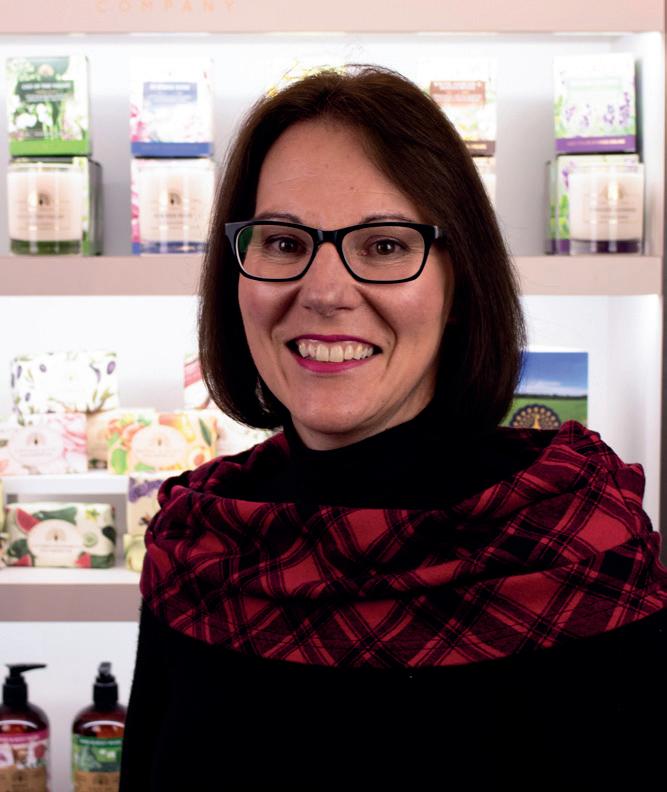







































































CATEGORIES 2026



Business Growth Award


























Businesswoman of the Year









































MD of the Year








Company of the Year
Employer of the Year
Gamechanger of the Year








Inspirational Award
Large Business of the Year (£2m+)




Medium Business of the Year (£500k-£2m)













Small Business of the Year (-£500k)










Future Talent of the Year
Best New Business Award









Professional Services Award





Property Professional of the Year


Women in Tech Award
Best Customer Service Award





























At Dynamic, we have always believed that women in business don’t just drive change, they are the change. Every award we give, every story we tell, and every entrepreneur we celebrate reflects our mission: to champion women who are transforming industries, breaking barriers and making the world a better place.
So when new data revealed that 32% of small business funding applicants are now female founders, it felt like a moment to acknowledge real progress. For years, women-led businesses have had to work twice as hard to access capital, yet their determination and achievements have never been in doubt. The latest figures, shared by SME lender 365 Finance, show that women aren’t waiting around - they’re stepping forward and pursuing the support they deserve.




inclusive alternative that gives founders more control and faster access to capital.
BUT
Th is rise in funding applications reflects a movement across the UK. Women-led and majority-female-owned businesses now represent nearly 30% of high-growth companies, up from just 18% in 2021. From tech innovators to independent food brands, women are shaping industries with creativity, resilience and strategic brilliance.
“What’s striking, though, is that women-led companies are outperforming their male counterparts in turnover growth - 24.6% compared to 21.6%.”
Part of the reason is the growth of more flexible funding models such as revenue-based finance. Rather than relying on traditional collateral or credit history, this approach focuses on a business’s performance and potential. It’s an
Yet, despite this progress, the financial gap remains shockingly wide today. The Gender Index Report 2025 found that only 14.2% of female-led businesses secured debt finance last year, compared with 61.1% of maleled fi rms. The figures highlight an imbalance that continues to hold back innovation and growth. What’s striking, though, is that women-led companies are outperforming their male counterparts in turnover growth - 24.6% compared to 21.6%. The message is clear: when women get access to funding, they deliver.











At Dynamic, we hear these stories daily. Women running thriving companies who still struggle to access the investment they need to scale. Entrepreneurs who’ve built remarkable brands with limited resources. It’s this persistence, this unwavering belief in possibility, that defines a generation of female founders and motivates us every day. Initiatives like 365 Finance’s #SheLeads campaign are helping bring those stories to light, too.
Hannah Hunt, Digital Marketing Manager at 365 Finance, says the project’s strength lies in giving women a platform. “With less than 2% of venture capital funding going to women, visibility and representation are more important than ever,” she explains. “These founders are reshaping industries and showing what’s possible when women are given the support to lead.”
Visibility is powerful, we know. We have seen the power of this through our magazine and the Dynamic Awards. It creates connection and community, reminding women everywhere that they’re not alone. When one founder shares her journey, it sparks something in another—confidence, courage, maybe even the fi rst steps of a new venture.
What’s developing through all of this is something that can’t
be quantified by data alone: a collective strength. Women in business are connecting, collaborating and lifting each other higher. We see this all the time. Thanks to remarkable networks such as City Girl Network and campaigns such as #SheLeads, as well as many grassroots movements, which are creating spaces where success is shared, celebrated, and sustained.
These communities can inspire and lend comfort when needed. Remind women who are working to achieve their ambitions that they are not alone and that progress is not always loud and seldom easy. Sometimes it’s found in the quiet resilience of a founder who keeps going, the supportive word from a mentor, or the recognition that her story matters.
At Dynamic, we’ll keep championing these stories—not because they’re exceptional, but because they should be ordinary. Access to funding should not depend on gender, and opportunity should not be a privilege.
The rise in female founders seeking funding is not just encouraging; it’s a glimpse of what’s possible when women are supported and believed in. Th is is not the end of the conversation, but the continuation of something which is far bigger.
In our exclusive Spotlight feature, we highlight women who are doing good things in their community. They’re not always seen but we think they should be.
Stella from Woodfire was a finalist in the Sustainability Champion award category at the Dynamic Awards this year
Istudied English Literature at University, assuming I’d do something professional, but I wasn’t sure what. Some temp work led to a job in children’s publishing, and I spent the next 15 years as an editor and writer, freelancing after having children and working for most of the major publishing houses.
I loved the job and the buzz of London; getting dressed up for the office, coffee on the way in on the tube, working with authors and illustrators, meeting friends for drinks after. But increasingly it felt superficial and aimless; I became appalled by the consumerism of city life while helpless to do much about it.
My husband, Griff, also felt we were going in the wrong direction. We’d always loved camping and, in the past, had idly said we’d love to run a campsite, but now, with a desire to change our impact and help others do the same, we started discussing the idea seriously.


“We
now have three sites and are consistently included in the national press round-ups of the best campsites in the UK”
We were both townies and completely naïve about what it involved, but we knew exactly the experience we wanted to create: somewhere that allowed guests to exist simply in nature and with barely any impact; somewhere beautiful and welcoming where they could stop, rest and recover, connecting with themselves and others. Griff had always loved cooking. We knew we wanted food, generosity and a sense of sharing and community to be part of our offering, coining the term ‘gastro-camping’.
Finding land—our first site was Woodfire at Westerlands, in West Sussex —and setting up are other stories, but we worked extremely closely with the South Downs National Park (SDNP) to ensure every element was completely in keeping with their stringent conditions. It felt so good to know we were striking exactly the right – but fine - balance between conserving, even enhancing the site, while also being able to welcome visitors to share its glories.
Achieving this balance is our constant goal, and I am so proud of what we have created. We now have three sites and are consistently included in the national press roundups of the best campsites in the UK, while our food has featured in the Telegraph, BBC Good Food and Time Out.
We achieved a Gold Award from Green Tourism and the SDNP for our sustainability and – best of all - have had so many regular campers telling us that Woodfire is their happy place. It’s mine, too.
www.woodfire.co.uk
Susan is the founder and owner of Timeless Toys in Hove, started after experiencing exasperation at a lack of sustainable toys
I started Timeless Toys in 2019, opening on the west side of Brighton, in Hove (actually!) on a community high street. Apparently, Brighton & Hove has a lot of toy shops compared to other cities. However, that didn’t help me or my frustrations when shopping for my newborn son and seeking greener and plastic-free alternatives without the greenwashing.
Anyone living with children will have experienced how unwanted plastic can soon become a constant, invasive part of family life. So, when my position in London and my twohour daily commute became untenable, I made the decision to start Timeless Toys with the intention of making it effortless for families to find sustainable and plastic-free baby and children’s items on the high street.
When we first opened, our shelves held just 13 sustainable toy brands, with toys crafted from five types of eco-friendly materials. Fast forward seven years, and the shop now stocks 72 sustainable children’s brands in-store, with ranges made from 24 different eco-friendly materials —including some that would surprise you, like toys made from rice or cereal! We’ve grown beyond toys too - expanding into clothes, books, kids’ accessories and baby essentials.
My own journey has shaped Timeless Toys. I studied Earth Science at University, later qualifying as a geography teacher, before moving into the charity sector, where I specialised in marketing and undertook a Postgraduate Certificate in Behavioural Change Marketing.

One of my favourite parts of running Timeless Toys is championing those leading the change and helping to move a sector beyond being the most plastic-intensive industry globally, with 90% of toys still made of plastic, and unrecyclable.
“My continued survival through some of the most challenging years in retail shows me that customers value our uniqueness and quality focus.”
Looking back, opening Timeless Toys feels like I have come full circle: blending my background in science, education and social change into a business rooted in an environmental and educational purpose. I’ve even found myself back in the classroom, delivering hands-on lessons on what toys are made from and how they’re made, as part of science and environmental curricula in schools.

My continued survival through some of the most challenging years in retail shows me that customers value our uniqueness and quality focus. With children’s items, they can feel good about buying and trust in my integrity. I’m hopeful that sustainability in toys will move from niche to norm, with independent shops like mine playing a key role in driving that shift—by curating responsibly, educating customers, and proving that quality and ethics can sit at the heart of modern retail.
What keeps me motivated is knowing that every product we choose, every conversation we have, and every child we inspire to think differently about how they shop, adds up to something larger.
Timeless Toys began as a response to my own frustration, but it’s become part of a much wider movement to rethink what play - and progress - can look like.
www.timeless-toys.co.uk

The way power moves between government and business is changing. The long-running Advisory Committee on Business Appointments, better known as ACOBA, has been shut down and its work handed to a new Ethics and Integrity Commission, alongside tighter rules on how former ministers and senior civil servants take up private-sector jobs.

At fi rst glance this might sound like a dry bit of political housekeeping. But for women in business and leadership, it could have far-reaching effects. It’s about who gets access to senior roles, how influence flows between public and private life, and what counts as ethical behaviour at the top.
WHAT’S
Commission now reviews appointments for senior officials, while the Prime Minister’s Independent Advisor keeps tabs on ministers. The new Ethics and Integrity Commission will sit above them, pulling together data and tracking standards across public life.
The goal is simple: rebuild public trust. Yet these changes matter for ambitious women who move between the boardroom and public service because they shape how talent is spotted, recruited, and rewarded.

ACOBA was meant to stop the “revolving door” problem where ex-officials walked straight into high-paying jobs with companies they once oversaw. It advised on waiting periods or restrictions, though critics said it lacked real teeth. The new structure is designed to make the system stricter and more transparent.
Under the fresh rules, anyone leaving a top government post will face closer scrutiny if they take a job in business soon after. The Civil Service
The revolving door has never spun evenly. Men still dominate senior political and corporate circles, and many informal networks that open doors remain closed to others. Women reaching top roles often do so through formal processes rather than old connections, meaning any reform that clarifies the system could actually work in their favour.

Transparency also matters for reputation. As Isabel Doverty, the fi nal chair of ACOBA, warned before the closure, rule changes alone won’t fi x the problem unless there’s a real cultural shift toward openness. For women stepping into leadership roles, that shift could be key. When decisions are made in the open, judging merit rather than relationships is easier.
“ACOBA was meant to stop the ‘revolving door’ problem where ex-officials walked straight into high-paying jobs with companies they once oversaw.”

At the same time, stricter ethics rules could bring new hurdles. If the

process becomes too rigid or confusing, it might discourage skilled people from moving between sectors. The challenge will be keeping rules fair without making the path into senior business roles harder to navigate.
Companies that rely on hiring experienced public-sector figures will need to plan further ahead. The new approach could mean longer waiting periods before some appointments are approved, and businesses will be expected to show that jobs were offered fairly.

currency, women’s reputations for collaboration and accountability may give them an edge in this new climate.
Ethics reform might sound like a bureaucratic detail, but it’s really about how power and opportunity are shared. With clearer standards and closer oversight, the old networks that once controlled access to influence may lose some of their grip.

For women in leadership, that could create opportunities. Businesses are already under pressure to prove their ethical credentials and commitment to diversity. A transparent recruitment process that champions integrity can help female candidates stand out for the right reasons. It’s not just about compliance; it’s about building credibility with investors and customers who care about how companies behave.
Many fi rms also realise that ethical leadership and gender balance go hand in hand. Studies show that companies with more women on boards tend to score higher on governance and sustainability. As public trust becomes a form of
For women in business, that creates a window to step forward and shape the culture of leadership itself. The system is being rewritten, and those who understand the new rules early will be better placed to take advantage.


The Advisory Committee on Business Appointments (ACOBA) was a non-departmental public body, which was set up in 1975 to provide advice on applications from the most senior Crown servants who wished to take up outside appointments after they left the Crown service. Since 1995, it also provided advice to former Ministers on their employment in the two years after leaving office. The committee, which was sponsored by the Cabinet Office, was chaired upon it dissolution on October 13th 2025, by Isabel Doverty.



Britain’s race toward a low-carbon future is no longer an abstract policy goal. It is a labour challenge, a training challenge, and a business opportunity.
The government’s new clean-energy workforce initiative, launched this October, is designed to close a widening skills gap that threatens to slow the country’s green transition. For companies and workers alike, it signals the start of a new industrial chapter built on renewable power, nuclear energy, and innovation.
Over the next decade, the UK will need hundreds of thousands of skilled technicians, engineers, and project managers to deliver on its clean-energy promises. From offshore wind farms to small modular reactors and large-scale solar installations, demand for technical expertise is growing faster than supply. The new plan includes funding for regional training hubs, partnerships with further education colleges, and investment incentives for firms willing to upskill their
workforce. It is being framed not as a social programme but as a national business strategy to keep Britain competitive.
Industry analysts estimate that renewables could support more than 500,000 jobs by 2035 if current targets are met. Yet employers across the sector already report persistent shortages of electricians, welders, and mechanical fitters. Many of these trades powered the oil and gas boom of the past generation. The government’s “just transition” strategy aims to channel that expertise into clean-energy roles, ensuring that experience is retained and communities remain employed as fossil fuel operations decline.
For business leaders, the challenge is twofold. Companies must invest in technology and infrastructure while also competing for scarce human capital. Offshore wind operators already face “talent bottlenecks” that delay projects and

push up costs. Smaller suppliers often struggle to match salaries offered by global energy firms, even though they form the backbone of the supply chain. New training partnerships may help by providing access to skilled recruits without adding to overheads.
The regional implications are significant. Many of the new training centres will be located in areas hit hardest by industrial decline, including Teesside, South Wales, and parts of Scotland. This could help rebalance economic opportunity away from London and the South East. Offshore wind manufacturing in the Humber, hydrogen projects in Grangemouth, and nuclear expansion in Somerset all represent long-term employment prospects that could revitalise local economies.
“Skills are now the currency of the clean-energy race. If Britain can build its talent base faster than its competitors, we’ll lead the market rather than chase it.”
Yet obstacles remain. Training specialists takes time and sustained funding, and some fear that demand will outpace delivery. Employers also need to manage short-term shortages while anticipating automation that may reshape future roles. Regions without existing energy infrastructure risk being left behind unless they act early to attract investment and establish training capacity.
A further challenge lies in perception. Many younger workers see trades as old-fashioned compared with technology or finance, yet those very skills are crucial to the clean-energy economy. A turbine technician now blends mechanical expertise with digital monitoring and safety analytics. Reframing such roles as high-tech, sustainable, and future-proof could help attract the next generation.
Private investment is following the policy signal. Energy developers are working with universities and local authorities to secure labour pipelines and practical training routes. Around the Humber estuary, for instance, energy firms are co-funding college programmes that teach real project skills such as turbine maintenance and offshore safety. Businesses want to make sure training reflects market demand rather than theory alone. This collaboration gives the initiative credibility and commercial momentum.

The opportunity for business is broad. As global demand for clean-energy skills rises, Britain can position itself not just as a producer of hardware but as a source of knowledge. Exporting technical expertise could become as valuable as exporting equipment. Companies that invest early in people and partnerships will gain a lasting competitive edge.
For investors and entrepreneurs, the message is clear. The green transition has moved from debate to delivery. Supply chains are being rebuilt, industries are diversifying, and public funding is creating fertile ground for innovation. Whether in materials science, data analytics, or workforce training, opportunities are opening for firms that think beyond short-term profit.
If the government’s plan succeeds, the payoff will be immense. A stronger skills base will speed up the rollout of renewable projects, attract global capital, and reduce dependence on imported energy. More importantly, it could give Britain renewed confidence in its industrial identity. The clean-energy revolution is not only about meeting climate targets. It is about building a workforce and an economy ready for the decades ahead.
• 500,000 potential renewable-energy jobs by 2035
• 60% of employers report difficulty hiring technical staff
• £150 million pledged for training and regional hubs
• Offshore wind capacity set to triple by 2030
Asecret trade is thriving in plain sight. On TikTok and Facebook, amid fitness reels and diet tips, sellers are offering unlicensed injections that promise dramatic weight loss. What they don’t say is that some of these products could kill you.
That chilling reality sits at the heart of the Channel 4 News investigation, Inside the Black Market for Illegal Weight Loss Jabs, which uncovers how counterfeit drugs are being sold online with alarming ease. The programme’s undercover reporter posed as a buyer and was able to purchase a fake version of retatrutide - a drug still in clinical trials and not approved for public use.
The seller offered confused dosing advice, kept the vials at the wrong temperature, and never asked basic medical questions such as weight, pregnancy status, or health history. No prescription, no screening, no oversight – just a bank transfer and a package through the post.
Retatrutide, developed by pharmaceutical company Eli Lilly, has shown extraordinary results in early studies, with participants losing almost a quarter of their body weight. But this success has fuelled a dangerous underground trade. Counterfeit versions are now circulating on social media, preying on people desperate for rapid results.
Dr Nancy Allen, an NHS GP who prescribes licensed weight-loss treatments, reviewed one of the fake products obtained by Channel 4. “I’m a prescriber, and I have never seen it in my life,” she said. “This raises serious concerns about patient safety.”
Those concerns are far from theoretical. The Medicines and Healthcare products Regulatory Agency (MHRA) confirmed that selling fake retatrutide is illegal and warned

“What Channel 4’s investigation shows, more starkly than ever, is how blurred the line between medical innovation and online exploitation has become.”
that such products may contain incorrect doses or toxic ingredients. Their message was blunt: people are putting their health – and possibly their lives – in danger.
The human toll of this new trade is already visible. Former Big Brother star Aisleyne Horgan-Wallace told Channel 4 she bought a copy of another weight-loss jab through TikTok and ended up fearing for her life. “It was the worst time of my life physically,” she said. “I genuinely thought I was going to go blind or die.”
Others are taking the same risk. Champion bodybuilder Richie O’Donnell admitted he had seen teenagers using fake jabs and had even bought some himself “in case he needed it.” Gym-goer Marcus Perry confessed: “You don’t know what you’re putting in your body … but it’s the chance you’ve got to take.”
Politicians and regulators have reacted with outrage. Dr Beccy Cooper, Labour MP and member of the Health and Social Care Committee, called the illegal sales “appalling” and said the trade “needs to be shut down.”
Eli Lilly, the company behind the real retatrutide, told Channel 4 it is now taking action against Synedica and Alluvi, two distributors named in the investigation as sources of counterfeit drugs. “Any product falsely representing itself as a Lilly investigational product may expose patients to serious health risks,” a spokesperson said.
“We are taking action to identify and remove fraudulent or unsafe content online.” Synedica’s website, which Channel 4 examined, claims its products are “not for human consumption” – yet they are readily available to consumers. The company did not respond to Channel 4’s requests for comment.

The investigation has also forced action from social media giants. TikTok and Meta (which owns Facebook, Instagram and WhatsApp) removed content flagged by Channel 4, and TikTok has since banned searches and hashtags linked to retatrutide. Both companies reiterated that selling weightloss jabs breaches their policies, but enforcement remains inconsistent, with new sellers appearing almost as quickly as old ones are shut down.
The exposé has wider implications too. Experts have warned for months about a “wild west” culture around weight-loss injections, with copycat and illegally promoted products flooding digital marketplaces. Demand is soaring, driven by the success of approved drugs such as Wegovy and Mounjaro, and opportunists are exploiting that hunger for quick fixes.
What Channel 4’s investigation shows, more starkly than ever, is how blurred the line between medical innovation and online exploitation has become. In the rush for a thinner body, unregulated sellers are trading in fear and fantasy – while users gamble with their health.
It’s easy to scroll past a post that promises miracle results, but behind every syringe lies an untested, unverified substance that could cause lasting harm. This isn’t just a story about vanity or viral trends; it’s a story about risk, responsibility, and the very real consequences of a marketplace that values profit over people.
As Inside the Black Market for Illegal Weight Loss Jabs airs on Channel 4 and streams on YouTube, one message is clear: if something promises life-changing results with no questions asked, it might cost you more than you ever expected.
My first reaction was No! Never! But Google image searches prompted further exploration.
By Tess de Klerk
Over the past few years, polynucleotides have been hailed as the next generation of skin rejuvenation treatments, promising glowing, hydrated and more youthful-looking skin without the volume or ‘fi ller’ look associated with older injectables. But what exactly are polynucleotides, where do they come from, and are they safe and effective?
WHAT ARE POLYNUCLEOTIDES?
Polynucleotides are long chains of nucleotides, the natural building blocks of DNA and RNA. These molecules are found in every living cell and play an important role in repairing and regenerating tissue. In cosmetic treatments, polynucleotides are used to stimulate the skin’s own healing processes. When injected, they help to repair damaged cells, improve elasticity and encourage hydration by boosting the skin’s natural production of collagen and elastin.
or body, while others target different concerns such as hydration, elasticity or fine lines. Well-known brands include Plinest, Nucleofi ll and Rejuran, among others. Each brand may vary in concentration, viscosity and the exact molecular weight of the polynucleotides used. These differences can influence how deeply they are injected and how they perform.
As with any aesthetic product, quality matters. Reputable, CE or UKCA-marked polynucleotide products are carefully manufactured and tested for purity.
A typical polynucleotide treatment involves small injections into the skin using a fi ne needle or cannula. The procedure is relatively quick and usually well tolerated, with minimal downtime. Some redness or swelling can occur.
Unlike dermal fi llers, the effects of polynucleotides develop gradually. Most people say they noticed improvements in texture, hydration and tone over several weeks after the treatment. A course of two to three sessions spaced a few weeks apart is usually recommended, followed by maintenance treatments every few months.

The versions used in aesthetic medicine are typically derived from highly purified salmon or trout DNA. Although the idea of fish DNA might sound less than kosher, the material undergoes rigorous purification to ensure safety and biocompatibility.

Fish DNA is surprisingly similar to human DNA in structure, and when it’s purified to medical-grade standards, it becomes biocompatible and, this is key, non-immunogenic, meaning the body doesn’t react to it as a foreign substance. Once processed, the polynucleotides act as a ‘biostimulator’ rather than a fi ller, meaning they work with your body’s own cells to rejuvenate the skin from within.
MEDICAL BACKGROUND
Polynucleotides are not new to medicine. They have been used for decades in medical fields such as ophthalmology, where they help to heal and regenerate delicate eye tissues, and in wound healing in general. Their long record in promoting repair and reducing infl ammation made them a natural next step for use in aesthetic medicine.
TYPES AND BRANDS
There are several types of polynucleotide treatments on the market. Some are formulated for specific areas of the face
























“Rather than structure, polynucleotides skin quality

The results are subtle yet noticeable. Rather than changing facial structure, polynucleotides enhance skin quality and radiance, making them a good option for those who prefer a natural look.
Polynucleotide treatments are generally considered safe when administered by trained medical professionals. Because the ingredients are highly purified and biocompatible, allergic reactions are rare. However, as with any injectable, there are potential risks such as bruising, swelling or infection if not carried out properly.
However, there are some people who should avoid them. Those who are pregnant or breastfeeding, have active skin infections, or known sensitivities to fish-derived products should not undergo treatment. Anyone with autoimmune conditions or certain chronic illnesses should consult their doctor fi rst. Vegans and vegetarians may prefer to avoid them due to the very nature of what they are.
Unlike hyaluronic acid fi llers, polynucleotides are not dissolvable with an enzyme such as hyaluronidase. Th is is because they are not designed to fi ll or volumise but to be absorbed and metabolised naturally by the body over time. The material breaks down gradually, leaving behind improved skin structure and tone rather than a foreign substance.
While polynucleotides have a long record in medical use, their application in aesthetic medicine is still relatively recent. So far, studies and clinical experience suggest that they are both safe and effective. They do not create long-term distortion or migration as can occasionally happen with fi llers. Instead, they offer a regenerative approach that supports the skin’s own biology.



They are suitable for most skin types and ages, particularly for those looking to improve dullness, fine lines or loss of elasticity. They can also treat delicate areas like under the eyes, where traditional fillers may not be suitable.

While more long-term research will no doubt continue, their established medical background and efficacy makes for an interesting addition to modern skincare.
than changing facial polynucleotides enhance quality and radiance”


By Kellie Miller
“Lesley’s works examine the relationships between the natural landscape and ancient, abandoned stone structures transformed over time” of
There are multiple, concurrent truths evident in Lesley McInally’s works. While she is expressing and producing beauty and nature within her art, there are underlying themes of fragility, anxiety, death and grief.



Many artists have paradoxes in their works, which critically shape how we consume art. These should be embraced and not shied away from, as they are all part of our existence. One of the principal values of art is to gain a deeper understanding of ourselves and the human condition by posing a question: how can we recognise pure joy if we have no comprehension of loss?











Lesley’s ceramics are inspired by Expressionism, a telling influence. It is a modern movement originating in Germany at the beginning of the 20th century. The goal of Expressionist artists was to project a subjective perspective of their subject while evoking an emotional response.










The most notable artists that spring to mind when viewing her works are Edvard Munch and Vincent van Gogh, with their colourful, fragmented skies, dramatic seascapes and landscapes. Particularly, Munch’s ‘The Scream’ and ‘Anxiety’ paintings. Also, Van Gogh’s ‘Starry Night’ and ‘The Red Vineyard’ — the latter being the only painting of his which sold during his lifetime. Both of those artists’ lives were overshadowed by mental illness or the fear of it.


Munch’s works are more poignant in their portrayal of human states of heartbreak, sorrow, despair, and


depression, whereas Van Gogh’s work depicts more optimistic and uplifting scenes. Could this be his way of projecting hope and positivity to fi nd peace within himself and to give happiness to others?
In contrast, Lesley’s works examine the relationships between the natural landscape and ancient, abandoned stone structures transformed over time by the elements and by generations of human contact and interaction. With each landscape series, she captures a deep emotional response to time, erosion, seasons and prose. With a strong use of colour and an emphasis on surface textures, she aims to evoke dramatic seascapes, landscapes, and sunsets.
“I have often experienced my surrounding landscapes as an orchestral concert for the eyes. Each piece tells its own story and often takes the viewer on a nostalgic journey where one’s senses and dreams cohere.”
Another significant feature of her pieces is the inclusion of a red dot. The red dot can symbolise blood. Like blood, it is life-sustaining and the flow of life. It is linked to the family ties and heritage. What started as a focal point for her work has evolved to have a much deeper meaning. She now considers this to be her maker’s mark/signature.
Lesley’s work employs numerous layers, each imbued with messages. Some of these will be about the challenges we will inevitably encounter, whereas others will be about beauty, optimism, and hope - such are the contradictions we hold within us all. Together with the vessel nature of her pieces, she ponders how they will be held and fi lled— questions we confront throughout our lives.
Lesley is an international award-winning artist living in Canada. Her works can be seen at Kellie Miller Arts, Brighton.

Decisions That Matter by Fay Niewiadomski. The Traps of Decision-Making Bias: overconfidence, information overload, cognitive preferences and risk orientation. Four pre-emptive measures: define, defend, deploy and defy.
Like sailing in a particular season, decisions are made in a specific context and time frame. Our instruments provide data, but the environment is dynamic – external factors enter and alter the context. Nevertheless, we still have to decide how to get to our destination and with decisions come the inescapable traps of our biases.
Here are the four major traps of decision-making biases and how to recognise them:

1. Overconfidence: You are an expert. You have knowledge and well-established ideas. You have been there, done that and succeeded in the past. Moreover, you are the leader and may assume that you know best and should lead the way. Red flag: You lead the charge as your team hangs back! You feel alone.
2. Information overload: You have mountains of data, multiple reports, minutes of meetings, stacks of slide
DECISIONMAKING IN BUSINESS AND PERSONAL
By Hassan Qudrat-Ullah. Palgrave Macmillan /
Springer (2025)
A comprehensive, interdisciplinary textbook and practitioner guide showing how cognitive psychology, behavioural economics and systems thinking combine to shape decisions in individuals, teams and organisations. Qudrat-Ullah maps common cognitive traps and offers structured tools, from scenario forecasting to risk and contingency planning, plus team decision interventions and real-world cases that help leaders make defensible, repeatable decisions under uncertainty. Practical exercises and downloadable chapters support classroom and boardroom use.

decks, conflicting opinions and recommendations to review. Plus, pressure from stakeholders with different priorities and deadlines. Red flag: You narrow your focus, select fewer alternatives and “trust your gut”! You feel uneasy.
3. Cognitive preferences: We have preferred thinking and decision-making styles. Some focus on the details and slow down. Others focus on the big picture and speed up. Internally referenced people
THE PURPOSEFUL DECISION MAKER: A GUIDE TO MAKING GREAT DECISIONS IN LIFE AND BUSINESS
By Pádraig Ó Céidigh. Amplify Publishing (2024)
Written by an experienced entrepreneur, this practical guide mixes personal stories with clear frameworks to help leaders make value-aligned, strategic decisions. Ó Céidigh introduces the “safe-harbour” idea — using core values, people and purpose as an anchor — then explains analytic tools to surface hidden biases, anticipate unintended consequences, and structure group decision processes so choices remain consistent, resilient and purposeful. Short, actionable chapters aimed at entrepreneurs and executives


decide based on personal principles and beliefs. Externally referenced colleagues focus on the pragmatics of cost-benefit analysis. Red flag: Are you stereotyped as Deliberate and Determined or Impulsive and Opportunistic? You feel misunderstood.
4. Risk orientation: Are you optimistic or risk-conscious about the outcome of your decisions? Is the half-empty or the half-full glass your default? Are you willing to

take hard decisions and push back? Or, do you prefer to conform to corporate and social expectations? Red flag: Are you seen as the Conservative Critic or the Exuberant Optimist? You feel puzzled. Why don’t they see what I see?
So what can you do about the traps of decision-making biases? Here are four pre-emptive measures:
1. Define - decision types as routine and recurrent, reversible and
BREAKING BIAS: WHERE STEREOTYPES AND PREJUDICES COME FROM AND THE SCIENCE-BACKED METHOD TO UNRAVEL THEM
By Anu Gupta (foreword by the Dalai Lama).
Hay House (2024)
Blending neuroscience, mindfulness and practical toolkits, Anu Gupta offers a step-by-step method (the PRISM toolkit) to identify, unlearn and replace personal and organisational biases. Written for leaders and HR/professional audiences, it maps how identity-related biases shape decisions and gives concrete exercises to reduce biased judgments in hiring, performance management and policy choices - aiming to boost inclusion and better business outcomes.
fixable, consequential and irreversible. Apply fast, medium and slow decision-speeds accordingly. Look behind you, is your team with you or not? Hubris (overconfidence) has been the downfall of many a hero.
2. Defend - Your non-negotiable ethical principles. Develop pre-prepared, practical, assertive responses and actions to protect your personal integrity. Consult those whose integrity you admire.
3. Deploy - a cognitively diverse team with whom to consult. Select one or two people who think and work differently from you and have them as your MasterMind Team. Remind yourself that superheroes are fictional characters.
4. Defy - learn to say “No!” without guilt. Also develop ways of saying “No” without actually vocalizing the words. Your non-verbal cues are a formidable way of communicating who you are. You do not want to be bullied into unjustified risks.
In all cases, listen more intently and have those difficult conversations you have been postponing.
Fay Niewiadomski is an award-winning change management strategist, leadership coach and the author of Decisions That Matter.

MACHINE: WHY BIG SYSTEMS MAKE TERRIBLE DECISIONS
By Dan Davies. Profile Books (2024)
A sharp analysis of how modern institutions and systems outsource decisions to processes, rules and opaque algorithms, creating “accountability sinks” where no one owns outcomes. Davies traces the historical and managerial drivers of industrial-scale decision automation and shows how diffused responsibility produces perverse outcomes in markets, governments and firms. He critiques prevailing management orthodoxies and offers conceptual fixes to restore clearer accountability and feedback. Accessible, polemical and evidence-based.
By Tess de Klerk

London is one of the world’s most popular cities for tourists, drawing millions of visitors every year. Its history, architecture and endless things to do make it irresistible. Yet, for those of us lucky enough to have such easy access, it’s easy to forget just how extraordinary the city is. We might default to the usual routines - an
evening in the West End followed by dinner at a great restaurant - but that doesn’t do our capital city justice. Beyond the famous landmarks and crowded attractions you’ll fi nd many interesting places and experiences that even locals may have never heard of. Here are 15 hidden treasures to remind you of just how cool London is.


Tucked near Marble Arch, Frameless redefines how we experience art. Instead of simply viewing masterpieces on walls, you step inside them. Th rough projections, music and movement, you’re surrounded by the works of Van Gogh, Monet and Klimt in vast rooms that feel alive. It’s an unforgettable blend of technology and creativity that stirs every sense.

Hidden on a quiet Chelsea street, John Sandoe Books is the kind of shop every book lover dreams about. Its narrow wooden staircases and overflowing shelves create an atmosphere of discovery. The staff know every corner and can recommend gems you won’t find on bestseller lists. It’s literary London at its most authentic.


High above the ground in Kew Gardens, the Treetop Walkway offers a bird’s-eye view of one of London’s greenest corners. Rising 18 metres into the air, it lets visitors wander through the leafy canopy, listening to birdsong and the rustle of branches. The steel structure gently sways, giving a sense of floating among the trees.






Rumoured to be London’s oldest wine bar, Gordon’s feels like stepping into another century. Candlelight fl ickers against stone walls and low ceilings, creating a cosy, cave-like setting beneath Embankment. The extensive wine list, paired with generous cheese platters, makes it a perfect hideaway after a walk along the Thames. Time seems to stand still here.
For something truly unusual, join the Hunt for the Cheshire Cat, an immersive treasure-hunt-style experience through London’s streets. Inspired by Alice in Wonderland, it mixes storytelling, puzzles and performance. Participants uncover clues in hidden corners of Covent Garden and beyond, discovering quirky parts of the city while meeting colourful characters along the way.


Beneath the Freemasons Arms in Covent Garden lies one of London’s most unexpected relics: an original skittle alley from the 18th century. Long before bowling lanes became common, skittles was the game of choice. The alley is still playable and can be booked for private groups, offering a rare glimpse of Georgian-era entertainment.

Few know that behind Westminster Abbey a tranquil community space called the Onion Garden. Filled with herbs, wildflowers and fruit trees, it’s a haven for bees and butterfl ies. Volunteers tend the garden, which celebrates sustainable urban planting. It’s a surprisingly peaceful spot just moments from the political bustle of Parliament Square.

orchids.
Tucked within the Wallace Collection near Marylebone, the conservatory is an elegant glass-roofed space perfect for a quintessential afternoon tea. Guests can enjoy delicate sandwiches, scones and cakes surrounded by art and natural light. The Wallace Collection itself is a masterpiece of art and design, but the tea experience feels like a
all its own.




of London’s most unexpected green spaces within the concrete heart of the Barbican. Conservatory houses over 1,500 species tropical plants, including palms, ferns and orchids. Water features and koi ponds add to the atmosphere. It’s free to visit and feels like escaping to a secret rainforest in the middle of City.


The Electric Cinema is one of the oldest working cinemas in Britain, but its charm lies in its luxurious comfort. Instead of ordinary seats, there are plush leather armchairs, footstools and even beds in the front row. With lamps at each seat and cocktails available from the bar, it’s the most stylish way to watch a fi lm in London.

Beneath the streets of Clerkenwell lies a fascinating slice of London’s history. The Postal Museum tells the story of the city’s communication networks, from Victorian mail coaches to wartime innovations. The highlight is the Mail Rail, a miniature underground train once used to move letters around London. Now visitors can ride it themselves, through tunnels that few ever knew existed.



Established in 1798, Rules in Covent Garden is officially London’s oldest restaurant. Its plush red interiors, portraits and velvet curtains ooze history. The menu focuses on classic British dishes such as roast grouse, steak and kidney pie and sticky toffee pudding. Dining here feels like stepping back in time, with impeccable service and old-fashioned charm to match.
One of London’s newest and highest free viewing platforms, Horizon 22 sits atop 22 Bishopsgate in the City. At 254 metres high, it offers unmatched views across London’s skyline, from the Shard to St Paul’s Cathedral. Entry is free, but booking is essential. Whether by day or at sunset, the view is breathtaking.
Tucked away within Hampstead Heath, Golders Hill Park hides a small but delightful zoo. It’s free to visit and home to lemurs, deer, exotic birds and ring-tailed coatis. Families love it for its informal charm, while nearby flower gardens and ponds add to the sense of serenity. It’s a charming surprise within one of London’s most beautiful parks. lies Onion ies.


Following the path of a disused railway line, Parkland Walk runs between Finsbury Park and Alexandra Palace. It’s London’s longest nature reserve and a favourite among walkers and cyclists. Along the way, ivy-covered bridges, graffiti art and even a hidden sculpture of a mythical creature appear. It’s a wild green corridor connecting urban north London with tranquillity.



By Fiona Shafer, Managing Director of MDHUB
Aptly named after a village in the Catalan Pyrenees, home to a unique hydroelectric power plant built deep inside a mountain, which has inspired both the technology and the sculpted, sharp, futuristic style vehicle design.
My heart sank slightly when I read on Cupra’s official website that driving a Cupra was going to be an “emotional experience.” Sadly, it would not be the fi rst time during the review that I felt the whole experience said more about Cupra as a brand than about the overall experience for the most important person in the room – the driver, especially as this particular model does not come cheap.

With a starting price of £47,350 and a top entry level of £62,180, the Tavascan V2 sits midway at £53,782.00. Please don’t forget that brand-new EVs over £40,000 also come with an additional £425 a year in vehicle tax. Add in the fact that the prices are without the Winter Pack option if you want heated seats, a heated windscreen, and a heat pump, which at £1,335.00 I hope would come as standard, you can see why it is pricey.
Perusing the 35-page technical specification was akin to looking out for the hidden extras on an easyJet fl ight, so be careful to read it before purchasing. It is a cleverly written piece of marketing that throws in big warranties at the end – including a five-year manufacturing warranty, three-year paint warranty, an eight-year battery warranty or 100,000 miles (whichever comes fi rst), a 12-year body protection warranty, a 24-month Cupra parts warranty and finally, Cupra roadside assistance including European cover. But would you keep it that long?
If you are a hardcore fan of futuristic sci-fi movies, you will likely love the look and feel of this car and derive immense pleasure just from sitting in it, even if you don’t actually drive anywhere.
‘Cupra’ means ‘copper’ and the colour flows through the

car design from its insignia, to the dashboard, to the door handles, right to the twinkly star lights in the door panel. There is an array of ambient lighting colours that you can change and super comfy sports seats – see, I told you – you would not want to go anywhere. But the quality of all the trims is really quite poor, and I worried about marking and breakages, especially on the interior door handles, which look rather fl imsy, and the cupholders, which look made for Pyrenean mountain elves.
The infotainment screen is huge and looks disproportionate to both the dashboard and the cockpit dials. Once again, it felt like more style over substance, and you had to hunt around for anything remotely useful. I was, though, intrigued to try out the AI assistant called IDA (a name with Germanic origin, referring to hard-working women), and even that was underwhelming. Despite using my best dictation to ask IDA, ‘how far is it from Haywards Heath to London?’, the reply was – ‘I have not learnt that yet!’ Alternatively, IDA’s default was, ‘Cupra is made in Spain,’ which is not entirely accurate as the Tavascan is actually made in China. IDA and I did not speak for the rest of the journey….
TECH STUFF

Model tested: Cupra Tavascan V2
Power: 286 PS
Speed: 0-62 - 5.5 secs
Top: 111 mph
Range: 299-353 miles
Price from: £53,845


“There is an array of ambient lighting colours that you can change and super comfy sports seats ”
The buttons on the steering wheel were also disappointing from a functionality perspective: you had to press them very hard to make anything happen, which I have never experienced before in any car I have driven, and it looked like this was a key area where expense had been unnecessarily spared.
It transpired that one of the most useful parts of the interior was a ‘Wild Animal’ warning sign, hugely useful to me as I live in an area dangerously overpopulated by deer, and the car picked up on all of the ‘hot spots’, which was pretty impressive.
So how does it drive? The Tavascan is stealth-like and is beautifully and seamlessly quick. It will reach 0.60 mph in 5.5–6.8 seconds. The brakes take a little getting used to as there is a slight delay before they bite – it’s not dangerous, and to reassure anyone thinking of buying one, you will be pleased to know that the Tavascan has a 5-Star rating in the Euro NCAP safety rating table.



6.5 /10


• It’s an electric SUV with a sporty edge, and the design will turn heads
• Battery range 299 – 353 miles (depending on which battery you choose)
• A lot of good leasing deals around on it at the moment, and it’s worth a try.
• It’s an expensive and contrary car.
• Build quality looks a bit naff – you might want to check out the nearest competitors – Audio Q4 e-tron and the Skoda Enyaq
• No rear pockets on the back seats, plus the back of the front seats are really hard on the knees.
• Very dark in the back of the car unless you get a Panoramic roof fitted – yet more expense.

GUILDFORD ADAMS-SWEETING LECTURE
BY DAME WENDY HALL
An academic lecture delivered at the University of Surrey featuring Dame Wendy Hall, covering current topics in computing, AI and digital futures.
Rik Medlik Building, University of Surrey November 12th
www.eventbrite.com/e/adams-sweeting-lecture-by-damewendy-hall-tickets-1589842524789
BRIGHTON BRIGHTON BUSINESS EVENT – EMPLOYMENT LAW & HEALTH & SAFETY SEMINAR
A half-day seminar offering updates on employment law and health & safety obligations, intended for business owners, HR and operations staff; gives practical guidance and riskmanagement tools.
Brighton & Hove Albion Superstore, Falmer November 5th
www.eventbrite.co.uk/e/brighton-business-event-expression-ofinterest-tickets-1728246595089


WOKING
WEST SURREY FAMILY HISTORY FAIR
A gathering for genealogists and history buff s offering local family history societies, expert talks, genealogy stalls, record help, and networking with fellow researchers. A full day event to dig into heritage and ancestral connections.
Woking Leisure Centre, Surrey November 8th
www.one-name.org/mc-events/west-surrey-familyhistory-society-fair-saturday-8-november-2025/

GUILDFORD SURREY HILLS HALF MARATHON
A scenic half-marathon route through the Surrey Hills and countryside, guided and open to various fitness levels. Runners experience beautiful landscapes and local landmarks along the route.
Surrey Hills nr Guildford November 30th
https://findarace.com/events/surrey-hills-half-marathon

NR HORSHAM LEONARDSLEE COMEDY CLUB
A relaxed, intimate stand-up comedy evening held outdoors in garden surroundings. Local and touring acts perform in a unique setting, good for friends, couples or anyone wanting a lighter evening out.
Leonardslee Lakes & Gardens, Lower Beeding, Horsham, West Sussex November 7th www.leonardsleegardens.co.uk/all-events/ leonardslee-comedy-club-


HERSTMONCEUX WINTER COMETS AND CURRY AT THE OBSERVATORY SPACE CENTRE
Join an informal but informative evening with a guest speaker, warming curry (vegetarian or meat), then head outside to try and spot meteors from the Leonids & Taurids showers. If weather permits you’ll also look through historic large telescopes; if not, there’s a tour and exclusive dome tour instead. Adults only.
Herstmonceux Castle Estate, The Observatory Science Centre, East Sussex BN27 1RN November 15th www.the-observatory.org/events/winter-comets-and-curry


A large business show with exhibition stands, networking opportunities and local enterprise exhibits. Designed to help businesses connect, promote services and engage with the wider Surrey business community.
Hilton, Woking, Surrey November 7th www.wokingchamber.org.uk/events/ 2025-11-07-woking-means-business-2025

MIDHURST MIDHURST JAZZ, BLUES & FOOD FESTIVAL
A newly-launched festival combining live jazz/blues performances, food stalls, local culture. Spread across venues in Midhurst.
Midhurst, West Sussex November 14th-16th midhurstjazzandblues.com






